The Oaks - La Corniche



The Oaks - La Corniche
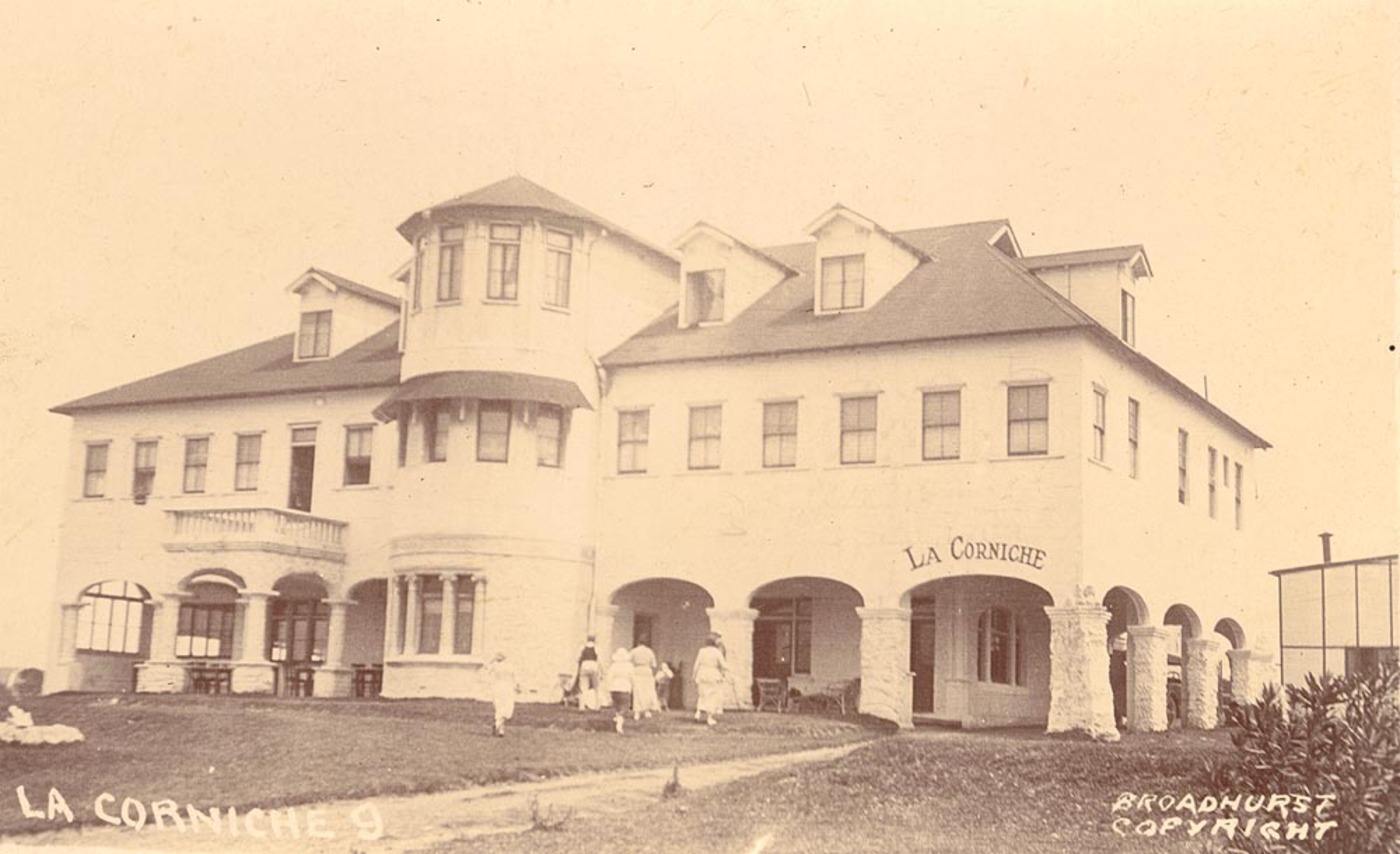
The mansion built at Mona Vale by George Brock which he commenced in 1894 and sent this poor man broke, became known as 'Brock's Folly'. The gentleman himself called it 'The Oaks'. It overlooked what was called then Bongin Bongin ('lots of shells') beach, now known as Mona Vale beach. Frequented by many who travelled specifically here (The Allen Family and father of PG Taylor) the expense incurred at building such a lavish structure did not attract the clientele he needed to ensure success.
PARADISE WITHIN EASY HAIL.
They say that 'the cobbler's always the worst shod.' Certainly the residents of the crowded city greatly neglect the marvellous opportunities at their very door to spend a pleasant holiday at the minimum of expense. Why go to the far-off mountains, with its scorching days, hot winds, and high fares, solely on account of the cool nights, or take the long journey down the coast to meet with all sorts of inconvenience, when by taking the 9.15 a.m. Manly boat, you have waiting for you well-appointed four-horse coaches to carry
you on to the lake country par excellence of Australia. The placid reaches of Pitt Water are at the present time alive with all the delicate fish that swim in the southern waters, with fine, large, luscious prawns at the entrances of the lagoons.
For an excursion, take a boat in the early morning from Mermaid Basin, on the ocean side, now teeming with schnapper and other large fish travelling up the coast ; or scamper over the long stretching beaches from Narrabeen to Barrenjoey on the panics, so easily obtained locally. Or, for quiet picnicking, go up . the shallow, .clear sandy creeks on the Kuringai Chase, with its magnificent waterfalls, ferns, palms, and luxuriant foliage, not to be equalled by the far-off, highly-praised New Zealand Sounds ; or, further afield, travelling by sail or launch to the entrance of Brisbane Water, .with its silver shoals and splendid fishing grounds, passing the famous Basin and Scotland and Lion Islands. These trips through Wild , country, farms and orchards, ferny dells, and mountain heights, on the Kuringai Chase side, and hundreds of miles of the Hawkesbury beyond, are all obtainable at a fare of 3d by steamer to Manly, and Is coach to Rock Lily, the centre of the whole district. From Mermaid's Basin you are in touch with the ocean, ?with Bay View, Newport, Winjijinni Point. Well-found fishing and rowing boats, launches, men, and nets can be obtained from Is per hour ; with man and net, 2s 6d per hour; prawning parties in the lagoon, man, boat, and net, 2s 6d per hour. Old English quarters Can be had at two or three comfortable establishments in the neighborhood, as well as hampers for picnic parties, boats (either for the ocean or the calm water inside), and ponies for riding parties. For day visitors or parties, meals and accommodation range from 2s ; hampers and tea -room meals are sold at Sidney prices; and the full run of the orchards is allowed for a shilling. Although not one in a thousand know of this cheap and beautiful holiday district, nevertheless it exists, and before the puffing trams arrive to spoil it, advantage should be taken to visit a spot which certainly would be the selected sight for the Federal City only for the 100-mile bar limit. — 'MONA VALE.' PARADISE WITHIN EASY HAIL (1902, January 19). Sunday Times(Sydney, NSW : 1895 - 1930), , p. 10. Retrieved from http://nla.gov.au/nla.news-article126428645
George Brock was bent on making the place a success, he named it a 'model village'. He also had a passion for horses, and polo in particular, which caused to name the place 'The Oaks Polo Grounds'. He also accommodated visiting Lancers and Light Horse squadrons - see Mona Vale Training Grounds - From Lancers on Horses to Lasses on Transport Courses.
This would not be the first time the grounds would be used as such - prior to and during WWI they were used as training grounds, they formed part of coastal reinforcements during WWII and housed recruits being trained.
MILITARY INTELLIGENCE. MANOUVERS BY THE LANCERS IN THE VICINITY OF NEWPORT.
The Sydney and Parramatta squadrons of the New South Wales Lancers were engaged on Saturday and part of yesterday in some interesting fluid operations in the neighbourhood of Rock Lily and Newport. The parade was also the last of the year.
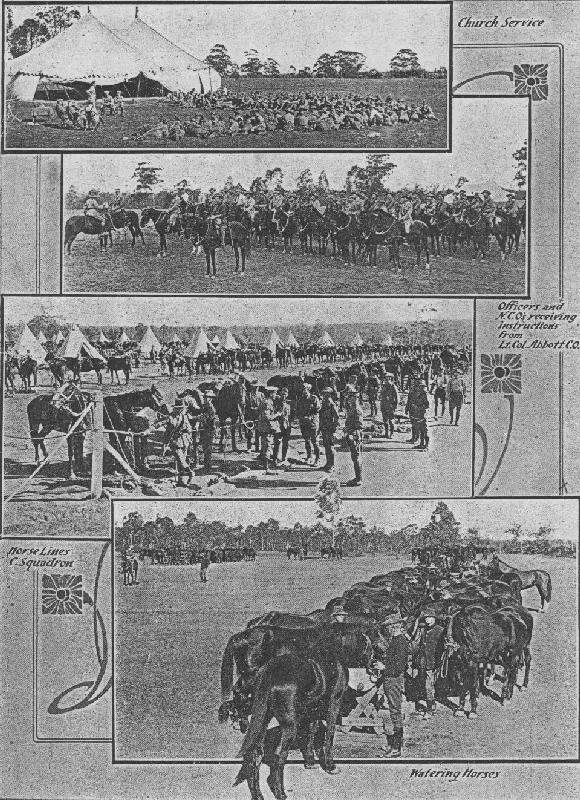 The Sydney squadron, numbering 69, under Captain King, was as supposed to represent the advance party of au enemy which had landed at Bongan Bongan Beach, near the entrance to Broken Bay. The squadron left the city at 8.30 a.m., and bivouacked at 1 p.m. at Narrabeen. The lauding party, by arrangement, commenced to make its dispositions at 2 p.m. from the Rock Lily Hotel, and the idea, was that the telegraph lines should be tapped in order to prevent reinforcements of the defending force coming from Hornsby.
The Sydney squadron, numbering 69, under Captain King, was as supposed to represent the advance party of au enemy which had landed at Bongan Bongan Beach, near the entrance to Broken Bay. The squadron left the city at 8.30 a.m., and bivouacked at 1 p.m. at Narrabeen. The lauding party, by arrangement, commenced to make its dispositions at 2 p.m. from the Rock Lily Hotel, and the idea, was that the telegraph lines should be tapped in order to prevent reinforcements of the defending force coming from Hornsby.
The Parramatta, squadron of Lancers was ordered to find out the strength of the enemy that had landed at Bongan Bongan Beach. According to the plan of operations the road via the Spit was held to be untenable, so that the detachment had to proceed via Pymble. The Parramatta men mustered 72, and were under the command of Captain Mackenzie. They left Parramatta at 8a.m. and reached Tumble-down Dick, near Pymble, in time for lunch. Lieutenant-Colonel James Burns, officer-commanding, accompanied them, and at Pymble Brigadier-General Finn, Major A. P. Luscombe, D.A. Q.M.G., and Lieutenant Macartney, A.D.C., joined the party with a view to witnessing the manouvres.
A start was made at 2 p.m. from Tumbledown Dick to ascertain the whereabouts of the enemy, and very rough country was encountered, but trooper's and horses got over the ground capitally. The enemy's landing party not having time apparently to achieve its object, its officer-commanding threw out a line of outposts extending from the Rock Lily Hotel to a little point near Newport. Shortly alter 3 p.m. the Parramatta squadron got into touch with the outposts about two miles from the hotel, and after some good work on both sides the evening's advance guard, according to the prearranged plan, was driven back to the reserve near the beach.
Owing to this reverse and the weather becoming thick and stormy the landing party was supposed to be unable to re-ombark by boats on board of the cruisers, consequently a position was taken up on Bongan Head. In this phase of the operations, however, the Sydney squadron no longer represented the enemy, but joined the Parramatta men. The enemy's position on Bongan Head was represented by eight canvas targets, which had been erected under the supervision of Major M. Hilliard, D.S.O., and Captain P. C. Timothy. Four of these were located about 500 yards from the main road and the other f our about 900 yards distant, but the ranges were unknown to those who subsequently took part in the firing. It was decided that the attack on this position should be made shortly after daybreak on the following day by the entire body of Lancers representing the home force.
The two squadrons a little after 5 p.m. reached Mr. George Brock's Mona Vale estate, where Captain Timothy had arranged with the owner for the whole force to bivouac for the night. The troops were here joined by Colonel H. D. Mackenzie, A.A.G., Captain J. Purves, and Captain J. S. Brunton, the two latter travelling by motor car. The Lancers band also came down by a coach provided by the officers, who also contributed the commissariat supplies.
The State Commandant addressed the officers and N.C.O's. during the evening, and said that he was well pleased generally with the tactics, intelligence, and conduct of the troops. The men had shown their efficiency as skilled horsemen in very rough country, and he complimented them on their mobility. The outpost work was creditably performed, but at times rather humid. After tea a camp-fire concert was held, in which the band figured conspicuously, and Mr. Brock' rendered valuable assistance. A boxing bout between two amateur champions, Troopers Parbury and R. Baker, proved exciting, as were also some smart singlestick tourneys.
At daybreak yesterday the reveille sounded, and the Lancers at 5.45 a.m. were on the way to attack the enemy's position, indicated by the canvas targets on Bongan Head, forty rounds of ball cartridge were fired per man in the attack, which was at unknown distances. The shooting was good. One target had about 200 hits on it. The weakness of the attack, according to Brigadier-General Finn, lay in the fact that the men were too prone to expose themselves and rush forward in large numbers instead of in twos and threes. These were defects apparent in all sham fights, however, and only corrected by a taste of the " Real thing."
The troops returned to camp at 8.16. After morning "stables " a bathing parade was held, in which nearly every Lancer participated on his horse. Mr. Brock was thanked for his kindness in quartering the forces, and route march was then taken via the Spit for the Sydney Squadron and via Pymble for the- Parramatta men. - The Sydney detachment reached the city in the afternoon. MILITARY INTELLIGENCE. (1902, December 15). The Sydney Morning Herald (NSW : 1842 - 1954), p. 9. Retrieved from http://nla.gov.au/nla.news-article14521240
George Brock was relying on the ill-fated tram line being built to Mona Vale, even Newport as it was first touted. This did not occur in time for him. The tram eventually terminated at Narrabeen. A description of the place during the its construction:
' THE OAKS," MONA VALE.
One of the most interesting places on the coach road between Mosman and Newport is "The Oaks," the home of Mr. G. S. Brock. Just after passing the Mona Vale Stores, you see on your right a picturesque group of buildings. The style is very attractive and uncommon in this country. A large gateway lets you into the grounds, where tame kangaroos and other animals, are playing about on the grass. Some fine dogs greet your approach to the main buildings where, if you are fortunate, you will find Mr. Brock at leisure - for he is a very busy man.
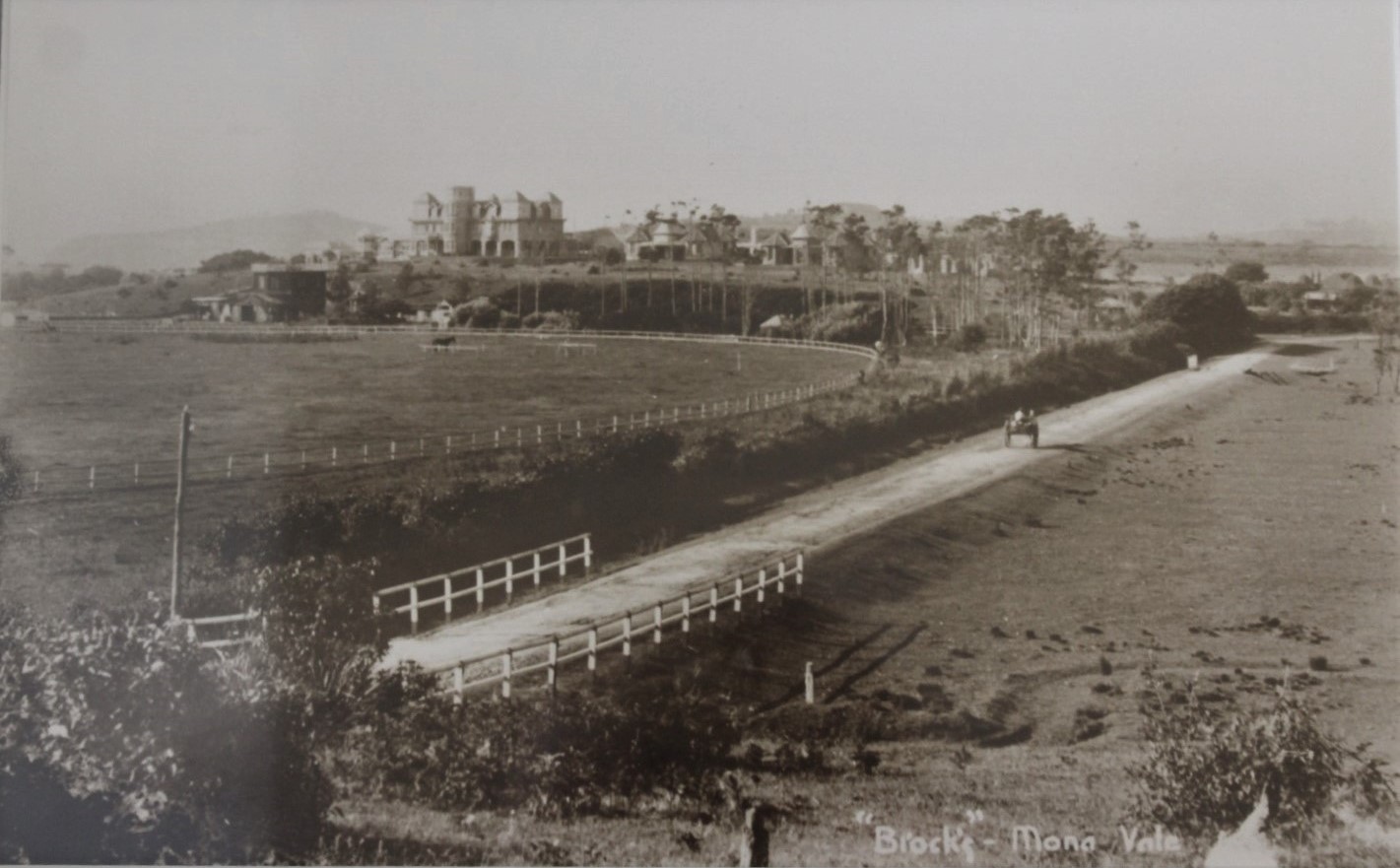
Mr. Brock has made a great impression upon the district.
He is of average height, compactly built, with strong features. His face reminds one of the old Romans as they have been pictured for us. He is clean shaven, quick in speech, and direct-in his utterance, very prompt and somewhat masterful in manner. A man, that can be plainly seen,— a man of strong individuality. He stands alone, and requires no support but his own keen brain and active body. He is a man to take the lead and keep it, a man who by his greater pushfulness makes enemies as well as friends.
One of the most noticeable buildings about the place is Circular in Shape. The ground floor is used as stables, and here Mr. Brock has some fine horses, including the stallion " Souvenir,", a beautiful and spirited Arab that seems to understand every word his master says to him. On the next floor is a music room, with piano, organ and other instruments. Being circular, it is splendidly adapted for dancing. Among the articles hung upon the walls are fencing foils and boxing gloves,—and a glance at the face of the proprietor will convey to you the hint that if you are not anxious for violent exercise you had better at all hazards retain his hearty good will. There are other buildings on the heights above this one, in course of erection. They are intended for a grand series of residences, and there will be a Great Central Hall, with contiguous apartments for the use of all the residents. This hill overlooks the ocean, and gives a splendid view of the bright Pacific. The beach is but a few yards off; to the left, on land, is a fine racecourse; in front a lake, on which swim black swans, some of them paying devoted attention to their floating nests. There are other birds and animals in the lake. Gambolling after one of the young ladies is an alema, a curious animal,' something between a monkey and kangaroo, very pretty and perfectly harmless. Mr. Brock purposes starting A Dairy on the other side of the racecourse from the houses, for the use of the residents. He has had many handsome offers for the estate, but refused them all. Several of the would-be purchasers wished' to turn it into a pleasure resort, but as the probability was they would get a licence and sell drink Mr. Brock promptly refused to consider their proposals. As soon as the Government begin in earnest to build the Spit to Newport Tramway, Mr. Brock promises to put on 200 men to complete all the work which for years he has planned for this beautiful country home. If they do not start it in a reasonable time he may himself install a 80 passenger Motor-Coach, but only to "The Oaks" and only for the service of the people living there. Families will be able to come to the Oaks and stay any length of time at moderate expense enjoying all the delights of country and … farm life—without all the work. ' '
There is an Art Gallery Also in the buildings, where Mr. Brock, junior, plies his capable brush. The walls are covered with his pictures, all showing marked talent. On the way from America, the land of novelty, is A Sculpturing Machine, which a skilled operator can make facsimiles of a human face simultaneously. From the photographs of the it is a wonderful affair, costing a pounds. The marble busts can turned out very fast and cheap,—say 5 or 6 hours for about a pound a piece' quite knocks out hand work—but it requires a hand to guide the rapidly cutting chisels, and the hand of an artist in order for good results. A sculptor, however, can with one of these machines of much better work than with the hand only. The instruments that do the out- resemble somewhat the little cutters dentists use to bore out teeth for stopping. They have only to be moved over the marble slowly and the lifelike image is graven. When the tram was started from Manly Mr. Brock put on about 200 Men to get the place ready, but when that fine project fell in pieces he took most of the men off again. He keeps a brick kiln going constantly, and there are always men employed building.
Some day " The Oaks " will be the name of one of the finest health resorts in the world,-meantime it is a most comfortable and beautiful home.
“THE OAKS,” (1904, September 3). The Mosman Mail (NSW : 1898 - 1906), p. 4. Retrieved from http://nla.gov.au/nla.news-article247008613
Some visitors:
FISHING.
(By 'GLAUCUS.')
The Navigator, the Printer, and the Journalist, all members of the Amateur Fishermen's Association, had a memorable trip last Friday to 'The Oaks,' Newport; the well-known beautiful residence of Mr. G. S. Brock. The Navigator (Capt. A. Barron, of the s.s. Upolu) took five young edible turtles to the coastal beauty spot, and the other two went with him at Mr. Brock's Invitation. The little turtles were ‘all a-growin' and a-blowin' ' in a billy full of sea water. They were some that had been hatched out in sand on board the vessel after being taken from their nests in the Island beaches. The little chaps flapped about comfortably on one's hand and bit at the finger pushed at their noses. Pulling one out of the billy in the packed coach the ladies inside were enabled to Inspect the curious little fellow. 'Where did you get them? was the natural query, but the Navigator's reply, that he had hatched them himself, was greeted with disbelief by the lady passengers. Presently after being assured by the Journalist, who is reputed to have the least honest face of the three, that the statement was correct, an elderly lady with a twinkle in her eye said she had a clutch of Orpington eggs at home that the hen had left, and that the Navigator might sit on them if he liked. Quoth the Printer at that stage: 'The only clutch you could safely put him on would have to be a china set.' The Navigator, it should be parenthetically observed, weighs nearly 13st. One of the ladies thought It would be a good Win. 'Mother,' she said, 'we might get a new china dinner set that way.' Amid much merriment the trio travelled to Rock Lily, and, resisting an Inclination on the part of the Printer to inspect the paintings in some of the private rooms, journeyed to 'The Oaks.' Their subsequent adventures would fill a sizable volume.' The host, gave them a 'day in the country,' and finally mounted the thee inexperienced riders on polo rides for a trip round the estate and thence to Pittwater. The results of that ride remain with the party yet. The Navigator had to eat his meals next day of the mantelpiece, and the Printer and the Journalist sat down very steadily whenever they they had to sit during Saturday.
After a sail down to Newport Arm in Mr. Brock's speedy yacht, The Dolphin, the yacht rescued a party of ladies in an open boat from dying for want of afternoon tea and took them for a cruise down to the Basin and back. The wind left the yacht on the way home, and it was 8.30 p.m. before the quartette got back to the horses. After accomplishing a perilous ride back to 'The Oaks,' some musical contributions from talented members of Mr. Brock's family whiled away a half-hour, and the party left to catch a supposed 10.30 p.m. boat from Manly. The boat, however; left at 10.15 p.m., so they were in good time for the next at 11.15 p.m. Recognising that 11.50 p.m. at the Quay was too late to allow of a cab catching the midnight train, the Journalist pretended he liked work, and went to the office that tolerates him to write leading articles until the 2.45 a.m. train for Strathfield should start. The other two took a cab and chanced it. Naturally they missed the train by two or three minutes. The Navigator lived at Summer Hill and the Printer at Croydon so they held a united prayer meeting and set out in the cab with a city driver, who knew not the suburbs. The sailor-man reached home about one o'clock, but the Printer had most alarming adventures, being driven away up near Homebush instead of Croydon. He got home about 3 am. The Journalist, being an old dog for a hard road, and knowing the ropes, so to speak, travelled in one of the all-night trams to Redfern, had a coffee and 'saveloy and mashed' at the coffee stall, and reached home at 3.15 a.m. Now if anyone wants to hear language he has only to invite the three to tell the narrative of their day at 'The Oaks.' FISHING. (1905, January 25). Referee (Sydney, NSW : 1886 - 1939), p. 9. Retrieved from http://nla.gov.au/nla.news-article120495249

Brocks 'The Oaks' - 1st version Broadhurst postcard, circa 1902 - 1912
George Brock was relying on the much spoken about for a long tome tram to Pittwater to make easier access and more people visiting a means to return some of the thousands of pounds he must have spoent by then on this property and its buildings. By late 1904 he even proposed to fund the building of the tramway himself:
NEWPORT-PITTWATER.
Though the continued appeals to the Government for the construction of the tram from Manly to Pittwater have not met with anything beyond the usual shelving promises, the matter is not by any means being allowed to cool. An effort is now being made to allow private enterprise to take the matter up, and the following letter has been addressed by Mr. George Brock of "The Oaks" to the Hon. Secretary of the Newport Progress Association.—
" Dear Sir,—I beg to bring before the notice of your Council the proposal I have made respecting the tram which I propose to take over and have completed by this time next year to Narrabeen and in two years to Pittwater. I trust your council will give the scheme every support and by doing so will give private enterprise an opportunity to do what the Government have fairly messed up. As there will be a large amount of employment, it being being intended to start from Pittwater end as well as from Manly tram sheds, your council (in the event of my getting the concession to be allowed to take it on) might provide or partly so the labor for Pittwater end."
A rough plan accompanies the letter showing that the route proposed to be taken does not follow the road all the way. His intended to have three sections Brookvale threepence, Narrabeen sixpence, and Pittwater ninepence. If the matter is taken up as it should be the tram to Pittwater may become an accomplished fact, and the proposal now made is worthy of the hearty cooperation of all concerned.
The Postmaster General of the Commonwealth has notified the Hon. Dugald Thompson, the Federal Member for Warringah, that the mails for the residents round the bay at Pittwater will be delivered by the launch that is used in carrying the children to school. The post and telegraph office at Barrenjoey having been closed, the work is now being done at the Newport post office. NEWPORT-PITTWATER. (1904, November 26). The Mosman Mail (NSW : 1898 - 1906), p. 4. Retrieved from http://nla.gov.au/nla.news-article247009079
The following letter will interest visitors to Newport and Bay view: — 'Dear 'Glaucus,'
— For the last few weeks I have been trying the points between Manly and Barrenjoey for rock fishing, but without success, and we found fresh water as scarce as the fish. There seems to be none procurable at all as far as we could see. Any suggestion you can make will be acceptable, as to likely points. I might say that we ride bicycles, and so distance Is not of much account.
We tried Narrabeen Lagoon without success. This place Is a disgrace to all concerned In looking after its welfare. Could you not do something with the A.F.A. to prevent the netting going on, and to have the opening made as you suggested, so as to let the lake fill again P.S:We used to have first-rate camps up Deep Creek a few years back, and the fishing was fair at times, too. —Yours, &c, C.H.S.'
C.H.S. might try the Mermaid's Basin and rocks thereabout. It is on the coast at 'The Oaks,' Mr. Brock's beautiful home near Newport. BILLIARDS (1905, February 1). Referee (Sydney, NSW : 1886 - 1939), , p. 9. Retrieved from http://nla.gov.au/nla.news-article120499644
And to get people there:
MOTOR OMNIBUSES. THE MANLY-PITTWATER, SERVICE. INAUGURAL RUN.
The two motor buses recently imported from England for the service between Manly, Rocklily, Bayview, Newport, and Pittwater, made their initial trial on Thursday afternoon last. The run was to the residence of Mr. Brock, of Newport, and return to Manly, a distance of 23 miles. The 'buses, which were imported to the order of Messrs. Reid Bros., of Manly, are likely to be handled by a company, known as the Manly-Pittwater Motor Omnibus Company, Limited, with a capital of £8500. It Is the intention of the company to shortly Import a number of similar vehicles, as well as some steam 'buses, to tap the various populated districts at present badly supplied with tram or horse 'bus service. Manly was en fête for the occasion on Thursday, and a big crowd assembled at the Pier Hold to witness the start, which took place at 2.20 p.m.
Amongst those who took part in the trial were Mr. Dugald Thomson, M.P., Dr. Arthur, M.L.A., Mr. F. F. H. McKenzie, M.L.A., Alderman Quirk (Mayor of Manly), Alderman Walker, Alderman T. J. West, Alderman Lear Bioiinth, Alderman Ogilby, Messrs, S. L. Ridge, Charles H. Kerry (director of the Motor Company), E. E. Kennedy (secretary to the company). E. A. Laurence (of Laurence and Laurence, solicitors to the company), John Bennett, Wm. M'Leod, Daniel Farrell, H. T. Roby George Rodda (of Adams and Co.), Alexander Edward (secretary to the. Traffic Commissioners), D. S. K. Millar (Bank of New South Wales), W. J. Bradley, and Mr. Houreaux.
As the buses left Manly for Newport with 16 passengers on board each vehicle there was much enthusiasm, and it was evident that the introduction of the latest form of propelled vehicle was highly appreciated by the residents. Flags were flying from various buildings and arches had been erected at various part's of the road. As the 'buses made their run towards Newport several other petrol vehicles escorted the now service. All were gaily decorated out of compliment to the new Motors. There is little doubt that with a good and quick service many people will soon make the trip. Considering that the buses were shod with solid tyres the run was very smooth throughout.
The first 'bus, with the "Herald" representative on board, reached Mr. Brock's residence at 3.9 p.m., having covered the 11 ¼ miles in 49 minutes. There had been no rushing in the journey, as it was the intention of the owners to allow the party to view the magnificent scenery en route. With the exception of a slight delay at Sheepstation Hill, owing to the fan belt slipping off the pulley, the run made by the first bus was a delightful one, and must be deemed very successful. Unfortunately, the second 'bus had not quite so good a journey, as the carburetor stopped up when near Sheepstation Hill, and a halt had to be made. It took the chauffeur a considerable time before the obstruction in the petrol feed tube was removed. The delay was most vexatious to Messrs. Reid, who had already accomplished several journeys without a stop. It was especially unfortunate that the stoppage should have occurred in the inaugural run, as such things often tend to dishearten enthusiasts. Considering that the buses are as yet practically new, and that they will not be In thorough working order until they have covered at least a couple of hundred miles, the speed and hill-climbing capabilities displayed during Thursday's run must be deemed excellent.
DESCRIPTION OF THE BUSES.
Each bus is fitted with a 22-h.p. Aster engine, 4-cylinder rod, and with the cylinders cast separately. The full power of the motor is got at 1000 revolutions, but the speed may, be brought down very low by the manipulation of the throttle. The engine Is supported In the chassis by two strong channelled steel stays running from one side to the other, thus keeping the motor firm and secure. Elseman high tension magneto with synchronised Ignition is fitted, the accumulator and coil supplied extra being carried as a standby. Each of the four cylinders Is run from one coil by means of a distributor, and the switch fitted on the dashboard enables the chauffeur to turn on or off either Ignition at will. The manipulator of the spark and throttle Is of the latest type, being attached to the steering wheel, so as to allow the driver easy control. The change speed gears being at the driver's right hand allow easy management. As regards the chassis, It Is made of pressed steel, of U section, and narrowed In front, so as to allow a bigger wheel look. The length of the frame is 15ft 7in, and the width 4ft 9in, while the wheel base Is approximately 11ft the latter width being practically that of an Australian waggon track. The weight of the respective models turns out to be a little more than expected for a single-decker, totalling altogether 2 tons 5cwt for chassis and body. There is little doubt that the wood work In the motors is substantial, but had a little less solidity been supplied they might have been bettor. The artillery wheels fitted to the 'buses are strong, and, having solid forged axles, there is little likelihood of any injury to them. The drive is by chain, a stout 3in block chain being fitted on each side. The chain may be tightened when required by means of a substantial radiating rod. The springs of the vehicle,, though apparently strong, proved on the running to be just a trifle weak for the Manly-Newport road, and one could often experience at certain places slight Jars. It would certainly be advisable to have an extra leaf or two of spring put on.
Each 'bus is fitted with three speeds and reverse. Between the differential and the gear box is a strong coupling shaft with two flexible joints. The Panhard system of gearing with direct drive on the top is employed, and the estimated greatest speed is about '20-25 miles an hour. ' As regards the water circulation, this is supplied by means of a powerful pump. Tubular radiators and a large fan driven by bolt off the shaft help to keep cool the engine. The brake work on each chassis is of the external band type. Although for heavy vehicles the Internal expanding system of braking Is to be preferred, those on the new 'buses seemed very effective, and were able to pull up the latter quickly when descending some stiff gradients. The tyres, which are solid, were turned out by the Dunlop Company. It is a pity the company who purpose running the buses did not see their way to fit twin tyres on the rear wheels, as the wearing qualities of the latter are superior, and there is loss likelihood on the part of the vehicles to skid.
As regards the body part of the respective Cars, the design and finish seem simple, yet neat. In each 'bus there are four cross seats, each vehicle being capable of accommodating about 16 to 18 passengers. A very desirable feature about the seats Is that each of the four rows Is placed on a different level,
the back one being the highest. This arrangement enables each back row of passengers to have an equally good view with those In front. There is a canopy, with convex roof, fitted to each car, and supported by tubular Pillars. To protect the driver or passengers in dusty or rainy weather, two folding glass
panels can be lowered, as can the folding side blind. The finish of the vehicles is In excellent taste, the cars being upholstered In dark green leather. The woodwork Is painted dark chocolate with yellow lines on one model and dark green with light lines on the other. A luggage carrier is fitted on the top of the
canopy.
SUCCESS OF THE SERVICE ASSURED.
When the buses reached Mr. Brock's residence refreshments were served, after which some photographs of the new vehicles with the passengers aboard were taken. Mr. Quirk, Mayor of Manly, occupied the chair, in the course of his remarks ho said that every credit was due to Messrs. Reid for having had the courage to Import motor 'buses.
Mr. Dugald Thomson, M.P., proposed success to the new venture, and eulogised the Importers as men of enterprise, who had surmounted great difficulties. He hoped soon to see a regular service of 'buses running between Manly and Pittwater, and trusted the venture would meet with the success It deserved.
Dr. Arthur, M.L.A., in supporting the toast, said he was a humble admirer of anything In the shape of enterprise. Ho thought the Manly-Pittwater buses would be a decided acquisition to the neighbourhood. He characterised Pittwater and the surrounding neighbourhood as one of the loveliest districts in this State, and hoped the present buses would be compared favourably with those at present in Sydney, would always be kept busy.
Mr. M'Kenzie, M.L.A., also spoke, and pointed out the necessity that existed for proper communication, between Manly, Newport, and district. He had no doubt that in a short time many more similar buses would be in use.
Mr. Cried responded and spoke of the initial difficulties in inaugurating the service. He was perfectly satisfied that once the novelty had worn off the present buses they would successfully cater for the demands of the Manly and Pittwater residents.
MOTOR OMNIBUSES. (1906, February 10). The Sydney Morning Herald (NSW : 1842 - 1954), p. 17. Retrieved from http://nla.gov.au/nla.news-article14732737
However, the success of this service was not assured and the venture was liquidated soon afterwards - the tyres didn't do too well on the roads and people had to rely on the coaches still.
His daughter, from The Children’s Corner – then conducted by Ethel Turner, author of ‘Seven Little Australians’, ‘Three Little Maid’s etc.): and soon to be a regular at Palm Beach herself!
"The Oaks," Mona Vale, via Manly.
Dear Dame Durden,-It seems quite a time since I wrote you. I was so pleased to see I was mentioned in the first and second honours of the last competition. The other day I sent in a story for Princess Spinaway's Competition. It is the first I have ever completed. Often I have written them, but never finished them.
Viva Brock.
(The Jester:
A Sea-egg and an Octopus were walking hand In hand;
They wept like anything to see a girl upon the sand.
"If she were only swept away," they said, "it would be grand."
"If seven whales and seven sharks hung round for half a day,
Do you suppose," the Sea-egg said, "that still she'd want to stay?"
"I fear so," said the Octopus and brushed a tear away.
"If I were only old enough," it added, with a sigh,
"I'd squeeze her up to jolly In the winking of an eye."
"Still, why not throw your ink at her?" the Sea-egg did reply.
"Oh, come now," said the Octopus, "I'll own it is a bore
To find a tiresome girl like this thus littering up our shore,
But a revenge so horrible was never planned before."
' For don't you see," he added, "she's already fond of ink.
And like a thirsty blotting pad would simply lie and drink,
With a consequence so awful that I shudder as I think."
"I understand," the Sea-egg said, "I quite com prenez-vous,
There'd be sonnets on the ocean, and on each wave a few,
While odes unto the billows continually she'd do.
"And goodness gracious, gracious me, too horrible 'twould be,
If she should make a poem upon you, dear friend, or me,
An 'Ode Unto an Octopus,' or 'Lines to Egg of-Sea.' "
"Oh, Viva," wept the Octopus "you've had a pleasant swim,
Won't you be trotting home again; it's high time you went in?
I dare not angry grow with you, I find 'twould be a sin.")
Peeps in Four States. (1906, March 21). Australian Town and Country Journal (NSW : 1870 - 1907), p. 38. Retrieved from http://nla.gov.au/nla.news-article71528448
The Jester's Competition.
1. What is a salmon on a gravel path?
Answer: A fish out of water.
2. Why are poultry the most profitable on a farm?-Answer: For every grain they give a peck.
3. If I buy four cakes for a penny, and giveaway one of them, why am I like a telescope? Answer: Because I make a far-thing present.
(Sent by Viva Brock, aged 15, "The Oaks," Mona Vale, via Manly.)
The Jester's Competition. (1907, July 10). Australian Town and Country Journal (NSW : 1870 - 1907), p. 32. Retrieved from http://nla.gov.au/nla.news-article71593915
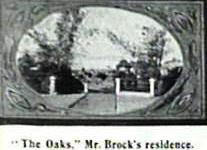 Brochure advertising sale of land in the Warriewood Estate by Henry F. Halloran & Co showing the entrance to Brock's
Brochure advertising sale of land in the Warriewood Estate by Henry F. Halloran & Co showing the entrance to Brock's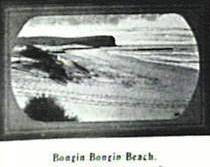 Folly and Bongin Bongin Beach 1906.
Folly and Bongin Bongin Beach 1906.
TO HOTELKEEPERS, AMUSEMENT CATERERS, SPORTING CLUB PROPRIETORS. BY ORDER OF THE MORTGAGEES. THE OAKS. MONA VALE.. PITTWATER.
This MAGNIFICENT and UNIQUE PROPERTY comprising about 114 acres, under TORRENS TITLE is situated 10 miles from MANLY, about 500 yards from the Rock Lily Hotel, on the main road to Pittwater and Newport, rendering it accessible from the city by either MOTOR CARS or COACH, has large FRONTAGES to DARLEY STREET, 'the PITT WATER-ROAD, BASSET STREET, and the PACIFIC OCEAN'!
THE BUILDINGS specially designed for a RESIDENCE of a PERFECT SANATORIUM, with Cottages for families attached, of brick on concrete foundation with Mansard roof with promenade, contain imposing MAIN ENTRANCE and HALL, billiard-room, lounge, smoking-room, 25 bedrooms, extra large dining hall, 6 bathrooms, and most up-to-date domestic arrangements, and servants' quarters.
ADJOINING THE CLUB-HOUSE is a STUDIO MUSIC-ROOM, with artistic lead-light windows and ceilings. LARGE FERNERY. A Short Distance from the main building is an octagonal house of brick and wood, containing in the upper portion BALL-ROOM (12ft x 42ft), -with up-to-date arrangements in basement.
IN the GROUNDS are the THREE BRICK COTTAGES above referred to, also TWO OTHERS in course of construction, and on the far side of the grounds is a six-roomed W.B. Cottage, with tiled roof.
THE GROUNDS are tastefully laid out with ornamental shrubs, lawns, and statues in front of the CLUB-HOUSE, while an area of about 40 acres opposite has been made ready for SPORTING purposes. GOLF, POLO, CRICKET, FOOTBALL, LAWN TENNIS, etc, and a 6-furlong Racecourse.'
THE PROPERTY. DELIGHTFULLY SITUATED on the shores of the PACIFIC OCEAN, embraces large beach Frontage where SURF Bathing can be indulged in without risk. Added to other attractions there is a NATURAL FRESH WATER LAKE in the grounds, enhancing their beauty, and at the same time affording a PERMANENT WATER SUPPLY. '
CONSIDERING the rapid strides in Motoring- as a means of transit, and the unrivalled position of the health and holiday resort, there should be a great future FOR THE OAKS.
BATT, RODD, AND PURVES, LTD, have been instructed to sell the above by PUBLIC AUCTION, at their Rooms, 88 Pitt-street. Next TUESDAY, the 7th of MAY, at 11.30 a.m. MESSRs. Minter, Simpson and Co., solicitors for the Mortgagee. Advertising. (1907, April 27). The Sydney Morning Herald (NSW : 1842 - 1954), p. 22. Retrieved from http://nla.gov.au/nla.news-article28153265
And later in the year, an Auction showing subdivisions is accompanied with a brochure:
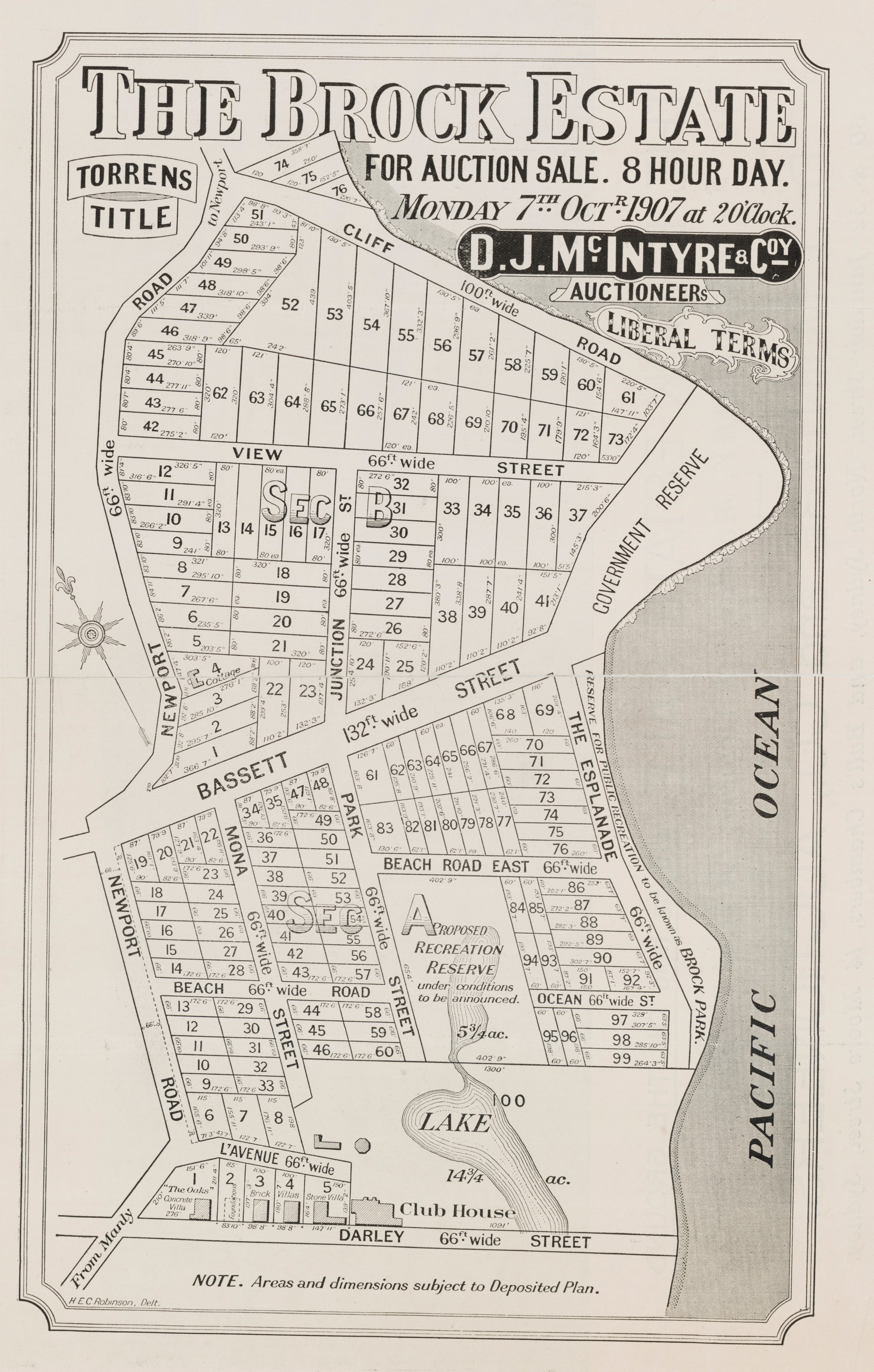
The Brock Estate - Cliff Rd, The Esplanade, Darley St, October 7th Newport 1907. Item No.: c046820076 from Mona Vale Subdivisions, courtesy State Library of New South Wales
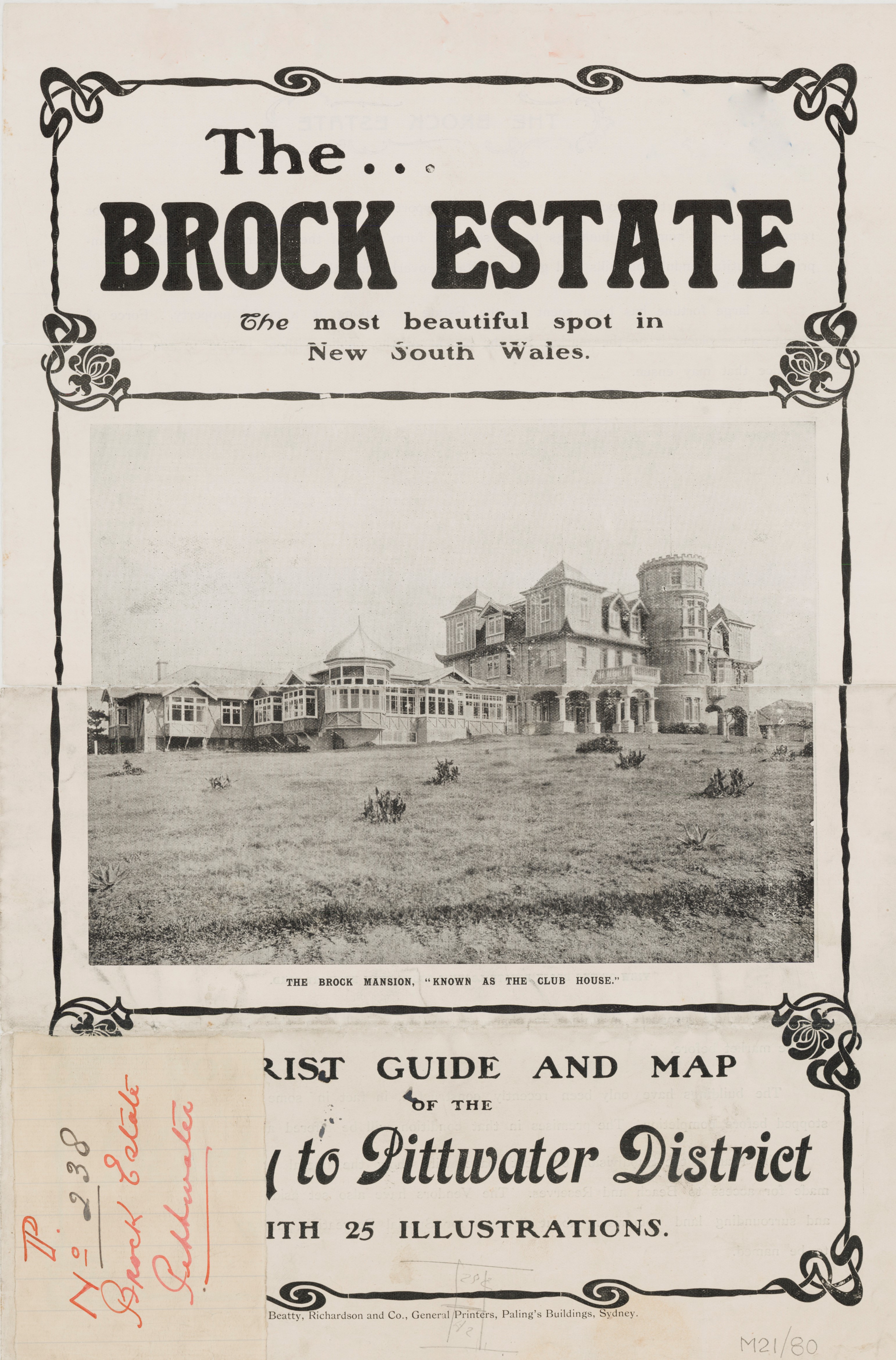
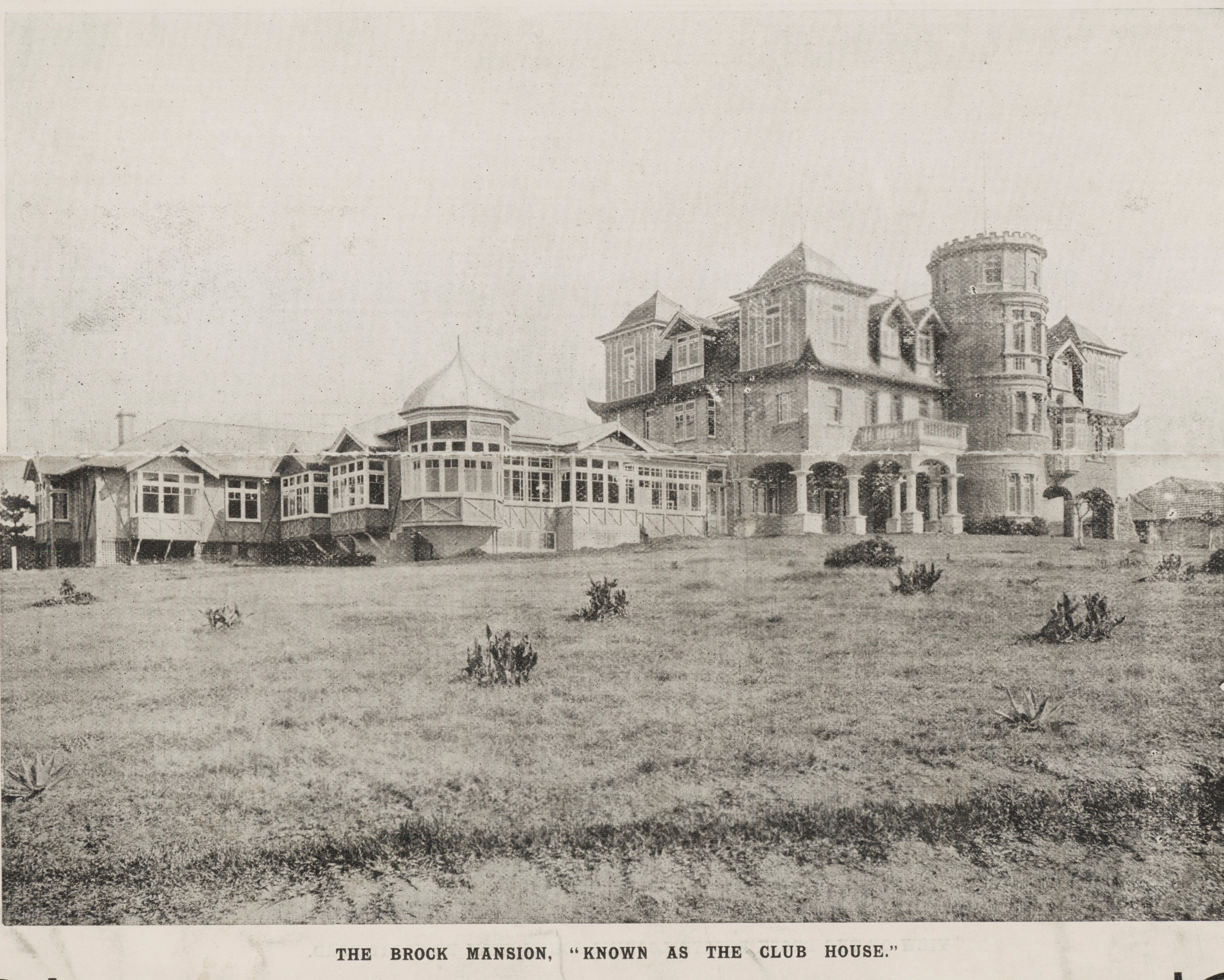
The Brock Estate - brochure Front page, 1907 Item No.: c046820078, Mona Vale Subdivisions, Courtesy State Library of NSW
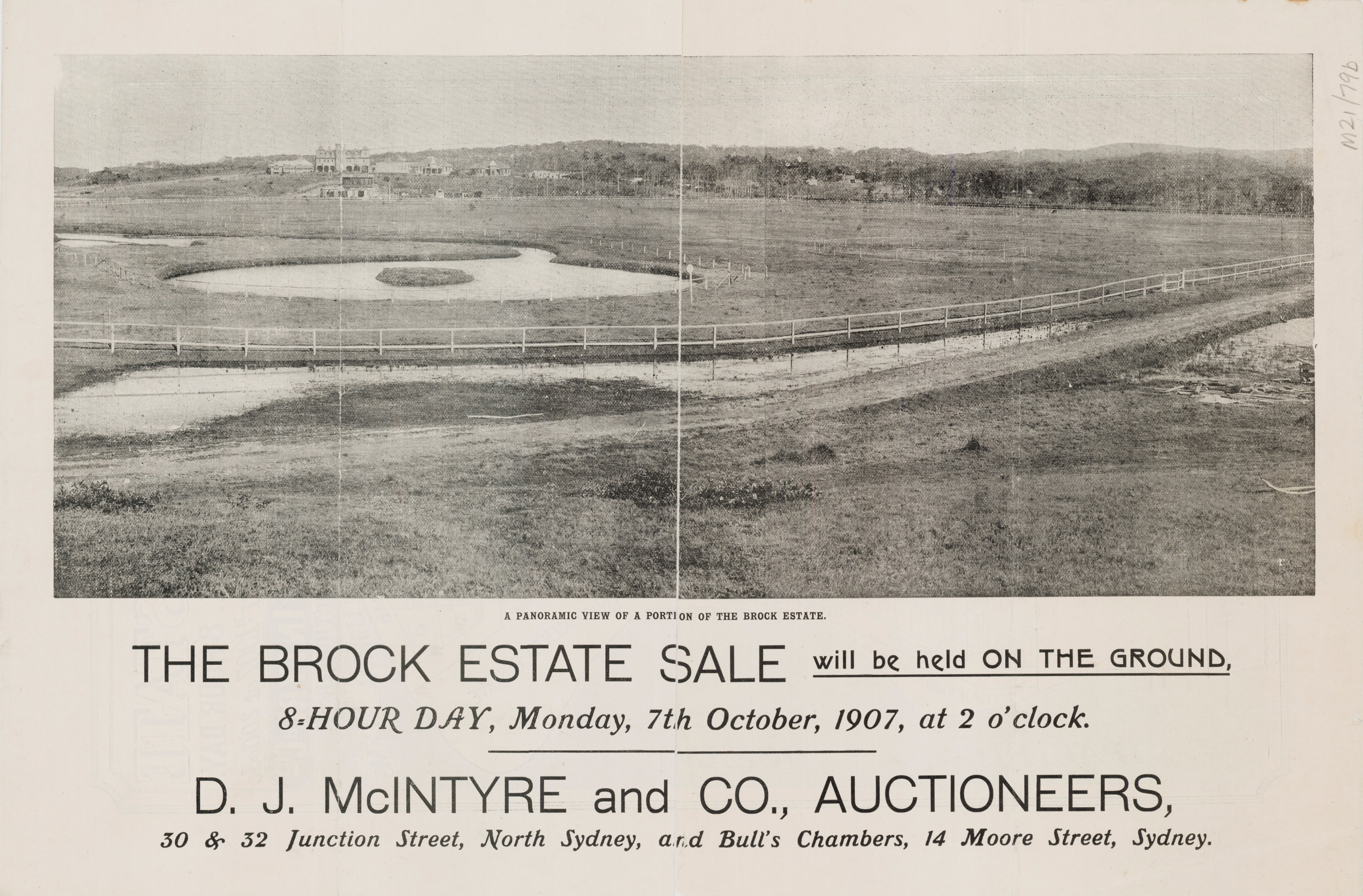
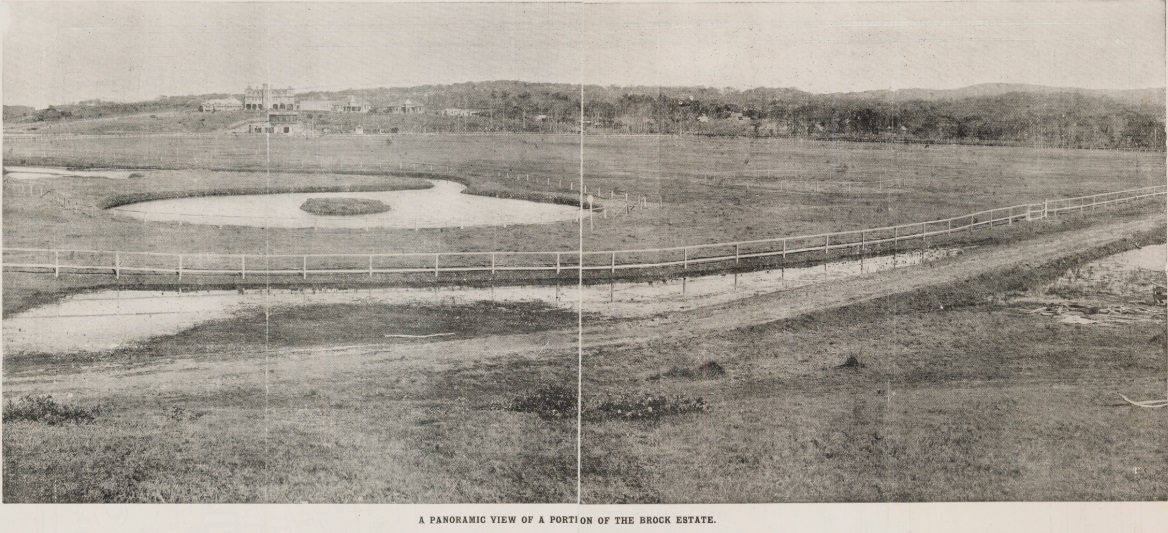
The Brock Estate - 1907, inner page brochure, Item No.: c046820077, Mona Vale Subdivisions, Courtesy State Library of NSW
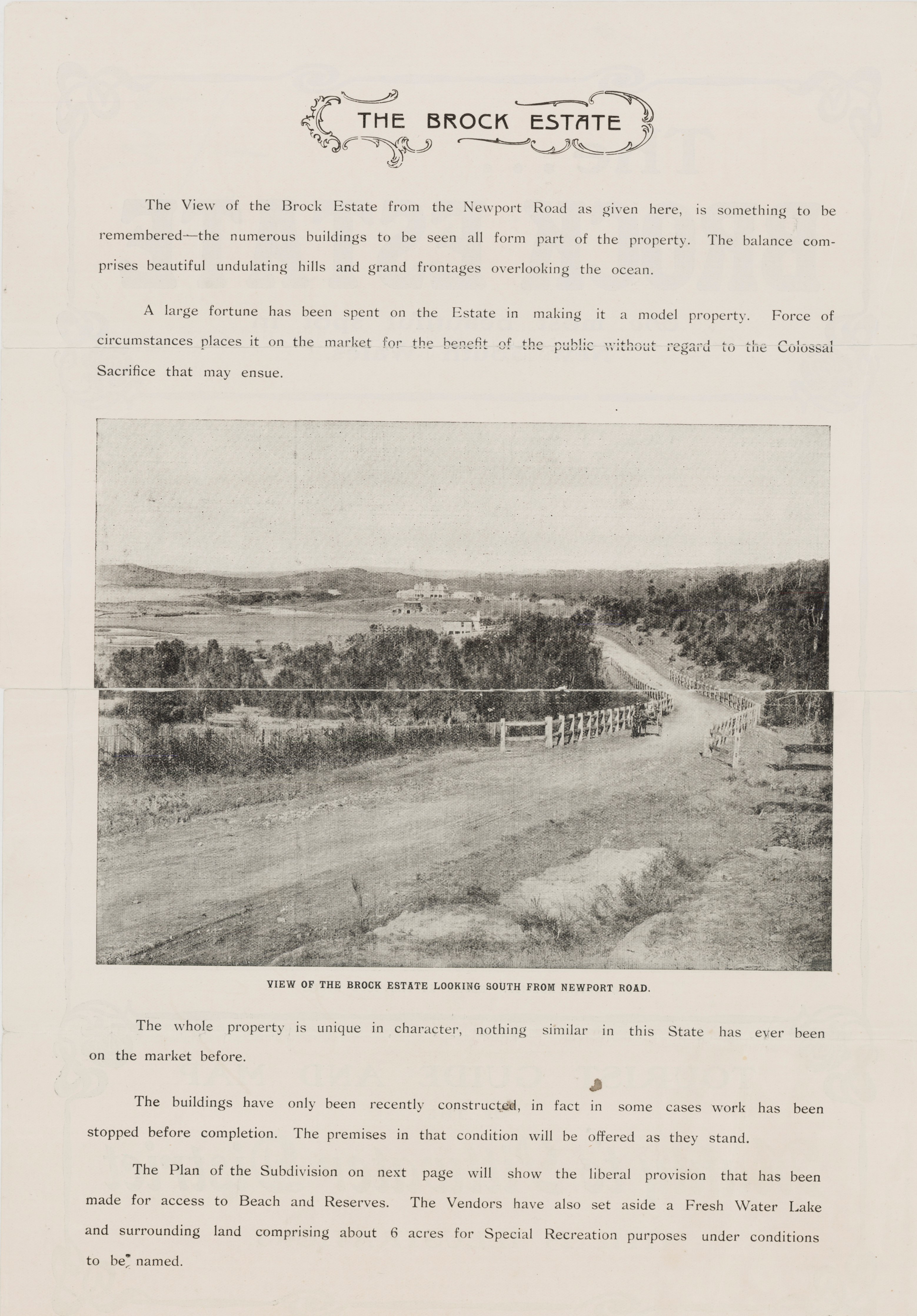
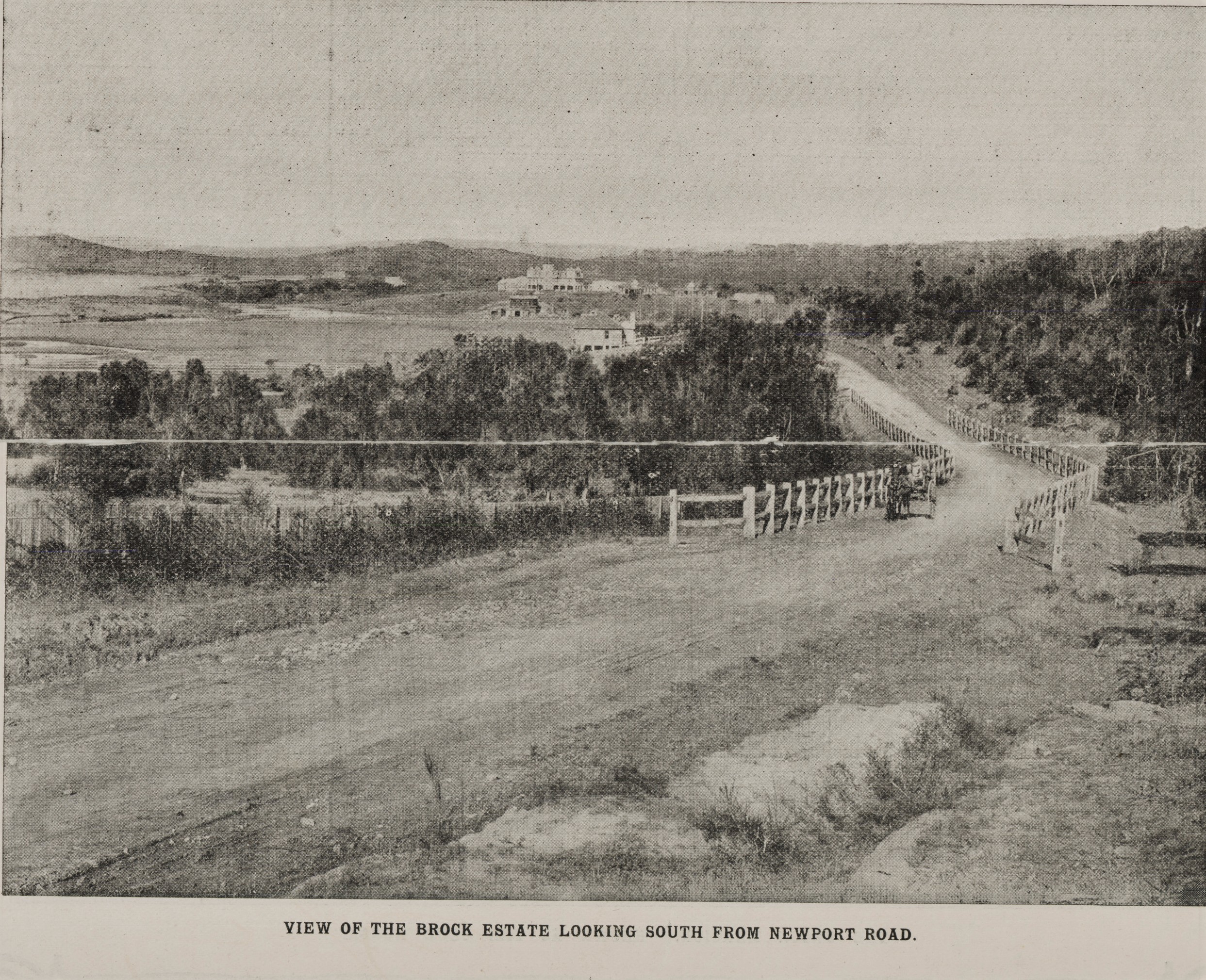
The Brock Estate - 1907, inner page brochure, Item No.: c046820079, Mona Vale Subdivisions, Courtesy State Library of NSW
QUITE A MODEST FIRE.
This little experience happened in one of my old neighborhoods during a stay with some friends. One night, in the middle of winter, it was bitterly cold, and we had just returned home after visiting a country concert some miles away. Our host suggested a fire, and we all agreed it was a welcome plan. Soon a big bundle of firewood was carried in, accompanied by two huge logs, familiar to the country fireplaces. With eager hands the master of the house lighted the wood, and then followed a grand sound of cracking and a big blaze. He continued to pile the wood on with great enthusiasm. The flames grew to an enormous height, and our hostess, whose name was Mrs. R-, cried in very alarmed tones "The chimney is sure to catch on fire!" But he assured her it was quite safe, and surveyed the successful fire proudly. Mrs. R- became very nervous, and disappeared through the front door only to come back with a rush and uplifted arms calling loudly
'I knew it, the chimney is on fire!"
Then there was a stir, and we hastened outside to find it was true, for there a great blaze and flying sparks wore shooting upward from the top of the chimney. Someone suggested wet bags to be thrown over it; others buckets of water, and so on. I was summoned to "awaken the maids. I banged and called loudly at their door, which was soon opened, and two frightened, ghastly figures appeared.
"Hurry!" I said; "the chimney is on fire; Wrap yourselves in cloaks, and come and help!"
Then the groom was called.
Everyone was hurrying hither and thither with buckets of water when I returned. The groom and two others were on top of the roof in no time throwing water as fast as they could over the blaze.
One girl, who was also a visitor, declared it could not be put out, and the house would be burnt to the ground. She rushed inside to her room, and was soon back with her silver purse and brush clasped preciously within her hands.
She has always been teased ever since, as you may guess.
At last the blaze grew smaller, and after a real good half an hour's work we were relieved to see the fire was out. We were tired of handing buckets of water up to the three men on the roof, and were fairly splashed during the hurry.
When we returned to the drawing-room the fireplace and hearth were covered with water and lumps of soot floating on top of it.
Then we all set to and helped straighten things up, which took some time. It was very late, and we talked and laughed a great deal over the exciting little adventure. We then went to bed somewhat dazed and it was not till the beginning of the new day that we drifted away into the land of nod.
I hope,' dear Dame, you have enjoyed this description. You will see by the address I. am now living in Sydney at Rushcutter's Bay, and like it immensely, but miss the freedom and beautiful air of the country.
By Viva Brock, 'Aloha', 'Rushcutters Bay' (aged 16 years).
QUITE A MODEST FIRE. (1907, November 13). Australian Town and Country Journal (NSW : 1870 - 1907), p. 31. Retrieved from http://nla.gov.au/nla.news-article71598500
Hearing of his problems the then state government, stepped in and purchased the property from the mortgage company, leaving Mr. Brock still in debt (see advertorial below - 'The Story of Brock's Folly'). Their initial plans were to establish a healing place to be overseen by the then named 'Lunacy Department', which was wholeheartedly embraced by residents:
Mona Vale Estate.-Mr. George Crowley, managing director of the City Mutual Life, writes as follows:-In your Issue of yesterday's date Mr. Brock Bays, "to carry on I had to seek financial assistance. Promises made to me were not fulfilled, and now I find myself left with the debt of the building material to the tune of £1600." As It is pretty generally known that the society was the vendor of the property to the Government, this might give rise to misapprehension. Any promises that were made by this society to Mr. Brock were amply fulfilled. INSTITUTE OF ARCHITECTS. (1909, March 25). The Sydney Morning Herald (NSW : 1842 - 1954), p. 6. Retrieved from http://nla.gov.au/nla.news-article15045735
There is more on Mr. Crowley in: Pittwater Roads II: Where the Streets Have Your name - Avalon Beach
MONA VALE PURCHASE
At a public meeting convened by Councillor Quirk In Booth's Hall, the recent purchase of Brock's Hall and estate by the Government to establish a convalescent home at Mona Vale was discussed. There was a very large attendance.
Councillor Quirk having explained the position, Mr C P Harrington was voted to the chair.
A motion from Mr Devlin, asking the Government to give a guarantee that the proposed Institution be used for no other purpose than a convalescent branch of the Lunacy Department was moved, but the following amendment was carried by an overwhelming majority -"That this meeting is meeting is In accord with the proposition of the Government to occupy Brock's Mansions as a convalescent home, and most unreservedly gives it all support, and without question ". MONA VALE PURCHASE. (1909, March 26).The Sydney Morning Herald (NSW : 1842 - 1954), p. 10. Retrieved from http://nla.gov.au/nla.news-article15045857
Brocks Mansions.
(To the Editor.)
I read with deep regret the pathetic story of how the loss of £25,000 brought the writer, G. T. Brock, into financial difficulties, if not financial disaster, and as you ask for comments on this great loss, I would like to point out what I consider were the big mistakes made in the construction of these mansions. The first part of the work was good, filling in the swamp, erecting fences, the racecourse, polo grounds, stables and dwelling-house deserve every praise, as it turned an almost useless piece of land into what it is now, one of the most charming little spots on the N.S.W. coast. What Mr. Brock’s intentions were for constructing such a large place, I do not know, or anything about tram promises made to him by Mr. Sullivan. I am dealing with the buildings, simply from a mechanics standpoint, and I can only concur with you as you say in “Building” that the want of an architect was severely felt, and it does seem almost incredible that a man with Mr. Brock’s great intellectual attainments, and practical knowledge on so many diverse subjects, ever attempted to carry on such a big work without professional assistance.
These buildings are not a common or ordinary structure by any means; their construction required the skill of nearly every class of artisan, and nearly every known design of work, from Ionic masonry to lath and plaster, and naturally called for a man that was well up to all the little niceties of modern architecture. The tradesmen employed were good enough, their work speaks for itself; and the marvel is that they did so well, handicapped, as they were, for want of details. Being a stonemason myself, there are two blunders in the work that show out very conspicuously, and points badly to the want of someone who could use intersecting lines, or had knowledge of geometry. First, is the scroll work at the entrance gates. It is all out of rhythm, and seems to have been scratched on in a “here’s luck” sort of way, without any attempt at practical drawing at all. The second is the joints of the elipses arches, which are all wrong; instead of being struck from a centre of three segments, they are struck from the centre of an ordinary half-circle, so you can see in these two things alone, for want of a dr
Everyone here is really sorry for Mr. Brock. He spent a lot of money, gave Mona Vale a real good start, and now both him and his fortnightly pay is sadly missed.
JAMES BOOTH, Stonemason. Mona Vale. - Published in Building : the magazine for the architect, builder, property owner and merchant. Call Number N 690.6 BUI Created/Published [Sydney : Building Publishing Co.] 1907-1942. Issue Vol. 3, No. 23 (12 July, 1909)
It wasn't just the fortnightly pay that would be missed. Robert Daniel Porter, one of the Porter sons of Newport, enlisted on July 2nd, 1915, at Liverpool for service during WWII, - listing his age as 28 years and 8 months and stating he had done a 5 year apprenticeship with G S Brock, listing his trade as ‘Carpenter’.
The Oaks was now to be called Mona Vale Hydro:
MONA VALE HYDRO.
The ceremony of opening the Mona Vale Hydro formerly known as Brocks Mansion Pittwater took place yesterday afternoon. The estate which has a frontage to the beach was recently acquired by Mr Arthur Rickard of this city and he has leased the house to Mr Fox as a hydro and the polo grounds as golf links.
Upwards of 80 people accepted invitations and in the unavoidable absence of the Minister for Works the ceremony of opening the hydro was performed by Mrs Griffith.
A dinner presided over by Mr Arthur Rickard followed, among those present being Mrs Griffith, Mi G B Edwards MP and Mrs Edwards, Dr Arthur M L A mil Mrs Arthur, Mr E W Quirk (president of the Warringnh Shire Council) Mr D Hogan (town clerk Manly) Mr P J Carew (Warringah Shire clerk) Mr J J Mulligan, Mr Jas. Rickard, Mr G Crowley, Mr J W Duesbury, Mr Robey, Mr G Morgan, Mr Scott Fell and Mr Robey.
Mr Quirk proposed the toast of the Federal and State Parliaments coupled with the names of Mr G P Edwards M P and Dr Aithur MLA both of whom responded.
Dr Arthur M L A submitted Success to the Hydro which was acknowledged by Mr Arthur Rickard (who said that the surfing beach on the estate was one of the safest in the State) and by Mr Fox the lessee. MONA VALE HYDRO. (1910, December 23). The Sydney Morning Herald (NSW : 1842 - 1954), p. 8. Retrieved from http://nla.gov.au/nla.news-article15190827
GOLF - OPENING AT MONA VALE.
The new course at Mona Vale will be opened on Saturday next, with open amateur and professional events. For amateurs there will be an open 18 holes stroke handicap for three trophies; while the professionals will compete in a scratch medal handicap, for substantial cash prizes. Entries, accompanied with club handicaps, close with O. H. O'Brien, 83. Pitt-street, not later than Wednesday next. OPENING AT MONA VALE. (1911, February 18 - Saturday). The Daily Telegraph (Sydney, NSW : 1883 - 1930), p. 20. Retrieved from http://nla.gov.au/nla.news-article238724181
The three storey house had 37 rooms consisting of 25 bedrooms, 6 bathrooms, kitchens, a ladies lounge, ballroom, billiards room and servants quarters. The grounds had ornate fountains, stables, statues and a polo field now converted to a golf course. Smaller villas were built beside the main house and the grounds around them stretched from Bassett to Darley Street. One of these villas was owned by Scott Fell, MP.
An in depth advertorial tells more of how Mr. Brock lost his enterprise and who took it over after him and what his idea originally was:
WHERE TO SPEND THE WEEK END. MONA VALE
(BY MARCUS SUBURBUS.)
THE STORY OF BROCK'S FOLLY.
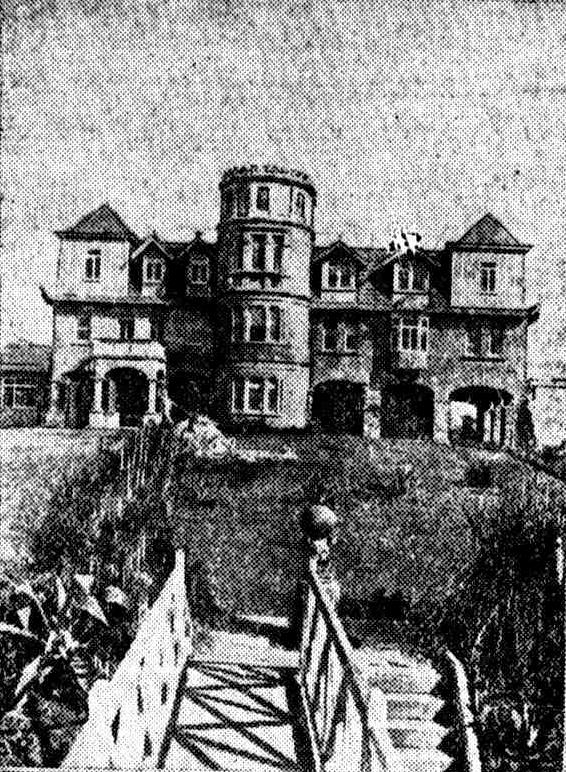
THE MONA VALE HYDRO.
Sydney Is indebted to the misdirected and inspired energy and enterprise of a man of whom, perhaps not one In five hundred knows anything at all for one of the most magnificent examples of palatial architecture that grace the outer circle of its environs. This beautiful and stately pile of buildings represents a great— a masterly— idea, which cost its unfortunate originator £25,000, and left him practically beggared. Sixteen or so years ago this man with an idea noted the great unclaimed swamp at 'Mona Vale— a stagnant lagoon, the only point in its favor being its proximity to a fine ocean beach, one of the many that enrich that much-favored stretch of coast from Manly up to Pittwater, and beyond. It occurred to him that if this useless blot upon the landscape could be drained an excellent seaside estate should result. And then the idea germinated. The unpromising-looking land was purchased for £600, and then the New South Wales Government was approached with the proposition that the buyer was prepared to spend £25,000 upon this site, providing a start was made upon the Pittwater tramway that had so long hovered mirage-like before the inhabitants of the district. .The Man with the Idea even offered to build the line' himself, should the Government withhold its hand, and called on the Minister for Works with a cash deposit of £10,000 to prove his sincerity. But the Government, apparently satisfied by these representations that the need of the district was pressing and genuine, promised to undertake the construction of the line a once. And the buyer, secure in the Government's promise, allowed his great idea to blossom instantly into the concrete expression of bricks and tiles and timber.
THE GREAT IDEA. And the idea was this: To build a huge village upon the drained lands of the estate, dominated by a magnificent clubhouse, and to sink £25,000 in the realisation of this immense scheme. To prove a financial success, access by tram to the estate was the one thing absolutely necessary. And this the Government had promised. The Man with the Idea set about the carrying out of his .purpose on a splendid scale. On the site he erected his own brickworks for the manufacture of the bricks and tiles: he bought a timber area at Erina Creek, on the Hawkesbury River, installed a timber mill and a planing machine as well, and so cut, freighted, and treated his own timber on the spot. He worked his own quarry, drawing from it all the needful stone, drained the swamp, obtained a regular water supply by the construction of a great brick and cement tank,' 20Ct. wide and 14ft. deep, and Installed a complete sewerage system. And all the while the promised tram was creeping out from Manly, slowly but surely. By the time it had reached Curl Curl, 12 months after its start, the walls of a mansion, or rather of a group of mansions, at Mona Vale were roof high, and the great idea was flowering in wood and stone and brick towards completion and perfection. The sum of £10,000 had already been sunk in initial expenses, and a further £15,000 borrowed to complete the work, and that work promised to be indeed a "thing of 'beauty and a joy forever." Forever, for the floors of the main building were built on a layer of concrete covered with a layer of bitumen and sawdust, upon which were laid 5000 hardwood sleepers, , and upon them another layer of sawdust and bitumen, and then the parquet flooring— a foundation impervious to white ants, and for all practical purposes everlasting. A hundred carpenters were at work, as well as a great host of other mechanics, and the loud ringing music of labor, which is the voice of progress, echoed and re-echoed' throughout Mona Vale. And the setting of the picture was as beautiful as the immense building rising under trowel and mallet and hammer. In the foreground two crescent-curves of hard, fine, sand, fronting the sea; beautiful green seaward sloping lands, and green embracing' bills. Meanwhile the grounds about the mansion were being decorated with statues and playing fountains, and among other costly and artistic fittings a great majolica mantel, that had originally cost £720, was In stalled in the entrance ball of the palatial place.. It was plain that the Man with the Idea had invested more than his mere capital In this sumptuous scheme. Something must have stirred in him that was akin to the emotions of all great builders, from Solomon of old and Darius the Persian, down to Christopher Wren and the designer of the flatiron building in New York. And Mona Vale on the New South Wales coast was in touch with the same spirit that reared the pyramids and built the Hanging Gardens of Babylon.
THE FATE OF THE SCHEME.
And it Is just here In the story that the fateful tram stopped. It had reached Curl Curl, one mile out from Manly, and there "it stayed, just 10 miles short of Mona Vale, and its waiting palace. Perhaps the authorities judged that a pleasant ten-mile tramp, bag in band, would be just the thing for intending guests, considering the invigorating air of the locality. Perhaps not. Anyhow, the mortgagors who had loaned their £15,000 in expectation of a tramline that would go a good deal further than Curl Curl Lagoon began to look dubious. Then, "at this psycho logical moment," as the novelists say, the Government that had guaranteed the tram bore tragic testimony to the instability of all human institutions, by going the way of all flesh. In short, it went out of office, and its tramline promise passed into the limbo of forgotten things, together with a variety of other departmental lumber. Matters began to look exceedingly serious. The £25,003 was gone, and although £5300 had been paid off the borrowed £15,000, a balance of £1000, which Included Interest, remained, and there was no Immediate prospect of the property returning it. But the Man with the Idea was not wholly beaten yet: Surmising that perhaps if a ready-made population were provided first, the tardy tram might reasonably be expected to follow them, he determined to sacrifice practically the whole of the area, including the recreation reserve, and the grounds surrounding the house, to pay the balance of the mortgage. The site had been actually surveyed for subdivision, when the wheel of his enterprise was effectually spiked again. The shire refused to approve of the plan until £1500 was deposited for the construction of the streets, and so, operations were again brought to a stand still. At this point the unfortunate successor of Darius, Barneses', and Christopher Wren was informed that the Government wished to purchase the entire property as it stood, and desired to know his price. ' He named the comparatively utterly insignificant sum of £7500, explaining that he needed £6500 to pay off the mortgagors, and £1000 to wipe off money owing for material supplied. He did not ask for one Sixpence for himself; only for sufficient to clear him of his obligations. He had failed, losing everything; but he wished to face the world with a clean sheet. However, the Government's emissary, after hearing the story, went to the mortgagors to negotiate. Naturally all they asked for was their £6500, and the Government, falling in with this request, took over the entire concern for that sum. So the Man with the Idea was turned adrift with £1000 worth of debts upon his shoulders, and not a penny saved from the wreck: while his £25,000 palace had been sold for £6500 Such is the story of Brock’s Mansion at Mona Vale, and surely the misfortune of the unlucky builder from whom it takes its name is almost unique.
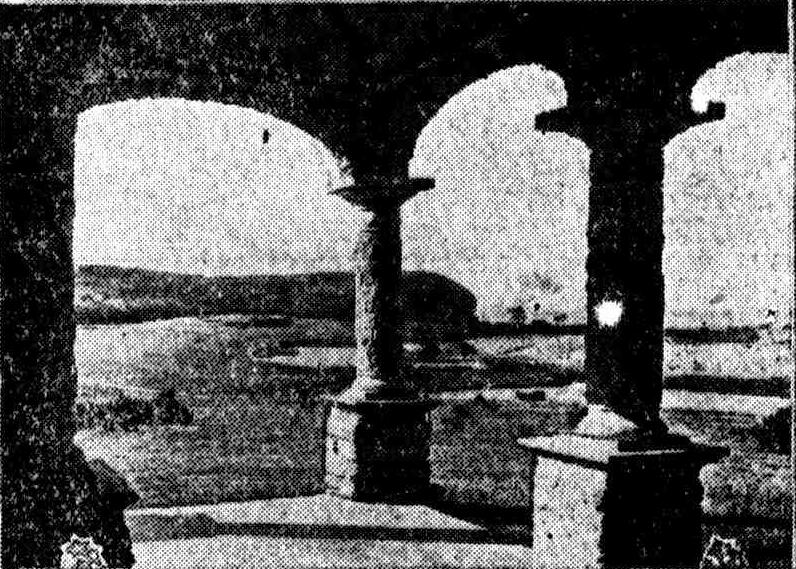
BROCK'S ESTATE FROM THE HYDRO.
BROCK'S ESTATE TO BE SOLD.
The sequel to the story of what has come to be known as "Brock's' Folly" promises to be good reading. It will doubtless prove a tale of pioneering such as all Australians delight in. There is every' Indication that In a few years the magnificent estate which was intended for the mansion grounds will become the scene of one of the most beautiful seaside settlements in the State. Mona Vale might have been designed by Nature as a resort of rest and delicious peace. Brock's Estate fronts two horseshoe-shaped beaches of hard yellow sand, on which the surf breaks soothingly, for the formation of the beaches provides splendid shelter against the occasional fierceness of the ocean's ebb and flow. 'Surf-bathing may therefore be indulged in with the greatest possible safety. All the pleasures of surfing arc to be gained there without any of Its discomforts. The coastline thus shaped is extremely pretty. Far away to Barranjoey is a succession of delightful little bays, forming; a- seascape' of quiet beauty.
SEASHORE JEWELS. ; The magnificent coastline that encompasses the Hole in the Wall, The Cave and Little Head is only just beginning to be known and appreciated. Between the Brock Estate and Manly the coast is better known, and is as picturesque as anywhere around -the continent. About three miles to the south are the Narrabeen Lakes fronted by that long stretch of beach that has made Narrabeen such a famous resort. Farther south still are Long Reef, Deewhy, Fresh water, and Curl Curl. The entire coastline, therefore, for miles in each direction forms a rich necklace of seashore jewels that grow in value as years go on. It will be very surprising if the whole of the 18 miles of coast between Manly and Barrenjoey does not attract a large population and become a famous pleasure zone.
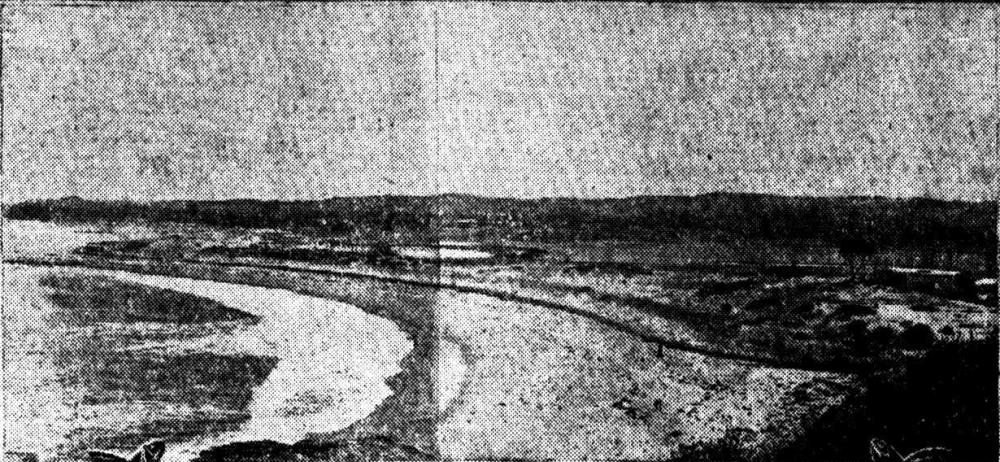
THE BEACH FRONTING BROCK'S ESTATE.
MAGNIFICENT LANDSCAPES. Some of the landscapes surrounding this Brock Estate would be worthy 'subjects for the brush of a Turner or a Corot. As one approaches it from the Newport-road, for in stance, an entrancing view is met with, the road winding prettily through undulating country, magnificently timbered and clad- with wild flowers. The property itself lies in a hollow of a cup like appearance, and on every side save the east it is protected by glorious hills. One can therefore enjoy all the benefits of the sea, air without the discomforts of the gales. The large fortune spent originally on this estate has made it a model site for fine homes. What Mr. Brock left undone Mr. Arthur Rickard has accomplished, and I see that next Anniversary Day that enterprising gentleman will offer those fine allotments to the public. Truly, they are very tempting morsels of the earth's surface, and especially so because the estate is splendidly subdivided and good wide streets, made throughout. The allotments are exceptionally large, and as the soil is excellent, the week-ender who purchases one of them may have a perfect orgie of flower and fruit-growing. If example goes for anything this estate should be the scene of some beautiful homos in the near future, for not only the mansion but several adjacent buildings have set a high architectural standard. 'Since Pott Pointing, has given way to week-ending It is quite likely that palatial residences will adorn this spot, especially as there Is no other land with ocean frontages for sale near there.
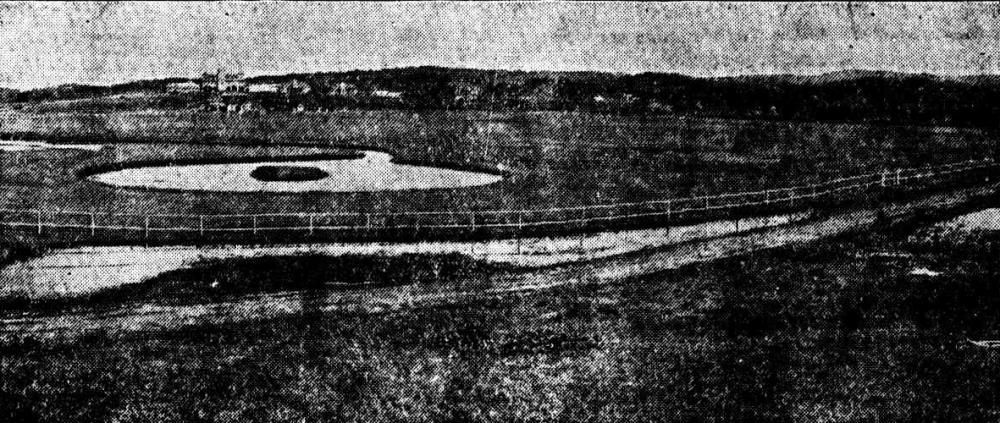
A SECTION OF BROCK'S ESTATE.
A GOOD INVESTMENT. The only need for the development of this fine area of country Is the tram, but the Newport extension may be regarded as a certainty and only a matter of time. The surveyed route, I am Informed, is along the road which fronts Brock's Estate. Although no definite promise has been given, it is generally understood that the tramline will shortly be proceeded with. When this is accomplished the estate will be within a comparatively short tram ride of Manly, and therefore within easy reach of the city. In these days of rapid transit and, a growing inclination, to plant homes in broad spaces, Mona Vale need not be considered too distant. The trip all the way from the city is such a glorious one that the travel-loving Sydney man will doubtless regard the distance as more of an advantage than otherwise. As an Investment, of course, property In this locality is a particularly good thing at present, for when the work on the tramline does start values are bound to take a leap 'upwards, and - there is no likelihood of them ever coming down again. Week-end holiday makers would do well to wait for Anniversary Day, as there might be a chance of getting in on this excellent proposition at bargain prices.
THE MANSION AS A HYDRO. On Thursday, last Brock's Mansion came Into its own when It was opened by Mrs.- Arthur Griffith, wife of the Minister for Public Works, as a hydro. At the invitation of Mr. Arthur Rickard (lessor) and Mr.' F. W. Fox (lessee) a large number of people attended, and the ceremony, which has already been reported in "The Sun", was a complete success. No better idea could have been conceived than to convert this magnificent building into a hydro. Mr. F. W. Fox, who is a well-known gentleman, and has been long and honorably identified with city business life, and his good lady, Mrs. Foy (who has large and fashionable guest establishments at Neutral Bay), are to be complimented upon their enterprise in undertaking this venture, and deserve every possible success. For several years past, and particularly since surf-bathing became popular, the need has been felt of a really first-class accommodation house near the seashore. The hotels and boarding-houses at the beaches have proved, inadequate to accommodate, in the best style the great and growing number of families who desire to spend their summer vacation at the seaside. Taking a furnished cottage is the only other, alternative, and this has decided disadvantages. In the first place, the majority of people cannot afford a sufficiently long vacation to make it worth while. Again, the responsibility of house keeping greatly detracts from the pleasure of a holiday. Is it any wonder then that the question is asked again and again: "Where is there a really first-class place to stay, at the sea side, where one may enjoy every comfort and have absolute peace and quiet— a place equal to the resorts of Europe and America?" We now have the answer: in the Mona Vale Hydro. The building alone is a source of never-ending delight. It is as the pictures denote, a palatial structure, and an architectural triumph. The decorations, both externally and Internally, are extremely artistic, and a constant pleasure to the eye. This octagonal building is constructed of brick and wood. The upper portion contains a ballroom 42 x 42, with a specially-constructed floor. The main entrance hall is lavish, and the mansion contains, all beautifully designed, a -billiard-room, ladies' lounge, promenade roof, smoke-room, ballroom, and theatre. The dining hall, which, is about 36'x 72 feet, is very large, and Imposing. The sights of the building alone should prove a continual joy to those who are fortunate enough to secure apartments there. It is quite a pleasure to roam around the mansion with its great staircases, its stained glass windows, its huge columns, Its beautiful mantels, and the general ornateness of its spacious rooms. There are 25 bedrooms and six bathrooms in the main building, though there are adjacent cottages where there is more accommodation. One of these, for example, is extremely handsome with its tiled roof and its large crescent-shaped tiled verandah with bay windows on each side. The front door of this villa gives entrance to a very large reception room, and attached to the premises there is a studio and music saloon, built of brick, with large lead-light, windows and wood-panelled ceilings. Both from, the Mansion and the adjoining buildings glorious views are to be obtained. For miles the coast, broken into enchanting bays and coves, yields a panorama of great beauty, and the charming undulating character of the back country reveals some exquisite landscapes. Here, then, is delicious peacefulness and rest with nature smiling all around one. Everything has been done by Mr. Fox to ensure the comfort of his guests. He has arranged a cuisine of the highest standard; hot and cold baths are to be obtained in plenty; every room is handsomely furnished; there is a large motor garage and accessories.
The hydro is particularly well suited to business men who desire to get away from the city for a few weeks and recuperate their physical and mental faculties, or for country people who need a change at the seaside. No better place than this could be found for the enjoyment of all healthy natural pleasures. What was intended as a racecourse and polo ground now makes ideal golf links, and devotees of this sport could not be better provided for.
As already pointed out, surf-bathing may be enjoyed with every degree of comfort and safety. There are also facilities for tennis and cricket, and plenty of good fishing may be obtained. The hydro is, therefore, not only a magnificent structure sumptuously furnished— it is the home site of all those pleasures that do most to make life worth living. A convenient motor service to and from Manly has been established, and the business man who must attend the city daily is thoroughly provided for in the time-table. For the benefit of the touring -motorist; equestrians, and others, Mr. Fox has arranged to cater for lunches, dinners, and afternoon teas, and can provide for parties or picnics of any description by previous notice.
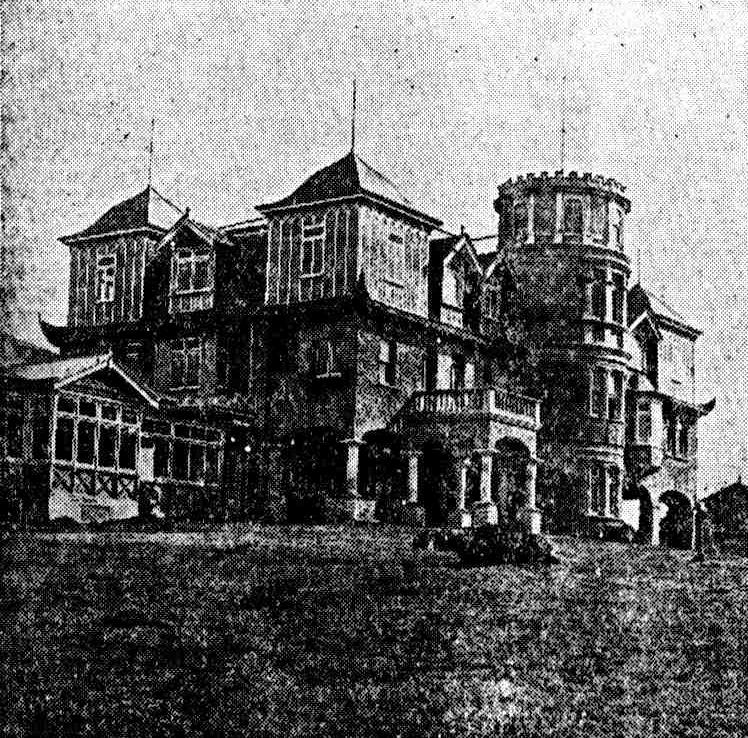
ANOTHER VIEW OF THE HYDRO.
WHERE TO SPEND THE WEEK END. (1910, December 25). The Sun : Sunday Edition (Sydney, NSW : 1910), p. 11. Retrieved from http://nla.gov.au/nla.news-article231015197
The Fox-Foy 'Hydro' didn't last long. Sources state the building was renamed 'La Corniche' by Rainaud, a French Restaurateur who originally ran a successful tea room, restaurant and boarding house at Church Point-Bayview until a tragedy. He brought the name with him when taking over these premises. Visit: La Corniche, Bayview
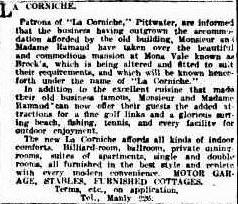 Advertising. (1911, September 9). The Sydney Morning Herald (NSW : 1842 - 1954), p. 18. Retrieved from http://nla.gov.au/nla.news-article15272695
Advertising. (1911, September 9). The Sydney Morning Herald (NSW : 1842 - 1954), p. 18. Retrieved from http://nla.gov.au/nla.news-article15272695
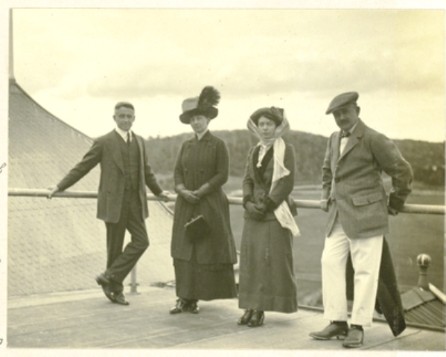
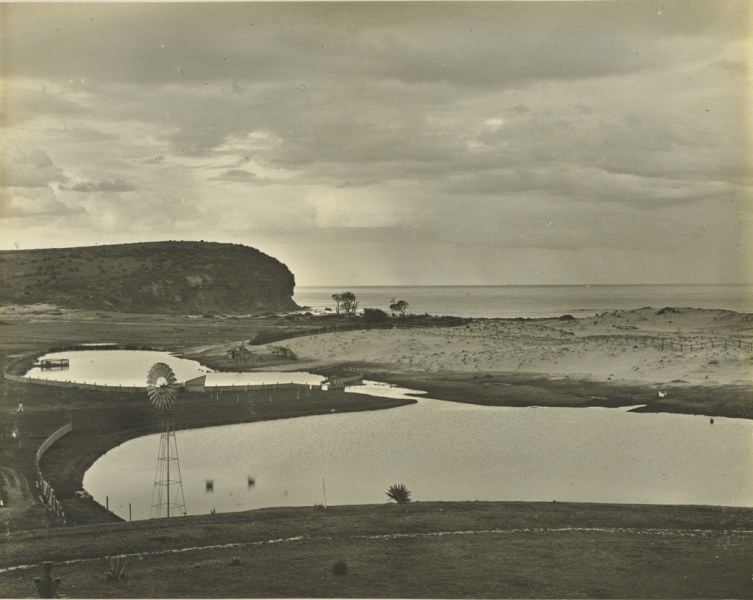
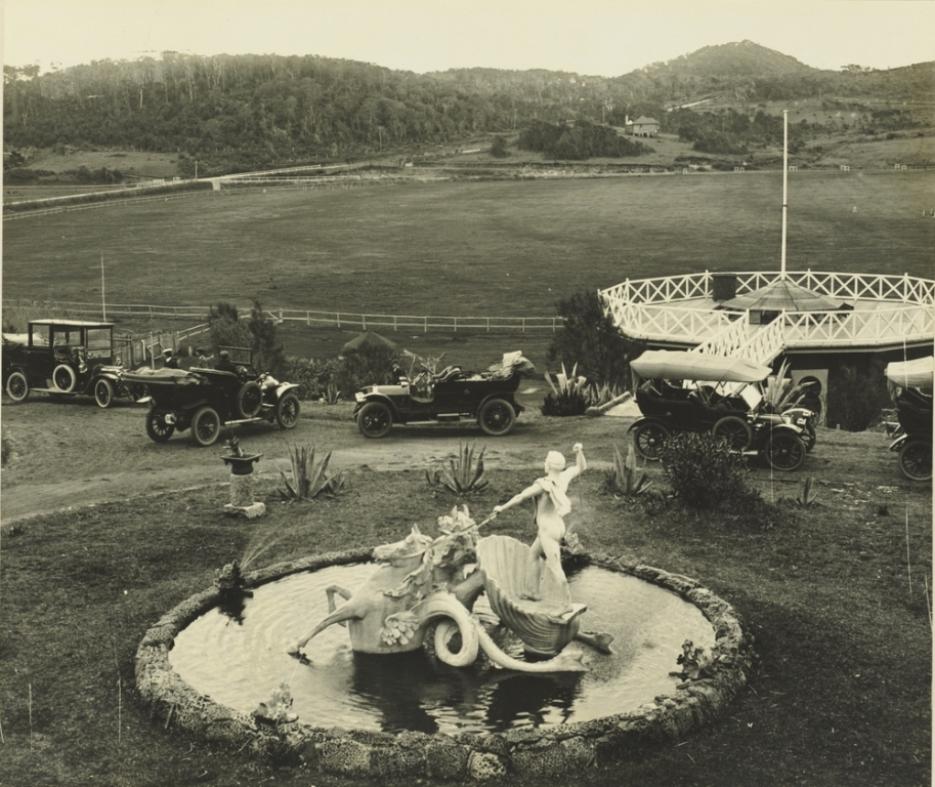
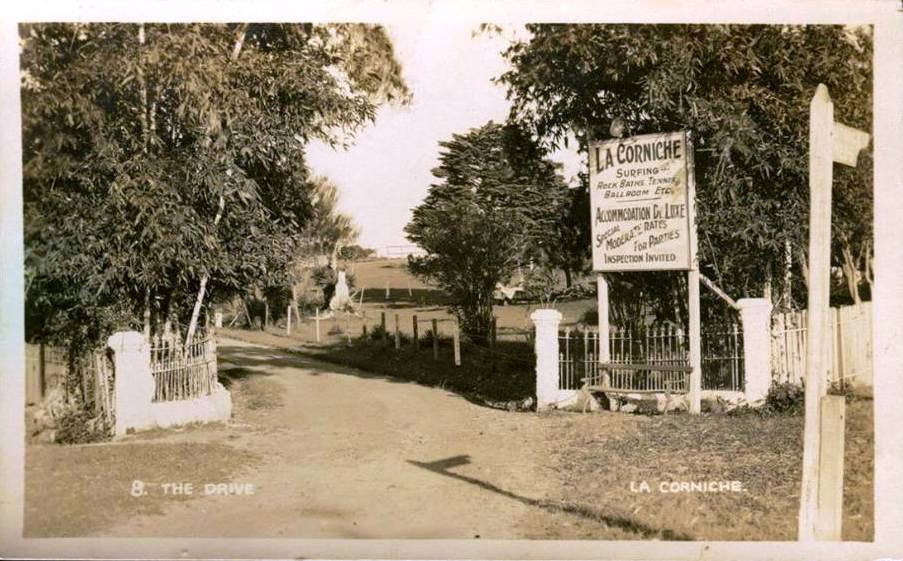
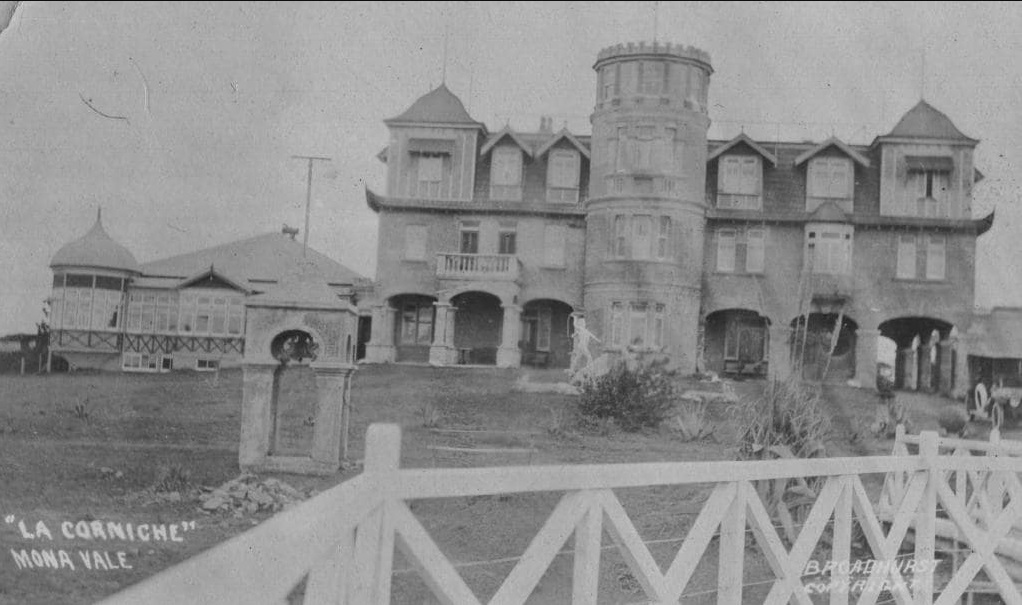
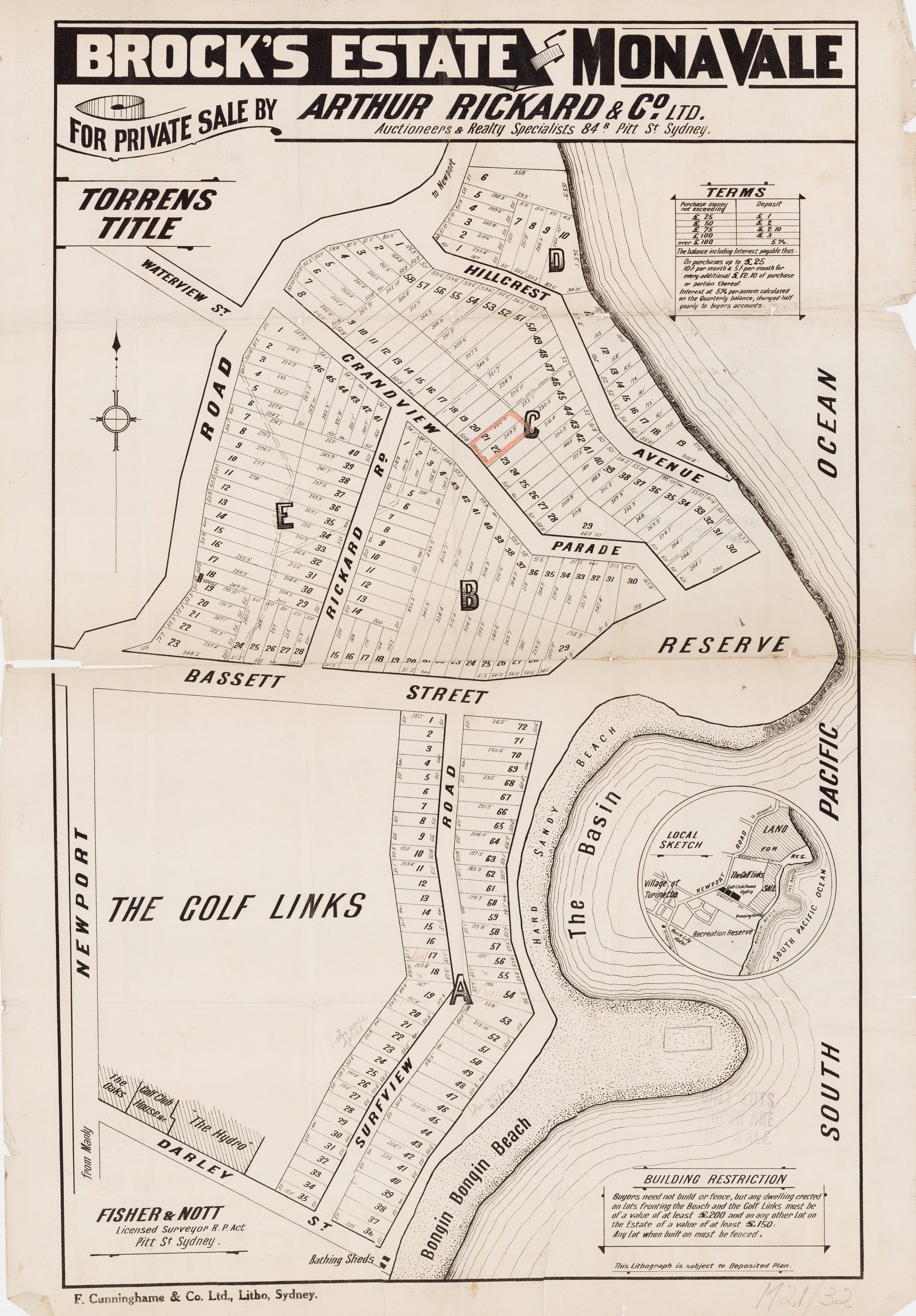
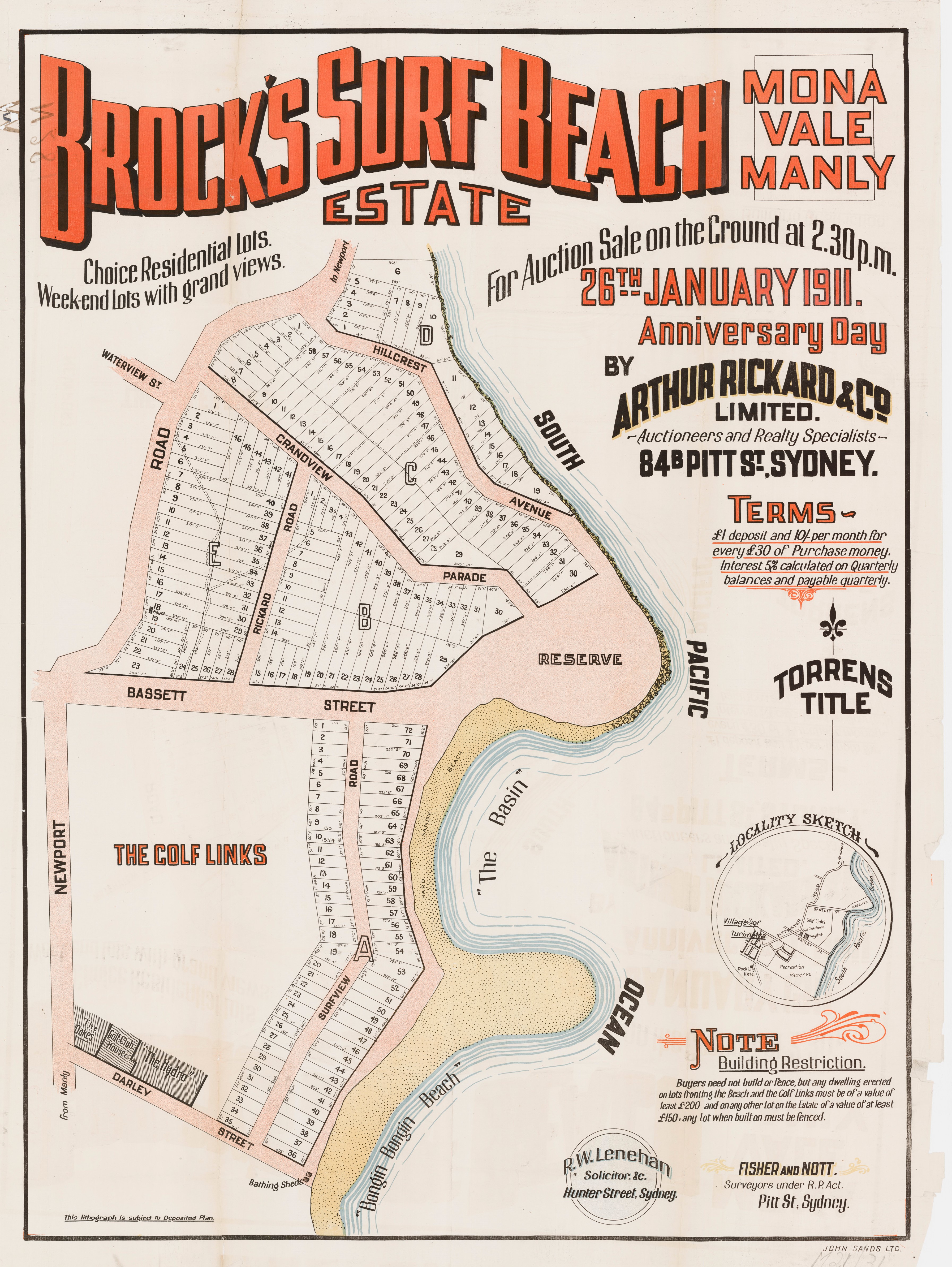
BROCK'S MANSION BURNED.
BIG BLAZE AT MONA VALE. beautiful landmark destroyed.
Damage estimated at £12,000.
No fire- fighting appliances available.
"La Corniche," a mansion at Mona Vale, which occupied a commanding position on the road between Manly and Newport, was destroyed by fire early this morning. Flames were discovered at 10 minutes to 1. At half-past 2 only portions of the walls, and they rickety, were standing.
The building was palatial In Its dimensions and appointments, and contained in all 38 rooms, 28 of which were bedrooms. It was originally designed for The Oaks Polo Club, and was built by Mr. G. S. Brock at a cost which has been set down at £32,000. Before the building was completed, however, it was acquired by Mr. Arthur Rickard, who brought It up to date and then let It to M. and Mme. Rainaud, at one time chef to Sir Harry Rawson. Instead of being used as a polo club it became a fashionable boardinghouse, and on account of its situation and its surroundings, including surfing and golf, it became exceedingly popular. There were 30 boarders in the place at the time of the fire.
The fire started in the large dining hall, and was discovered before it had a very strong hold of the room, but not in time to be beaten out. There was a hue and cry raised throughout the building, and boarders were running to and fro to ascertain the extent of, their danger and the possibilities of saving their effects. The flames spread with great rapidity, but happily not In the direction of the staircase, and many of the people were, therefore, able to dash about and get their property outside.
Those on the second and third floors, however, did not take the risk which running up and down the stairs involved, and threw most of their belongings out of the windows. In ten minutes the flames -had begun to light up the hills on either side, and to throw long reflections out to sea. The boarders were all out of the building by ' this .time, and the menfolk were assisting the staff (numbering 20) to remove the furniture. They continued in this until the flames drove them back, and were successful in getting out a piano and other big stuff. But What was saved was a mere fraction of what was lost.
All that the people could do was to stand by and watch. There was water— the sea could be heard roaring in to shore all the time — but there was no means of pumping it into the building. No fire-fighting appliances which would avail anything were kept on the premises, there is no depot in the vicinity, and though a boarder motored to Manly post haste and reported the blaze the firemen did not go out, because they could have done nothing if they had.
There were very few incidents in connection with the fire. Everybody was got out expeditiously, and though there were several cases where ladles fainted they were never in danger. Even the pets of the house were saved, though one had a narrow escape. It was a little white pussy, and it mewed and mewed pitifully on the window sill of a room from which smoke was already issuing. One of the girls attached to the staff saw its plight and darted into the building and out again with her charge in a few seconds.
Mr. Scott Fell, who has a house in the grounds of La Corniche, provided accommodation for the boarders for the rest of the night. As bad as the consequences were they might have been worse. If the blaze, for instance, had started nearer to the stairway than it did, it is quite possible that the escape of the boarders would have been cut off, and the only exit would have been through the windows, a course . of action which would practically have endangered limbs if not life. Then, again, the wind was blowing out to sea. Had it blown from the sea, it Is not unlikely that two cottages and the Casino, nearer the roadway, would have gone, while the motor garage, where four motor-cars were kept, would almost certainly have been gutted.
The most remarkable circumstance in connection with the fire was associated with the telephone. When the blaze was found to be so serious Mr. A. Davis tore the 'phone from the wall and carried it outside. Later in the morning an electrician fitted it up on to the fence— the only piece of the fence which escaped the flames— and a trial showed that though the wires had been through the heat of the flames, the 'phone was still in order, and the Manly exchange could be distinctly heard. The boarders relished the good fortune, because it enabled them to send reassuring messages to their friends.
Mr. Rickard stated this morning that the building and furniture was insured in the New Zealand Insurance Co. for £6000, and that he was therefore a fairly heavy loser, seeing that his estimate of the value of the building was £10,000. The furniture was valued at £2000. Mrs. Mueller (wife of Dr. Mueller, of Macquarie-street), Messrs. Harvey, A-. Davis Earle Hermann, Toohey, L. A. and R. V. Minnett, Lotrois, and others of the boarders, were also sufferers by the fire. Mr. Rainaud lost silver, linen, &c., to the value of £250, which was uninsured.
The origin of the fire cannot he determined, but It is believed that It was caused by a lighted match or cigar butt carelessly thrown on to the carpet in the dining-room. Mrs. Rainaud heard a noise in the dining-room, which she attributed to burglars, and on getting out of bed found the place ablaze.

Mona Vale Hydro, the scene of a disastrous fire which occurred in the early hours of this morning. BROCK'S MANSION BURNED. (1912, January 8). The Sun (Sydney, NSW : 1910 - 1954), p. 1. Retrieved from http://nla.gov.au/nla.news-article222004219
AN UNLUCKY BUILDER.
man who was before his time.
The total destruction of the beautiful "La Corniche," better known as Brock's Mansion', at Mona Vale, in the early hours of this morning robs the naturally beautiful tourist journey from Manly to Pittwater of one of its, leading attractions. This magnificent pile of buildings, with Its charming surroundings, has always excited the admiration of the traveller, and the story of Its building by Mr. Brock, and its passing out or his hands after all his Napoleonic' work, has, always won- the stranger's keen sympathy. Mr. Brock gave the best years of his life to the realisation of his Idea to provide a high-class hotel on the lines of a great country home on this unrivalled site, which provides all the delights of ocean, lagoon, and green hills. His-choice of a spot could not have been Improved on with Its glorious ocean views, and after great work in levelling and draining what was a great swamp he evolved a fine polo ground and racecourse on the flat. Six years ago there were no less than 44 polo ponies on the ground.
When Mr. Brock started the buildings he set up his own brickyards and sawmills. Everything he used came from his district In this connection he showed his patriotism by employing only local labor, and for several years he was a benefactor to the neighborhood, his expenditure going Into many thousands.
It may he said that before Mr. Brock started his great undertaking he had the assurance of the Government then in power that the tram to Pittwater would be constructed at once. He went on with his work, spent many thousands, and just when he was within reach of his goal his money ran out, and he lost all his claims to the property, and the results of his labor for years. AN UNLUCKY BUILDER. (1912, January 8). The Sun (Sydney, NSW : 1910 - 1954), p. 1. Retrieved from http://nla.gov.au/nla.news-article222004175
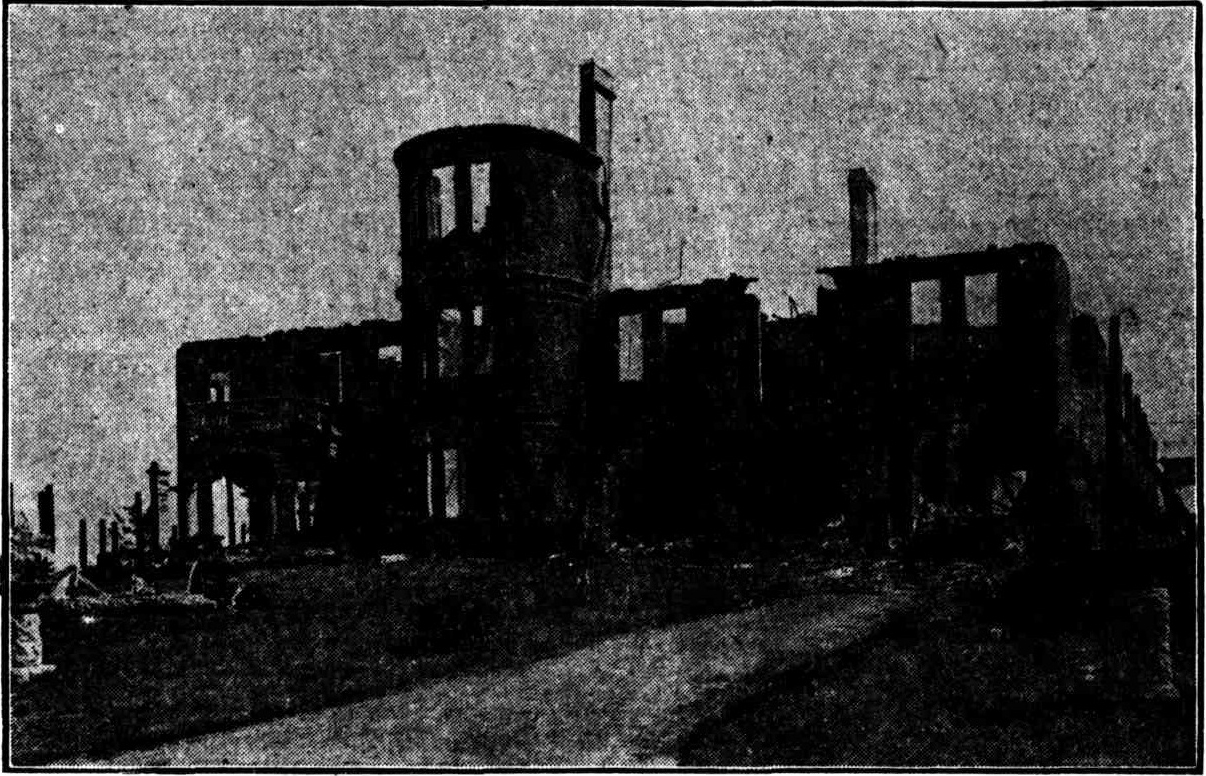
Ruins of "Brock's Mansions," at Mona Vale, destroyed by fire on Monday morning. The fate of the handsome pile of buildings is a grim finale to the financial tragedy that overtook the plucky builder, Mr. G. S . Brock, in its erection. No title (1912, January 10 - Wednesday). The Sun (Sydney, NSW : 1910 - 1954), p. 1 (FINAL EXTRA). Retrieved from http://nla.gov.au/nla.news-article222002216
A disastrous fire, which happily did not result, as might easily have been the case, in loss of life, took place at an early hour yesterday morning. It occurred in a large boarding establishment at Mona Vale, Newport, known formerly as "Brock's Mansion," and latterly as "La Corniche," which was completely destroyed. The property is that of Mr. Arthur Rickard.
The cause of the fire is as yet unknown, but at about 5 minutes to 1 a.m. some of the occupants of the house were aroused to a sense of danger by a strong smell of smoke. On Investigation the fire was located In the dining-room, and it was at once seen that any efforts to check the flames would be hopeless, and the Inmates were simply got out of the house as quickly as possible. Fortunately there were no signs of panic, and In a few minutes everybody was safely outside-watching the flames eating up the large building with a blaze that Illuminated the landscape for a considerable distance.
Owing to the inaccessibility of the locality no fire-engines, or, indeed, means of any water for fighting the fire, were available, and soon the whole building was reduced to ruins. The place, which Is said to have cost Its builder £30,000, was Insured for £6000 In the New Zealand Insurance Company; but the loss to the present owner Is estimated at about £10,000. Something like £250 worth of books, silver, and linen was not insured at all, and was totally destroyed. The building, which was a large one, contained 37 rooms. There were about 30 boarders in the house when the outbreak occurred.
A rather pathetic history attaches to the now smouldering building. Some years ago Mr. Brock, of Enmore, a gentleman with an enterprising idea, was so struck by the beauty and natural advantages of Mona Vale district that he originated a plan to establish and conduct an elaborate tourist home and sanatorium there, similar to Medlow Bath. Mr.Brock approached the Government of the day and laid his scheme before the Minister having charge of the railway and tramway construction branch, with a view to securing tramway communication to the spot. The scheme appeared so genuine and sound that Mr. Brock was given the assurance that, if the work was commenced, the tramway would be considered. He then set to work and laid out the grounds, and brought along his building material, establishing brickworks and a saw mill.
The tramway proposal from Manly was also favourably considered, and surveyors were sent to Manly. £30,000 was spent on the building by Mr. Brock. It assumed gigantic proportions, and when nearing completion formed one of the principal landmarks along the coast. The grounds were laid out to perfection, and included a racecourse, golf-links, and polo grounds. A fine surf-bathing beach also formed part of the establishment.
The tram meanwhile was constructed only as far as North Manly, a distance of one mile. The Minister for Works, Mr. E. W. O'Sullivan, who had worked hard for the extension, left office. The non-completion of the tramway was disastrous to Mr. Brock, as the financial success of the enterprise depended largely on tramway facilities being given to the sanatorium. The premises soon changed hands, Mr. Brock being a heavy loser.
Recently the greater part of the property was put up for auction sale by Mr. Arthur Rickard and sold at a good figure. The name of the building was changed to "La Corniche," and was utilised as a boarding establishment by the proprietor, who has now sustained a great loss by the fire.
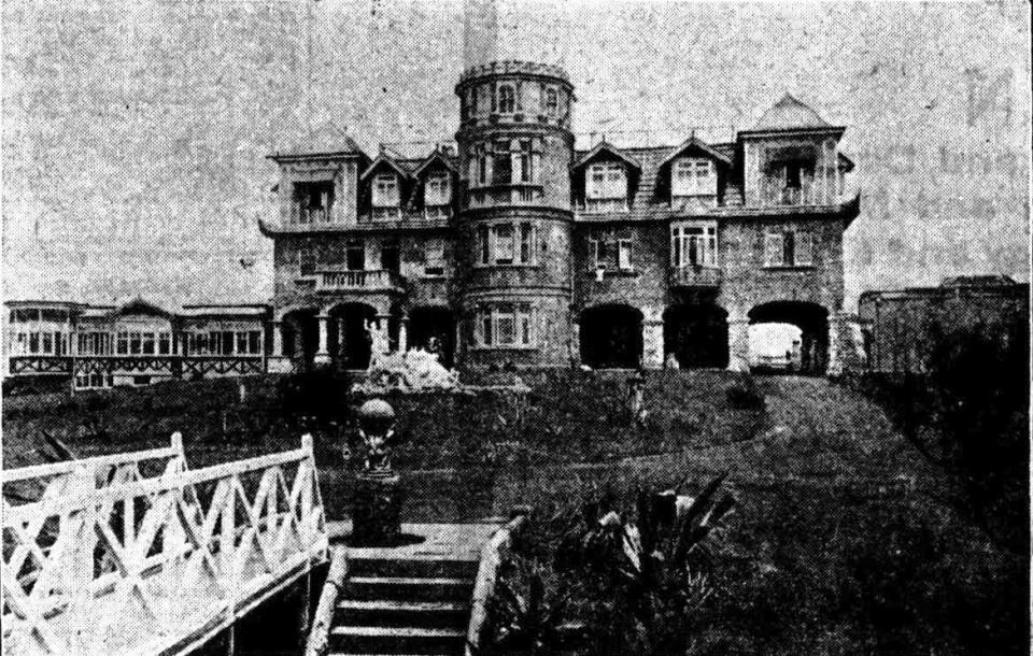
After the fire at La Corniche Mona Vale, in January 1912, the Rainauds started a new venture in town:
About 10 years ago there arrived In Sydney Monsieur Rainaud, a French genius in the art of cooking, with a knowledge of the needs of the inner man and woman that was (second to none as far as Continental training) and experience were concerned. He conceived the idea of opening a Rotisserie Parisienne in the centre of the city to supply meals to people living at any reasonable distance from his establishment. But the tremendous possibilities of the thing did not appear to "grip" at the moment. The people were only just awakening to the problems of home life. Now they are fully awake. To get a decent meal in Sydney at a reasonable price, hot and hasty and tasty from the fire, is sometimes difficult. In August it will be easy. Sydney is to have its Rotisserie Parisienne. M. Rainaud has gradually been evolving his plan.
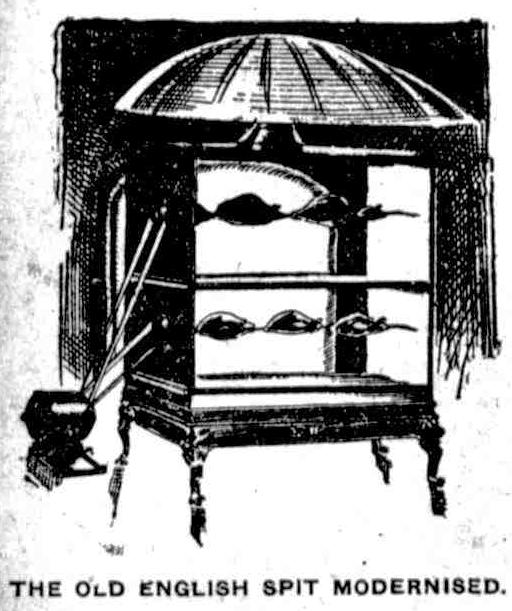
During his period of service as head chef to Governor Sir Harry Rawson, and later when he was presiding over the culinary delights of La Corniche at Bayview, this French artist in food was thinking out the details of his scheme, and now it is almost an accomplished fact. An elegant shop in Culwulla-chambers, at the corner of King and Castlereagh streets, will be the distributing centre. This shop will be fitted up as a palatial, comfortably-furnished lounge. No meals will be served on the premises but ladies will be able to go there, see the menus, and order what they will need in their households day by day. There will be a wide range from which to make choice. All that, is best and, most inexpensive will be there. All that is reasonable in price will be there. Dainties from all parts of the world will be available as the liners bring them into Port Jackson, and all Australia's delightful products In meats, and game, and vegetables, and fruit, as well as the confections in pastry and ices that the best French chefs and experts can devise, will be procurable in a bewildering variety. A feature of the new Rotisserie Parisienne will be the old English spit, where the game and joints will be roasted in full view of the public. M. and Mme. Rainaud guarantee that the appetising odors that this branch of the business will give off will be the finest advertisement possible. Special boxes have been constructed to contain the, hot viands and to retain all their spiciness and tastiness. FEED THE BRUTE (1913, July 13). The Sun (Sydney, NSW : 1910 - 1954), p. 20. Retrieved from http://nla.gov.au/nla.news-article229686457
This Auction and land sale just a little over a year after the fire shows what buildings weren't destroyed and the location of Mr. William Scot-Fell's property. There is more information about him in Roads To Pittwater: The Sandspit Punt and Spit Bridge
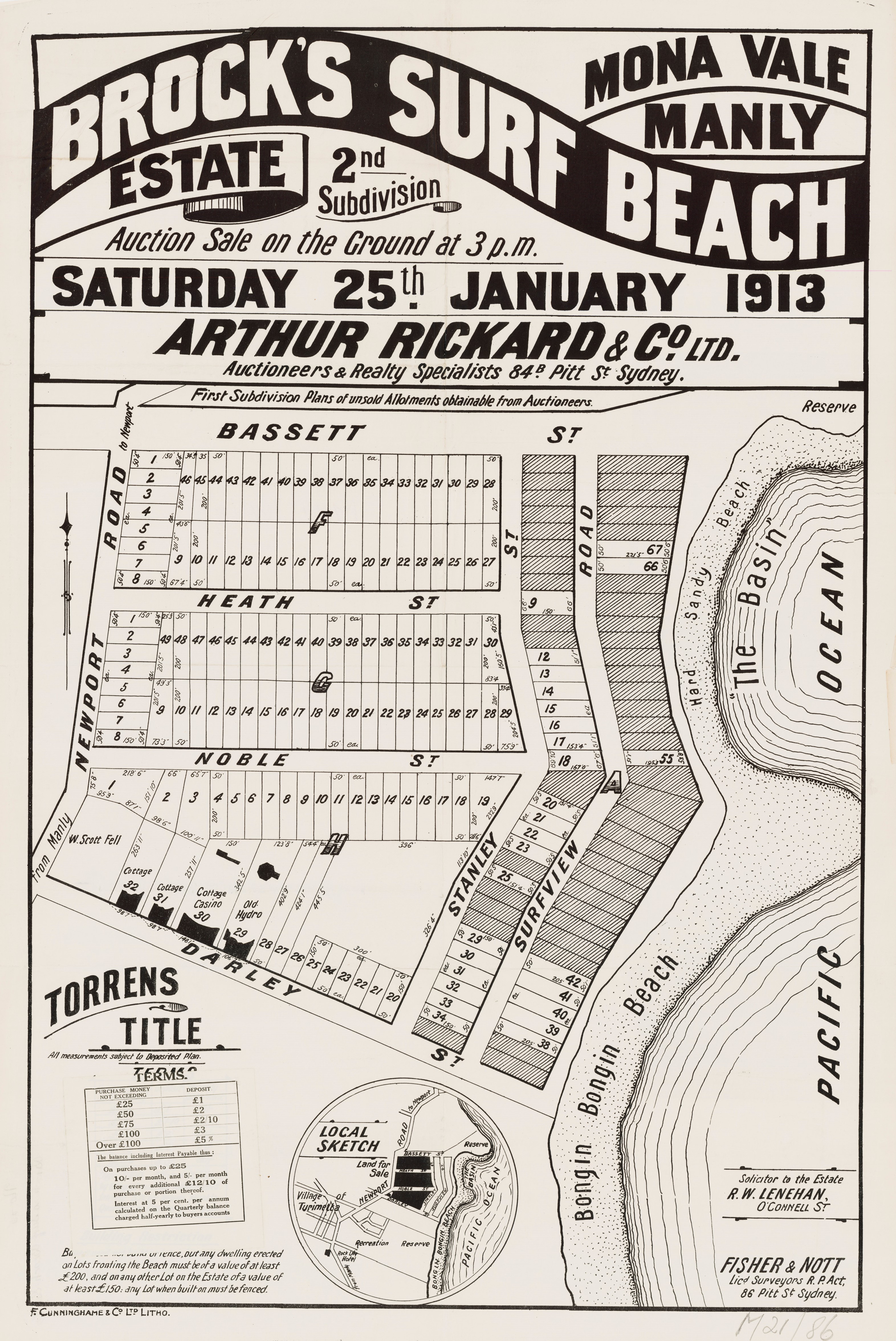
Brock's Surf Beach Estate - Mona Vale - Manly - 2nd Subdivison; shows location of Scott-Fell land and beach still called 'Bongin Bongin' 1913. Item No.: c046820086, from Mona Vale Subdivisions, courtesy State Library of New South Wales
The structure was rebuilt, in part.
 of Copy of la corniche phoenix 2.jpg?timestamp=1525924994823)
 of la corniche phoenix 2.jpg?timestamp=1525925051551)
 of la corniche phoenix 2.jpg?timestamp=1525925081669)
 of la corniche phoenix 2.jpg?timestamp=1525925104843)
 of la corniche phoenix 2.jpg?timestamp=1525925128958)
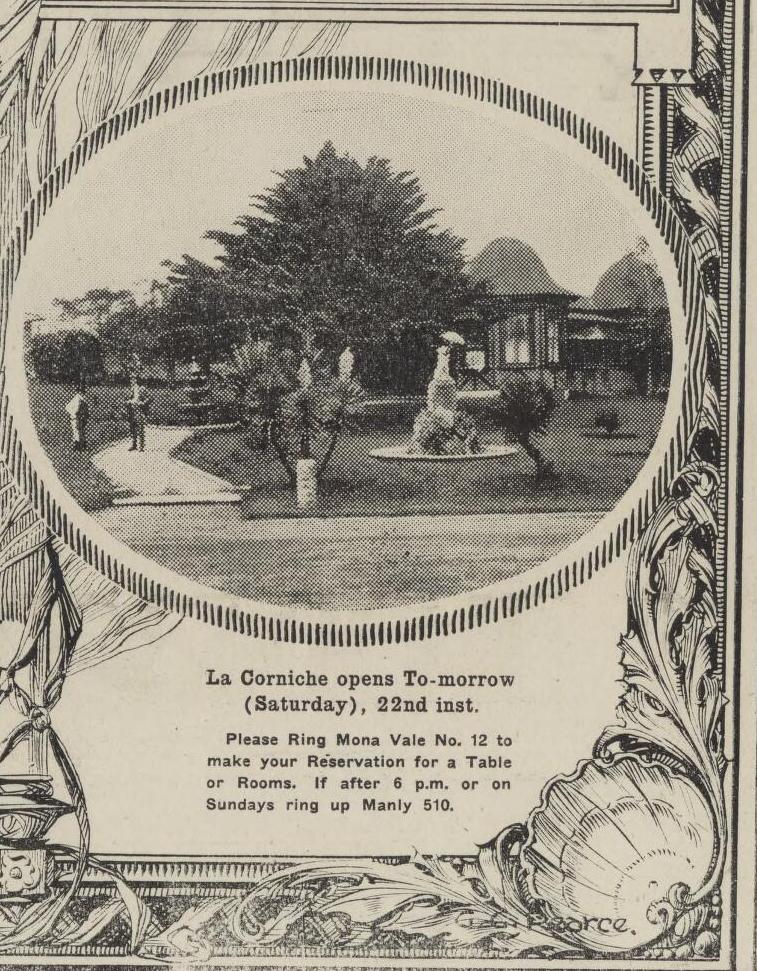
Pearce, G. C. (1920). Like a phoenix from its ashes, the resurrection of "La Corniche" at Mona Vale - and sections from to show details. Retrieved from http://nla.gov.au/nla.obj-67694921
The sales continued:
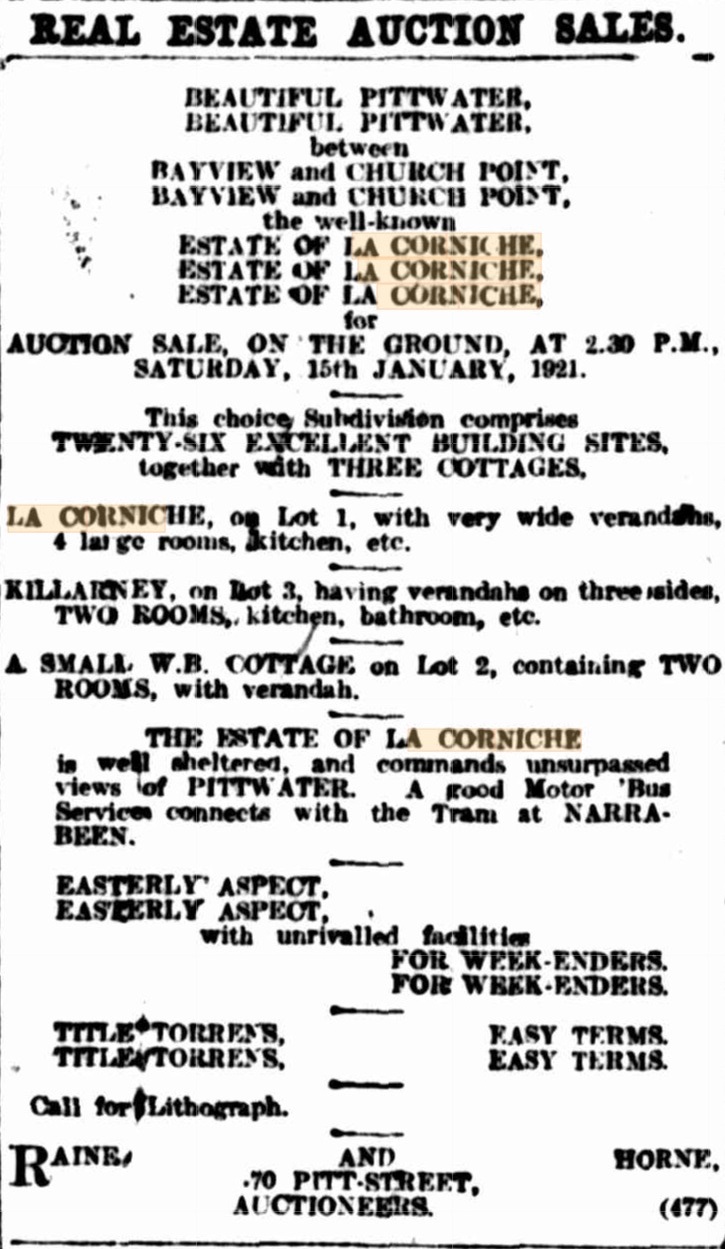
Advertising (1920, December 25). The Sydney Morning Herald (NSW : 1842 - 1954), p. 11. Retrieved from http://nla.gov.au/nla.news-article16881633 - sale of buildings - La Corniche mansion and 2 x cottages
.jpg?timestamp=1563838434187)
Advertising (1921, January 21). The Sun (Sydney, NSW : 1910 - 1954), p. 9 (FINAL EXTRA). Retrieved from http://nla.gov.au/nla.news-article221436292 - same advertisement as NLA mterial above
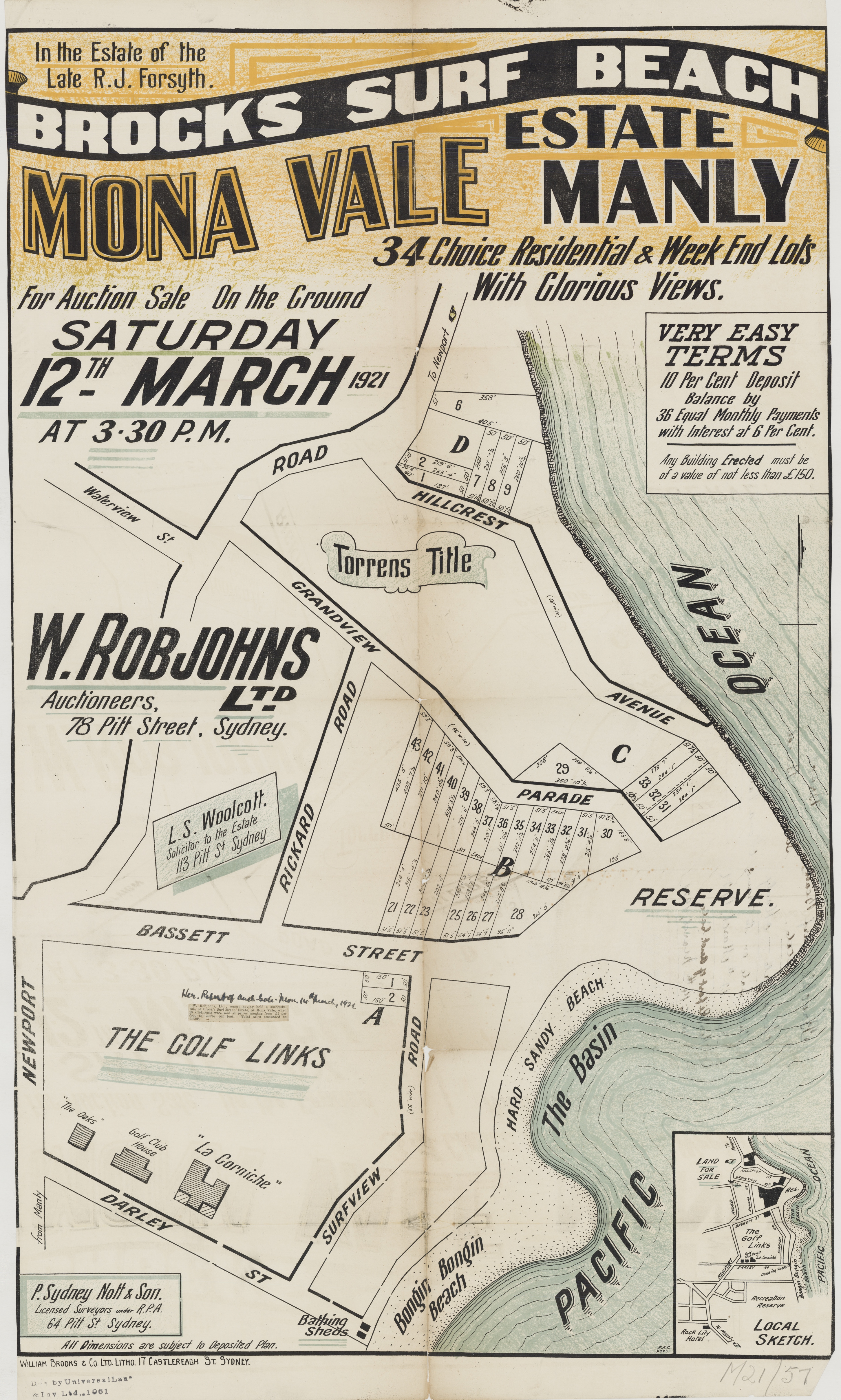
R J Forsyth
Robert James Forsyth was born in 1861 to Archibald Forsyth and Annie (nee Corbett). He was a member of the prominent rope making company, named Archibald Forsyth & Co. after his father Archibald. Annie Forsyth Wyatt, after whom we have a Palm Beach Reserve named and who was a visitor to our area during tree planting days through local schools, was a niece. George Alfred Forsyth of Bayview, Gentleman, who once owned Waiwera, the cottage (before it became Hopton Lodge), was also a relative of (uncle) of Annie Forsyth Wyatt
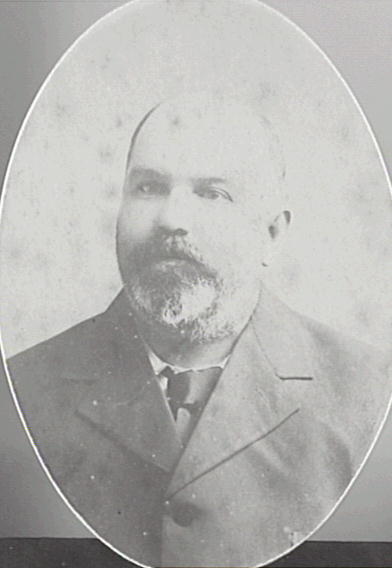
Ald. Robert J Forsyth City of Canterbury, 1901
Children:
Robert Archibald Forsyth, b. About 1892-1893, to Robert James and Agnes Christina d. 6 May 1918, Rouen, France.
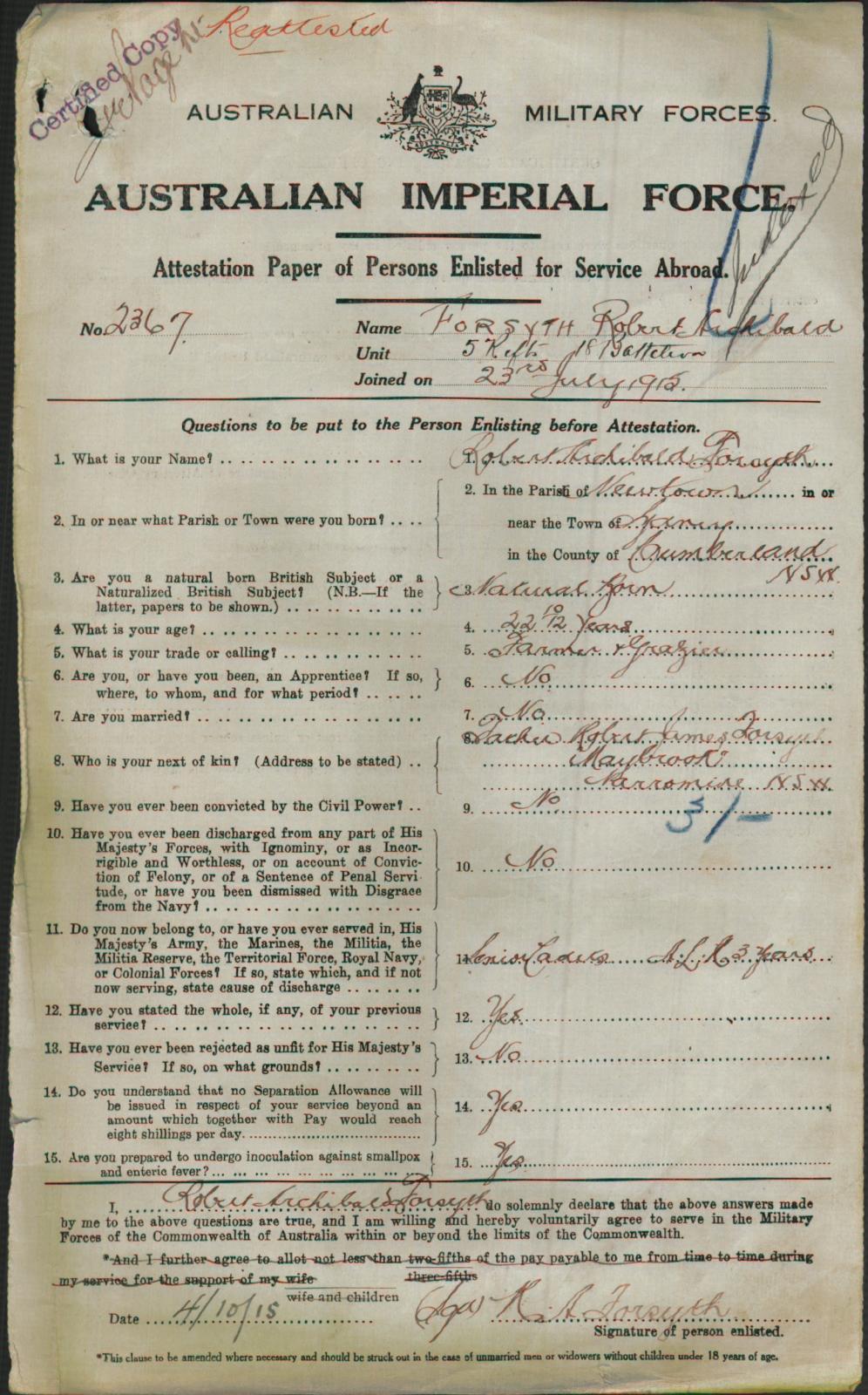
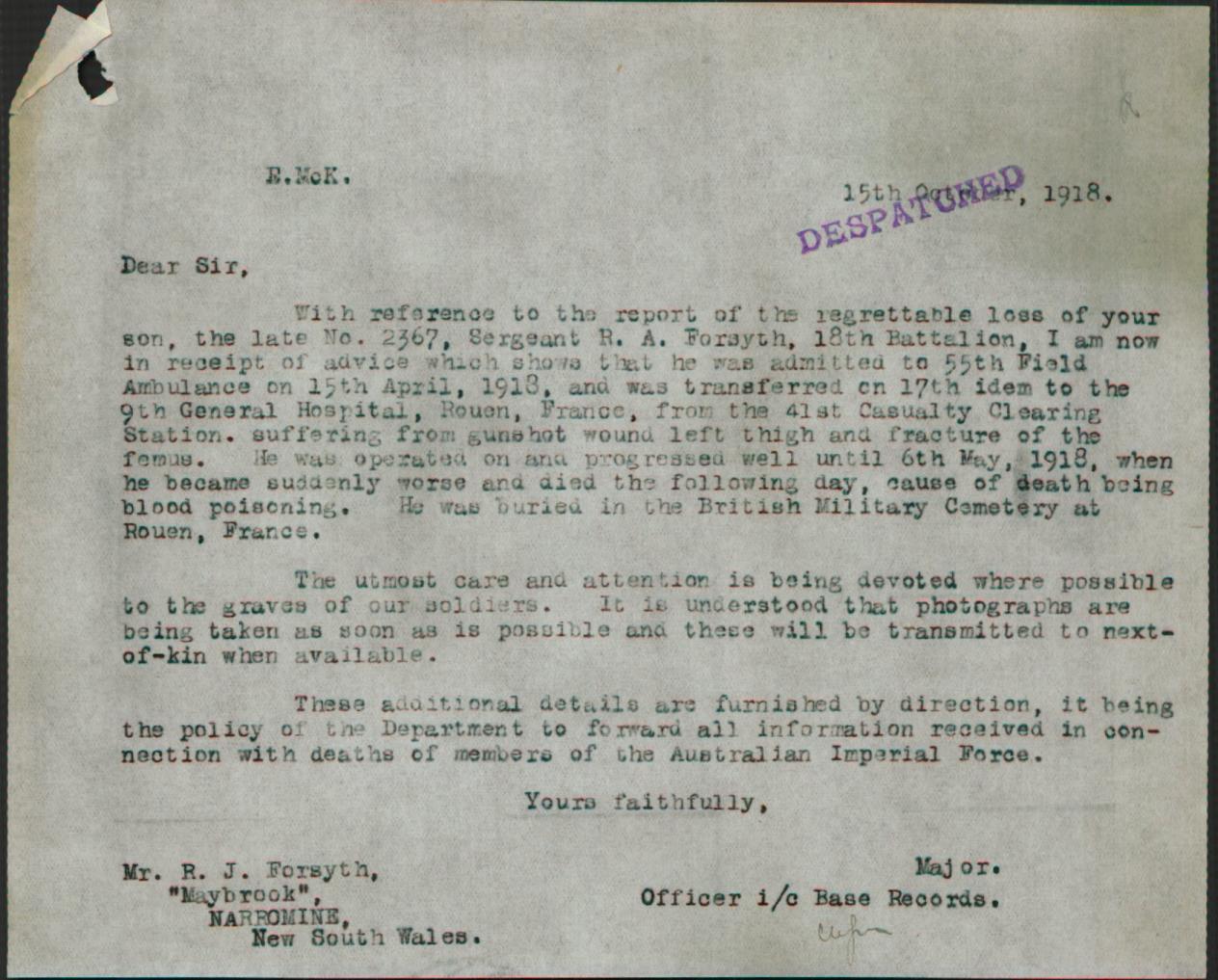
Essie A Forsyth, b. 1895, NSW, to Robert James and Agnes Christina d. 20 Apr 1981, Surfers Paradise, NSW, Australia. Formerly of Cammeray
The family lived in The Towers until Robert James' death in 1920, when most of the thirteen hectares of land adjoining The Towers was purchased by the War Service Homes Commission. When the War Service Homes Commission subdivided the area, four streets (Robert, Archibald, Roy, Forsyth) were named after Robert James' son, Robert Archibald (known as Roy) Forsyth.
The Commission built houses on this land for soldiers returning from World War I and their families. Councillor Kayee Griffin unveiled a series of nameplates commemorating these street names on 11th November, 2000. Robert James Forsyth was an Alderman on Canterbury City Council from 1899-1902.
FORSYTH ROBERT J 818/1920 Parents ARCHIBALD SARAH Registered at: CANTERBURY - NSW BDM's
FORSYTH - The Funeral of the late Mr ROBERT JAMES FORSYTH will leave his late residence, The Towers, Belmore, THIS THURSDAY, at 1.30 p m , by motor service, for Randwick General Cemetery, Long Bay road. Coogee Interment 3 o'clock. WOOD COFFILL and COMPANY, LTD. Family Notices (1920, April 1). The Sydney Morning Herald (NSW : 1842 - 1954), p. 7. Retrieved from http://nla.gov.au/nla.news-article15875009
Mr. R. J. Forsythe, of 'Maybrook,' Narromine, died last week in Sydney. It is understood that Mr. Forsythe underwent an operation for a growth in the neck and subsequently collapsed. He was well known and respected through out the district. His only son, Roy, was killed at the war, and the late Mr. Forsythe was arranging the disposal of his Narromine property which he had purchased for him. District News (1920, April 8). Mudgee Guardian and North-Western Representative (NSW : 1890 - 1954), p. 29. Retrieved from http://nla.gov.au/nla.news-article157043384
RETURN THANKS.
Mrs R. J. and Miss FORSYTH, of "The Towers." Belmore and Narromine, return sincere THANKS to relatives and friends for telegrams, letters, floral tributes, and messages of sympathy received in their late sad bereavement.
Mrs EVANS and FAMILY, of Manly, return sincere THANKS to relatives and friends for kind expressions of sympathy received on the death of her brother, the late Robert J. Forsyth.
Mr and Mrs. T. B. WYATT. and FAMILY, of Manly, return sincere THANKS to relatives and friends for the kind expressions of sympathy received on the death of their uncle, the late Robert J. Forsyth. Family Notices (1920, April 7). The Daily Telegraph (Sydney, NSW : 1883 - 1930), p. 8. Retrieved from http://nla.gov.au/nla.news-article239632538
Agnes passed away in 1957 at Double Bay, her parents are listed in NSW BDM's as JOHAN LUDIWIC and BELINDA.
Reginald James Thomas Forsyth, born at 39 Hayberry Street, Crow’s Nest, Sydney, in early 1893 to parents John Lile Lewis Forsyth and Elizabeth Christina Forsyth (nee Crowley - daughter of Michael Crowley, died 1884 in Gundagai and Sarah, nee Breadmore). A letter penned by Michael Crowley, under Extras, pertains to Land Grants. John Lile Lewis Forsyth was a son of James Forsyth (1818-1907) and Margaret Todd, of the Forsyth family that did so much for Willoughby. He too was lost in this conflict.
ROLL OF HONOR.
FORSYTH.— In loving, remembrance of Lieut . R. J. T. Forsyth (Reg.), 68th A.F.C., late 1st A.L.H., died of Injuries received In aeroplane accident, February 16th, 1918; dearly loved eldest son and brother of Mr. and Mrs. J. Forsyth, 39 Hayberry Street, Crows Nest.
FORSYTH.— In loving memory of our dearly loved nephew, Second-Lieut. Reg. Forsyth,; who died February 16th, 1918, result of aeroplane accident. Regretted by his loving aunt and uncle, O. and Amy Knight- (One of the best). Family Notices (1920, February 16). The Daily Telegraph (Sydney, NSW : 1883 - 1930), p. 4. Retrieved from http://nla.gov.au/nla.news-article239664906
FORSYTH.-In loving remembrance of Lieut R. J. T. Forsyth (Reg), 68th A.F.C. late 1st A.L.H.. died of injuries received in aeroplane accident, February 16 1918, dearly loved eldest son and brother of Mr. and Mrs. J. Forsyth, Mm. J. Forsyth and family. 30 Hayberry-street, Crow's Nest. A young life nobly ended. Family Notices (1920, February 16). The Sydney Morning Herald (NSW : 1842 - 1954), p. 6. Retrieved from http://nla.gov.au/nla.news-article15879688
FORSYTH.— March 30th, 1920, at his residence, 'The Towers," Belmore, Robert James Forsyth (also of Narromine), eldest son of the late Archibald Forsyth, in his 60th year. Family Notices (1920, April 1). The Daily Telegraph (Sydney, NSW : 1883 - 1930), p. 4. Retrieved from http://nla.gov.au/nla.news-article239625466
Although not directly related to Robert James Forsyth, son of Archibald, R J T's uncle, Robert Todd Forsyth (1877-1939), Mayor of Willoughby on four occasions, and seventh child of Thomas Todd Forsyth (1840-1921 - father of John L L as well) is worth noting here due to his own interest in developing paddocks into home lots. They are all descendants of the Scottish Forsyth clan. Just as the Crowley clan, of Ireland, (see Avalon Roads), are all from Cork.
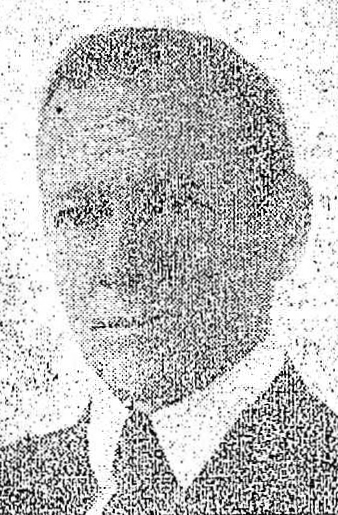 Mr. R. T. Forsyth, who is figuring prominently in subdivisional work this season, is a born suburb builder, and to his enterprise has been largely due the rapid growth of the Willoughby and Chatswood districts. Starting as a real estate agent at Willoughby in 1898 before he was 21 years of age, Mr. Forsyth for some time devoted his energies chiefly to the Willoughby district, but of recent years he has directed his activities to a number of other places, particularly Northbridge, which he was responsible for opening up in 1913. He has also played an important part in the progress of Longueville, where he developed about 20 subdivisions. Several of the leading, banks have at different times entrusted properties to his hands, representing in value many hundreds of thousands of pounds.
Mr. R. T. Forsyth, who is figuring prominently in subdivisional work this season, is a born suburb builder, and to his enterprise has been largely due the rapid growth of the Willoughby and Chatswood districts. Starting as a real estate agent at Willoughby in 1898 before he was 21 years of age, Mr. Forsyth for some time devoted his energies chiefly to the Willoughby district, but of recent years he has directed his activities to a number of other places, particularly Northbridge, which he was responsible for opening up in 1913. He has also played an important part in the progress of Longueville, where he developed about 20 subdivisions. Several of the leading, banks have at different times entrusted properties to his hands, representing in value many hundreds of thousands of pounds.
Mr. Forsyth, who began his connection with the Willoughby Municipal Council as auditor at the age of 21, has since been mayor of that suburb on nine different occasions. He is a well-known valuator, and has acted in .that capacity for the Lane Cove Council. While he was Mayor of Willoughby, that district gained the reputation for its responsiveness to patriotic appeals, and on one occasion when the quota of the district was £60,000, Willoughby returned the handsome total of £117,000. Mr. Forsyth is now interesting himself in the community principle as applied to suburban development, and the Castlecrag Estate, which was recently opened up by him, now has his special attention in the direction indicated.
Mr. W. Robjohns will offer the Rothwell Estate, at Longueville, for auction on Saturday next. There are 49 building sites on the estate, which is in a picturesque locality, and is only a few minutes from the shopping centre and tram terminus.
Cronulla was, Palm Beach is, and Avalon Beach will be. This is the catch slogan which has been adopted by the vendor of the Palmgrove Estate at Avalon, which is to be sold by Messrs. H. W. Horning and Co., on Boxing Day. Judging by the beautiful panoramic views which appear in an attractive booklet, and which also occupy a conspicuous position in Messrs. Horning and Co.'s windows, Martin-place, the scenery surrounding the estate must be exceptionally beautiful. Avalon is the new seaside resort between Newport and Palm Beach.
The Palmgrove Estate is on the main Barrenjoey-road, and is right at the beach.
The owner has evidently had the public good in mind, as the estate has been well planted with Ornamental shade trees, while a section of it known as the Palm Grove, has been presented as a park. This is a remarkable beauty spot, with a wealth of graceful palms, maidenhair, burrawang, and other flora. The estate is in every respect a most attractive proposition to those looking for week-end and holiday sites. REAL ESTATE NEWS (1921, December 11). Sunday Times (Sydney, NSW : 1895 - 1930), p. 10. Retrieved from http://nla.gov.au/nla.news-article123241058
An earlier form of Mona Vale SLSC, when it was Mona Vale Alumni during 1930-31, used this premises as their weekend base. As can be seen below, the place was still used as a resort for visitors:
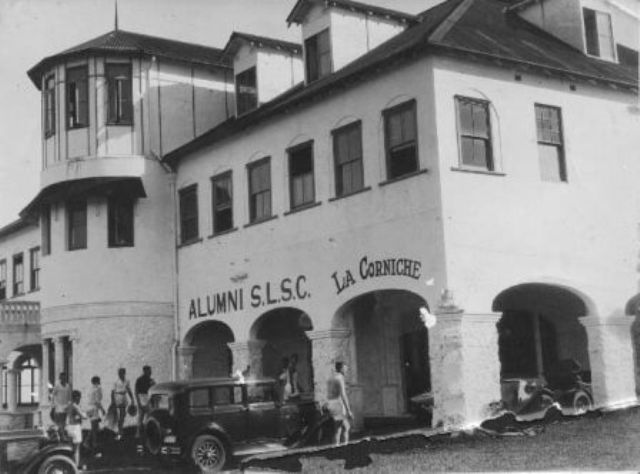
AT LA CORNICHE under entirely new management-Tariff from £2/2/ per week 10/6 per day Phone Mona Vale 50. Advertising (1932, February 27). The Sydney Morning Herald (NSW : 1842 - 1954), p. 5. Retrieved from http://nla.gov.au/nla.news-article16843745
BY ORDER OF THE MORTGAGEES. MONA VALE.ONLY A FEW MINUTES FROM THE BEACH AND GOLF LINKS. That well-known SEASIDE ESTABLISHMENT Known as LA CORNICHE,now conducted as a Tourist Boarding-house, and which is also eminently suitable for a REST HOME, SCHOLASTIC, or ECCLESIASTICAL INSTITUTION.
The building is constructed of brick, cemented, with Iron roof, and comprises ground and two upper floors. On the ground floor are wide verandahs, hall, office, double lounge-rooms, large dining-room, smokeroom. kitchens, scullery, pantries, store and engine room. On the two upper floors: 20 bedrooms and 2 bathrooms. Detached is ballroom (18 x 60), with special floor. In addition to the above are FOUR COMMODIOUS COTTAGES, built of stone and of brick, with tiled and iron roofs, each having verandahs,and about 7 large rooms, kitchen, and offices. Two motor garages. Tennis court. The buildings are connected by electric light (own plant) and septic sewerage.
THE SITE is a most PROMINENT ONE having a frontage of approximately 335ft to the MAIN NEWPORT-ROAD, together with frontages of about 795ft to Darley-street, 350ft to Noble-street, and 440ft to Stanley-street (an unformed street), and is suitable for subdivision. (Plan on view at the Auctioneers). TORRENS TITLE. EASY TERMS CAN BE ARRANGED. RICHARDSON and WRENCH, LTD., will submit above to PUBLIC AUCTION, in the Rooms,92 PITT-STREET, on FRIDAY, 19th FEBRUARY,at ll a.m. Advertising. (1932, February 6). The Sydney Morning Herald (NSW : 1842 - 1954), p. 20. Retrieved from http://nla.gov.au/nla.news-article28035038
During World War II La Corniche was used as a Red Cross centre for wounded soldiers. In World War II "La Corniche" was commandeered by the Air Force during and used as training ground for recruits. Some sources state it was also used by the Army as an Infantry Training School for NCO's. La Corniche - [Occupation by Australian Military Forces of premises known as 'La Corniche' in Mona Vale, the property of Mr GJ McPhee. Includes claim for compensation] Australian Archives Military Records. Property files for sites in NSW hired or acquired for the Department of Defence during World War II
Of then:
I was ordained in 1941, the beginning of `41, and appointed as a curate in the parish of St Faith's, Narrabeen. I was then just two days beyond my twenty-third birthday. The war had commenced, and, during my first appointment at Narrabeen, army camps were being formed in the area, because the threat of invasion was feared. I can recall fences being erected along the sides of the road, so that places like Palm Beach or Bayview could be shut off if need be, and then, when the threat of the Japanese came, the more intense development of army troops in that area. And Canon Tugwell then asked me to become a part-time chaplain to those troops in that area.
The parish of Narrabeen in those days went from Collaroy down to Palm Beach. There were main residential settlements at Collaroy, Narrabeen, but when you went out beyond that to Mona Vale you had mainly twenty-five acre small farms, many glasshouse tomato producers. Beyond Mona Vale, Newport was ... just one hotel in Newport, and mainly accommodation for people coming down to holiday use. Beyond Newport, at Bilgola and at Avalon, and then at Palm Beach, there were just mainly holiday homes, very few permanent residents.
My appointment was to help commence a ministry in that northern part. So I boarded with an old Boer war veteran and his wife, a Mr and Mrs Wilson, who lived in Fermoy Avenue, Bayview. And from there would conduct services in the store at Avalon, where there was little tea-rooms behind the store, and in an estate agent's office at Palm Beach. Subsequently a family by the name of Byle lent us their home for the service at Palm Beach. And my other ministry there was to the troops, which were then being trained by the army, and they had an officers' training unit in a big home at Mona Vale, and my responsibility was to conduct services, and then to have discussions or what they called padre's hours with the intake of recruits.
Canon Charles Henry Sherlock, Chaplain RAAF, interviewed by Gail Winkworth for the Keith Murdoch Sound Archives of Australia in the War of 1939-45
From: http://www.awm.gov.au/transcripts/kmsa/s00572_tran.htm
Another use was made of these huge structure and its many rooms:
Director of Physical Education, 7/1/43, advising that the National Fitness Council is now using "La Corniche", Mona Vale, as a training centre for boys and girls, of whom some hundreds will be accommodated from time to time throughout the year, and Mona Vale extensive use will be made by these children of the swimming Rockbaths pool at the beach, requesting Council to provide a rope across the pool which would be of great use to children who are non- swimmers, and serve as a safeguard in the event of waves sweeping into the pool. The Shire Engineer reported that a wire had been substituted, and that this should be sufficient. Resolved, - That a reply in the terms of the Engineer's report be sent. - 19/01/1943 Warringah Council Minutes
There were a number of submarine sightings during World War II in Pittwater and barbed wire along every beach except Newport. The Green Hornets of the 7th Battalion Volunteer Defence Corps camped in Warriewood Valley during this period and Mona Vale, south of La Corniche, was a camp for trainee machine gunners. Ruskin Rowe at Avalon hosted the Sundown RAAF Camp, who were trained by Nancy Bird Walton.
Part of the building was utilised after the war as a clubhouse by what became the Mona Vale SLSC.
The building was demolished to build home units after 1953. Bert King OAM, of Narrabeen and Newport, late Bayview, as Bert King Constructions, built the first ever units in Mona Vale in Darley Street East on the crest of the hill where the old La Corniche used to be, explaining during his Profile interview; "(I) pulled it down and everyone complained about it being pulled down but the building was a heap of rubbish (by then)".
Further Reading:
Mona Vale Training Grounds - From Lancers on Horses to Lasses on Transport Courses
Mona Vale Library History of Brock's Folly: http://www.pittwater.nsw.gov.au/library/local_history/Pittwaters_past/brocks_folly
WAAAF: www.defence.gov.au/news/raafnews/editions/4404/story10.htm &: http://home.st.net.au/~dunn/waaaf/waaaf.htm




FROM: Album 57: Photographs of the Allen family, 2 May 1911 - 7 October 1911 Digital Order No. a3289055; 'Enlargement of view taken looking over the Polo Grounds. The road up the hill leads to Barrenjoey' and Digital Order No. a3289054; 'Enlargement of view taken from Brock's house, 3rd of September, 1911'. Both Courtesy State Library of NSW.

Photo Attributions: TOP: W.A.A.A.F. recruits, Mona Vale, 1944 . FILE: 41\WAR41923 SUBJECTS: Australia. Royal Australian Air Force. Women's Auxiliary Australian Air Force; La Corniche (House : Mona Vale, N.S.W.) ; World War, 1939-1945; New South Wales; Mona Vale; Mona Vale (N.S.W.) DESCRIPT: "La Corniche" commandeered by Air Force during World War II and used as training ground for recruits CREATED: [1944]
Below Top: Members of Australian Women's Flying Corps, Mona Vale, 1944
FILE: 41\WAR41916 SUBJECTS: Williams, Phyllis; Australia. Royal Australian Air Force. Women's Auxiliary Australian Air Force; World War, 1939-1945 ; New South Wales; Mona Vale; Mona Vale (N.S.W.) DESCRIPT: Phyllis Williams, second from left, back row Photograph taken at "La Corniche" CREATED: [1944]


Cadets from Parramatta Company at 'La Corniche' training camp, Mona Vale in 1943.

Above: Bedroom 8 at La Corniche. Right: the Ballroom. Images courtesy Mitchell Library, NSW, ca. 1900-1927 Sydney & Ashfield : Broadhurst Post Card Publishers. Album 'Scenes views and interiors of "La Corniche", Mona Vale, N.S.W. circa 1912- 1927 Nos: a106010 a106011 & a106008 . Below Bedroom 7. Below: the villas beside the main building and Dining room, No: a106006.
Some of these images appear in the brochure entitled The Brock Estate produced by D.J.McIntyre & Coy for the auction sale of the property in October 1907. Others show La Corniche as rebuilt after 1912 and prior to 1920






Above: View from Brock's House, Allen Family Album, 1911. Image No: 3289054, courtesy Mitchell Library NSW. Below: The Ballroom.



Also clubhouse for Mona Vale SLSC when was still Alumin SLSC. 1930s.





George Sydney Brock
George Sydney Brock was born in the spring of 1855 in Sydney to Robert and Mary Anne Brock (nee Kettle), their eldest son. His brother John H would be born in 1857, and die in 1858.
On the 18th September, at Balmain, the wife of Mr. Robert Brock, of a SON. Family Notices (1855, September 22). The Sydney Morning Herald (NSW : 1842 - 1954), p. 5. Retrieved from http://nla.gov.au/nla.news-article12978367
BROCK—January 26th, at Goulburn-street, of hooping-cough, John Hurbert, aged 12 weeks, second son of Robert and Mary Anne Brock. Family Notices (1858, January 28). The Sydney Morning Herald (NSW : 1842 - 1954), p. 1. Retrieved from http://nla.gov.au/nla.news-article13005585
In their Marriage Notice Robert Brock is stated to be from Manchester - his parents were William and Susanna. Mary Anne was born in Sydney to John Icke Kettle and Ann (nee May). Both John Kettle and Ann May were the offspring of transported convicts - John following his family out to join his siblings and mother, while Ann was born here.
George's wife Charlotte Ellen Davis was born in 1858, the birth registered in Glebe, the daughter of Joseph and Ellen. She and her mother were known as artists. Her sister Amy was born in 1860 at Newtown. Three brothers (one who died young) and two sisters preceded them. Her father worked as a grocer and butcher, suffering a few bankruptcies along the way. Her parents marriage:
By special license, on the 28th instant, by the Rev. Dr. Fullerton, Mr. Joseph Davis, of Newtown, to Ellen, youngest daughter of the late Mr. Edward Turner, of Parramatta-street. Family Notices (1850, October 29). The Sydney Morning Herald (NSW : 1842 - 1954), p. 2. Retrieved from http://nla.gov.au/nla.news-article12922125
She and George Sydney Brock were married 1882, the marriage registered in Canterbury. George and Charlotte had four children, two boys and two girls - NSW BDM's Records:
BIRTHS.
BROCK.-November 20, at Victoria Lodge, Newtown, the wife of George S. Brook, of a son. Family Notices (1882, November 25). Australian Town and Country Journal (Sydney, NSW : 1870 - 1907), p. 40. Retrieved from http://nla.gov.au/nla.news-article70993261
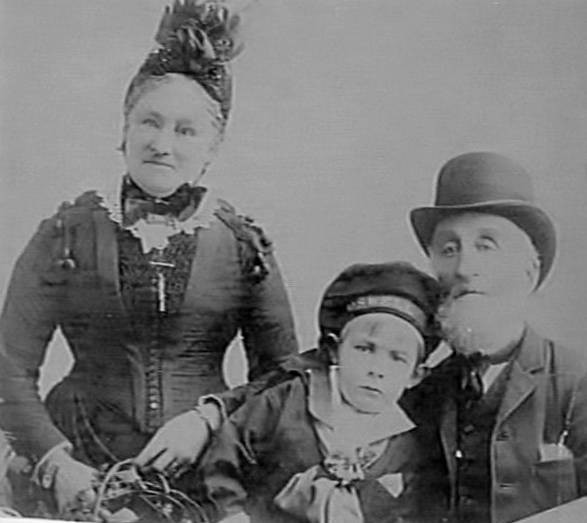
Robert and Mary Brock with grandson Oswell, circa 1887 - photo courtesy Dodds family
Births.
BROCK.-July 29th, at Brockleigh, Newtown, Mrs. George S. Brock, of twins, son and daughter. Family Notices (1891, July 31). The Sydney Morning Herald (NSW : 1842 - 1954), p. 1. Retrieved from http://nla.gov.au/nla.news-article13833099
Viva's twin brother died soon after he was born, the second time a Brock baby had been lost in successive generations:
BROCK.— December 18, at his parents' residence, Brockleigh, Newtown, Victor, aged 4 months 19 days. Family Notices (1891, December 19). The Australian Star (Sydney, NSW : 1887 - 1909), p. 1. Retrieved from http://nla.gov.au/nla.news-article227246352
Brockleigh, Landmark Italianate Boom Style Residence
1 Warren Ball Avenue, Newtown
In a dress circle position fronting Hollis Park, this magnificent two-storey family residence stands on a large 480.6sqm block with landscaped gardens, a spacious alfresco barbecue area and swimming pool. With impressive proportions and superb Italianate Boom Style features, it is one of eight grand manor homes built during the mid-1880s in the blue ribbon street originally known as L'Avenue.
Set at the corner of Warren Ball Avenue and Georgina Street, the immaculately maintained and beautifully presented house has a handsome facade with a wide wraparound verandah and iron-lace balconies.
Named Brockleigh, it originally was the home of George S. Brock who developed the street's other majestic villas as well as a splendid row of terraces on Georgina Street.
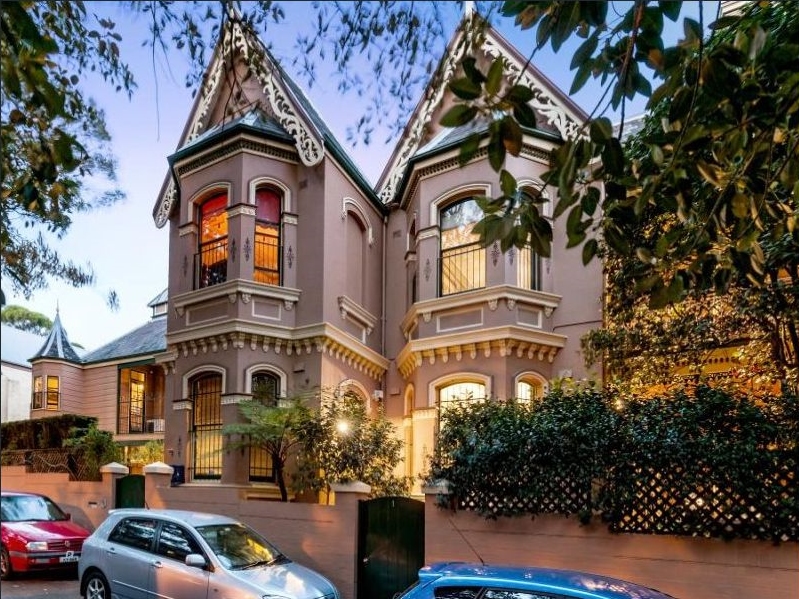
Spanning two spacious levels plus a basement cellar, the imposing slate-roofed house commands sweeping views towards Botany Bay from its upper level verandah. Quiet and private, it has generously proportioned rooms with bay windows, soaring ceilings, ornate cornices, polished timber floors and beautiful original features including marble fireplaces and select timber species joinery.
At entry level an original tessellated tiled hallway, interconnecting formal sitting and dining rooms, a modern open-plan gas and timber kitchen, spacious family living and dining areas, a breakfast conservatory, large office (with separate entry), a bathroom (with easy access to the pool area), concealed laundry and abundant storage. Glass-paned french doors, in the family living area, open to the outdoor entertainment areas and pool.Two staircases lead to the upper level which has a huge main bedroom (with a book-matched slab marble ensuite, verandah and separate sitting room or nursery), three more king-size bedrooms (with built-in wardrobes) and a large main bathroom with a bath and separate shower. Mod cons include gas heating bayonets, air-conditioning, Foxtel wiring and garden irrigation. Featuring three street frontages and a separate gated entry from Georgina Street, this remarkable property is a short walk from Royal Prince Alfred Hospital, University of Sydney, Eveleigh Farmers' Markets, city transport (buses and trains), and King Street shops and restaurants.
Last sold for $3,625,000 on 13/03/2014. Information Retrieved from www.realestate.com.au/sold/property-house-newtown-116119335
There is still a Brock's Lane in Newtown.
Oswell was an artist - many of the sculptures seen in photos of The Oaks stemmed from the sculpture machine spoken of above in the Mona Vale beach - George Brock section:
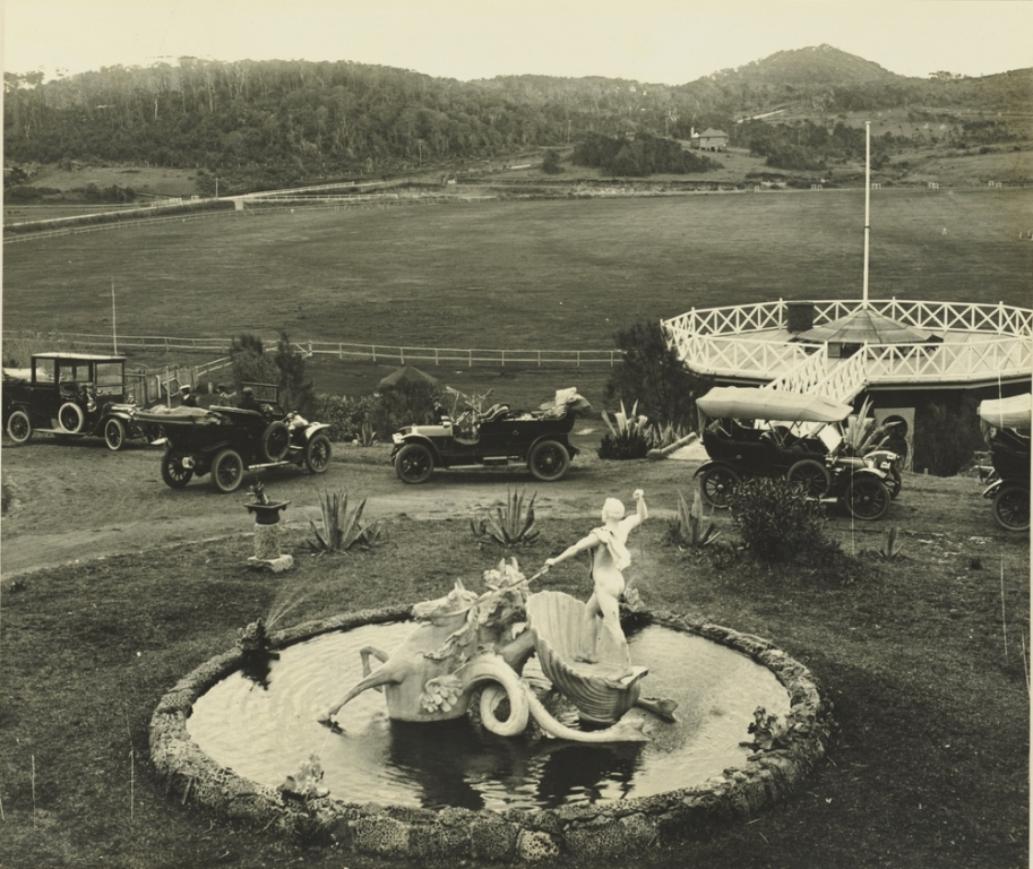
Mr. Brock has made a great impression upon the district.
He is of average height, compactly built, with strong features. His face reminds one of the old Romans as they have been pictured for us. He is clean shaven, quick in speech, and direct-in his utterance, very prompt and somewhat masterful in manner. A man, that can be plainly seen,— a man of strong individuality. He stands alone, and requires no support but his own keen brain and active body. He is a man to take the lead and keep it, a man who by his greater pushfulness makes enemies as well as friends. .. “THE OAKS,” (1904, September 3). The Mosman Mail (NSW : 1898 - 1906), p. 4. Retrieved from http://nla.gov.au/nla.news-article247008613
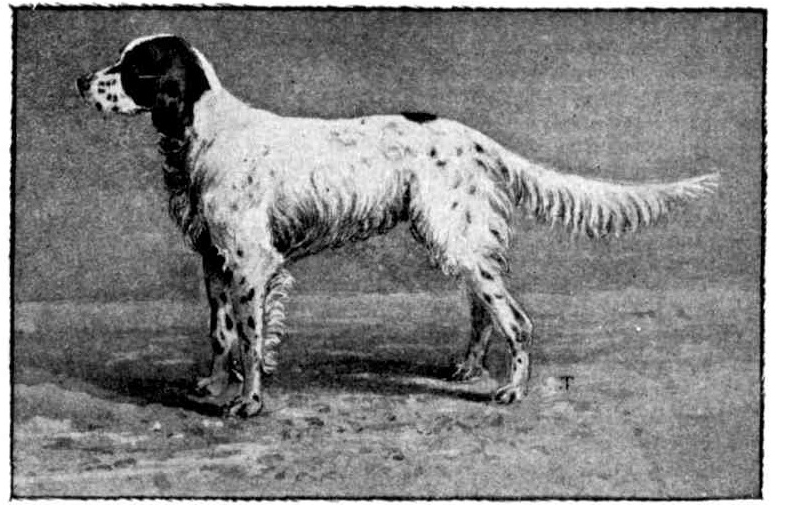

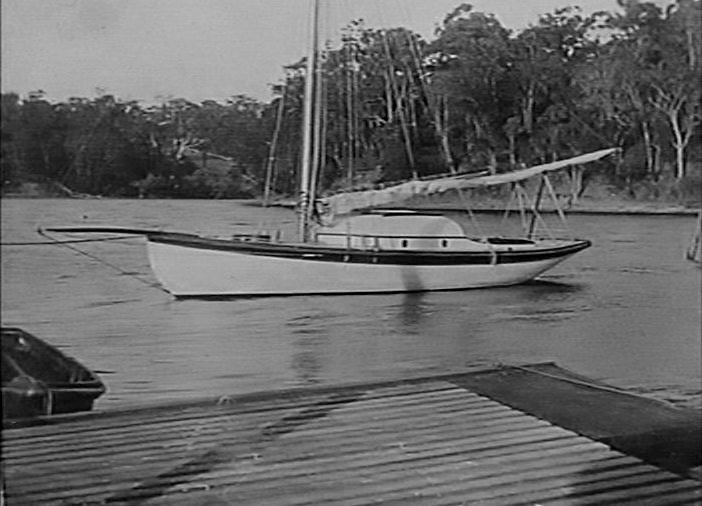
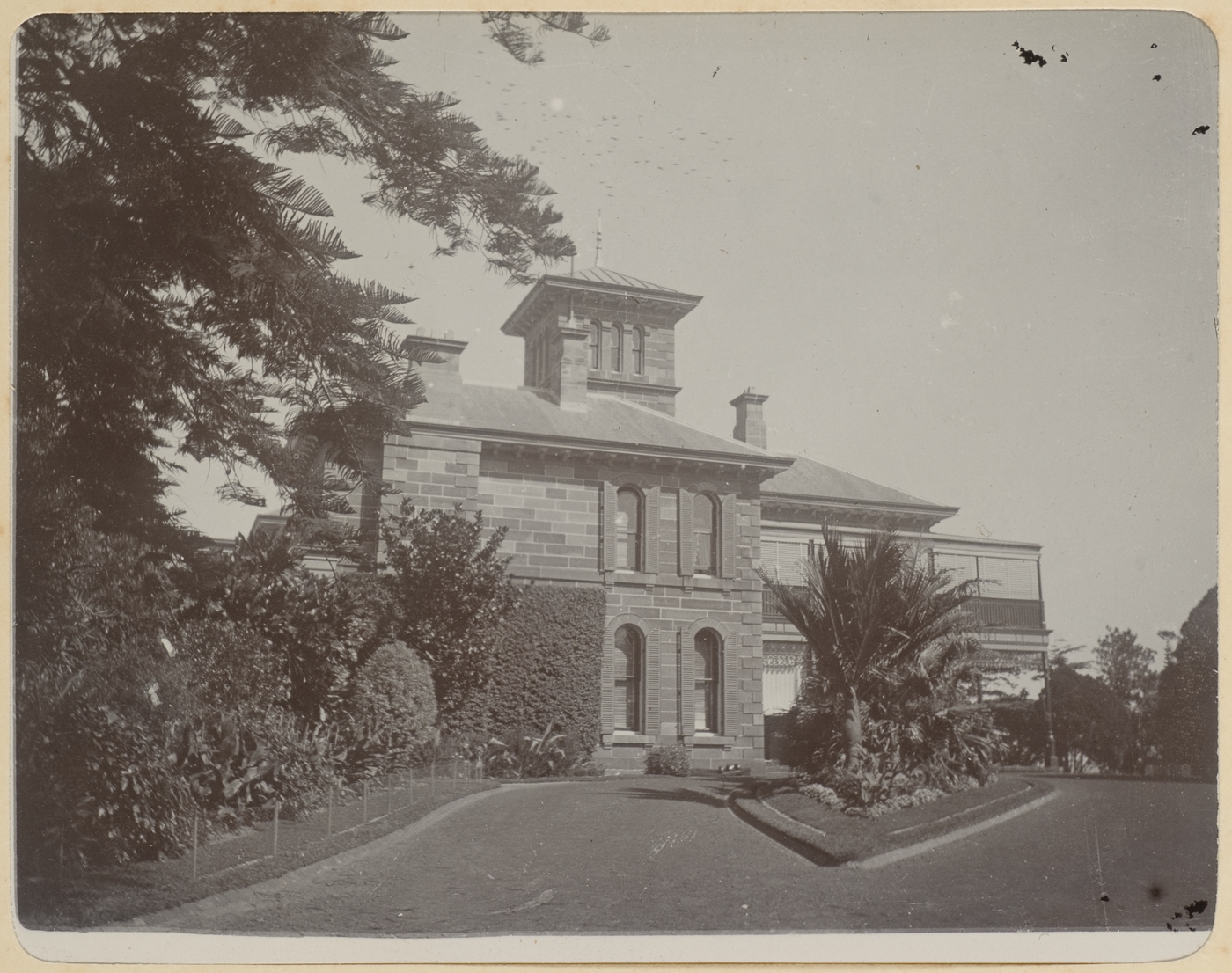
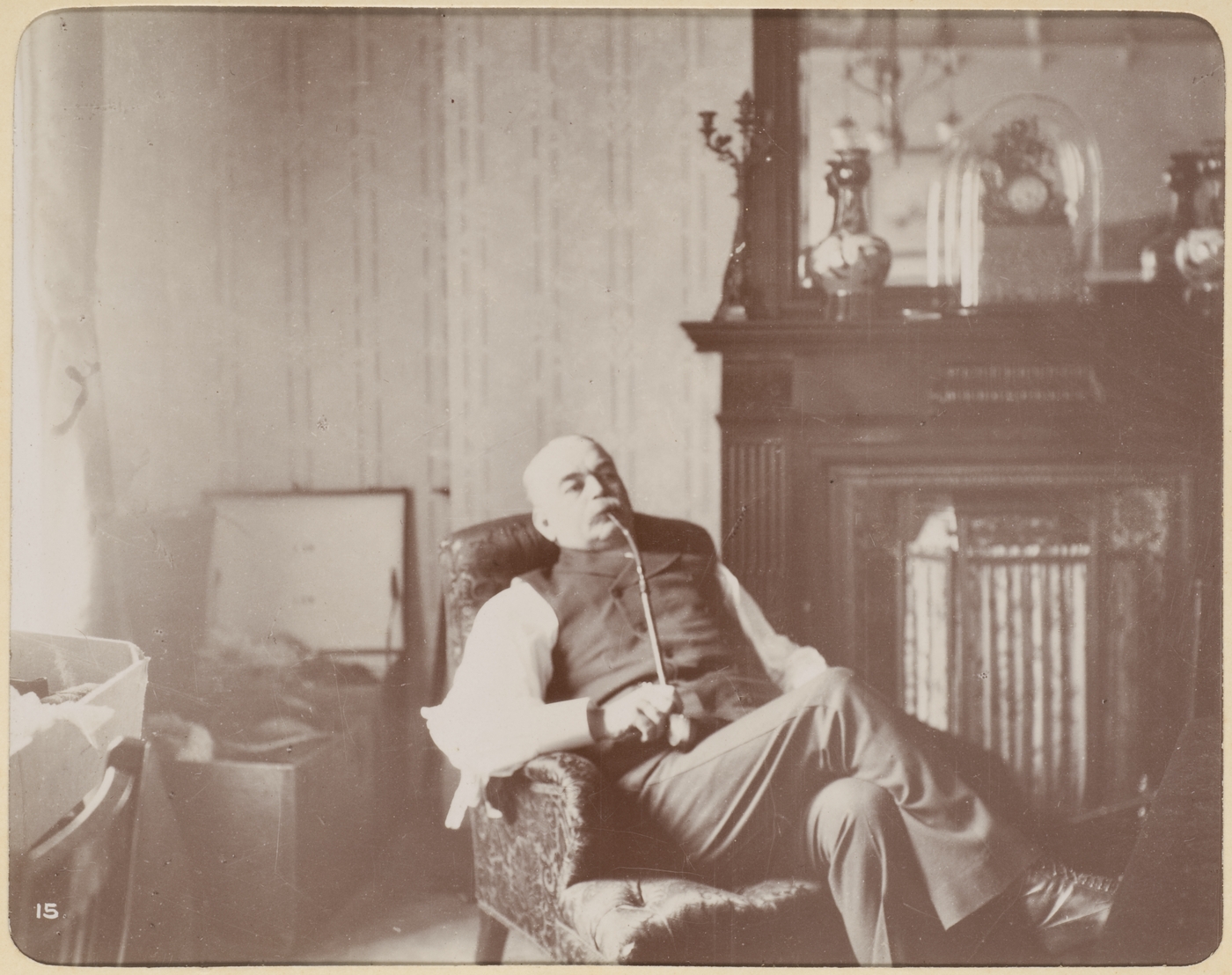
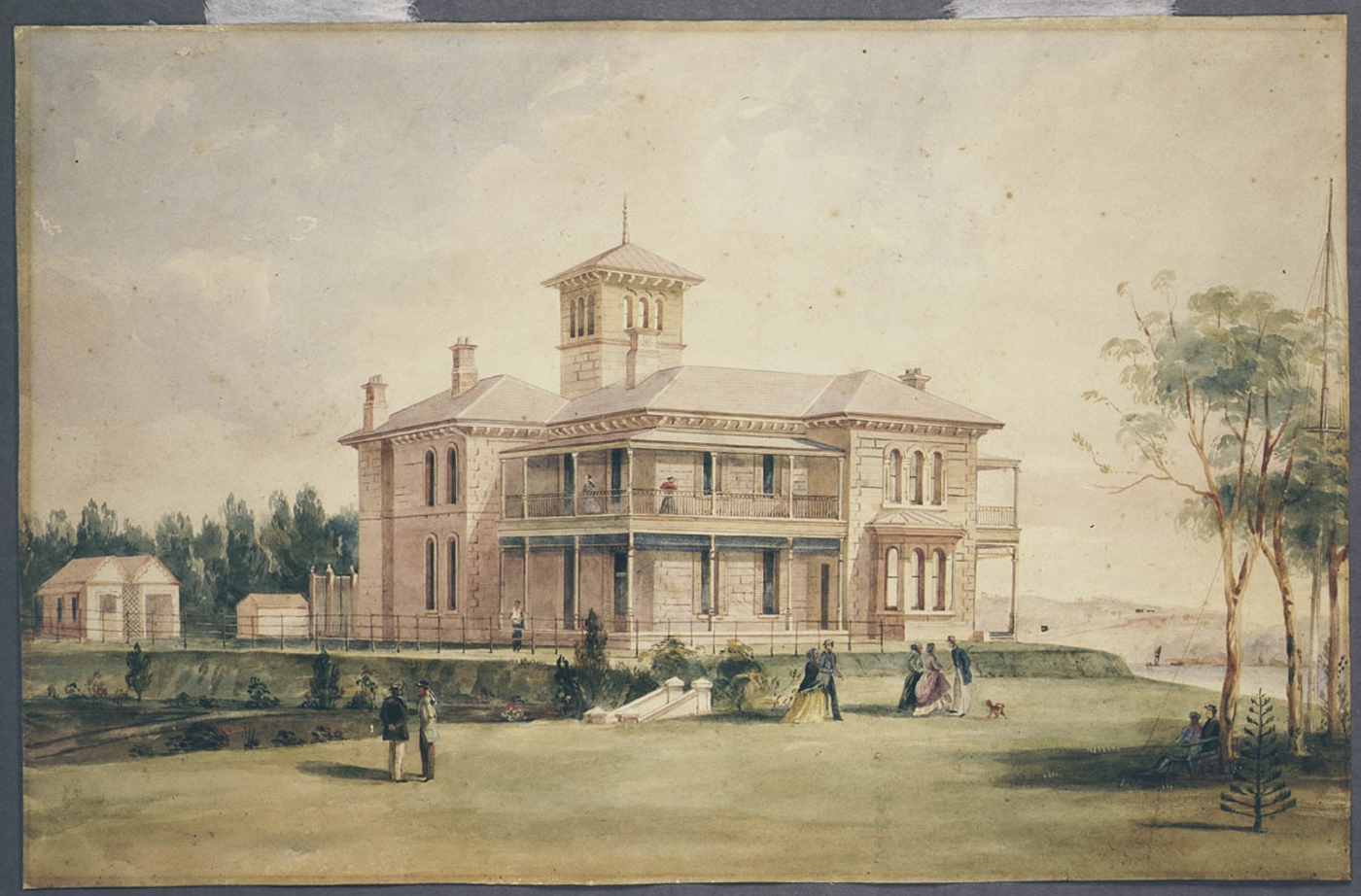
Less than a year later his mother passed away and was interred at Manly too:
Deaths. BROCK.— August 18, at Mona Vale, Pittwater, Mary Anne, relict of the late Robert Brock, aged 69 years. Family Notices (1900, August 20). The Australian Star (Sydney, NSW : 1887 - 1909), p. 1. Retrieved from http://nla.gov.au/nla.news-article230638859
BROCK. — August 18, at her residence, The Oaks, Mona Vale, Mary Anne Brock. Family Notices (1900, September 1). The Sydney Mail and New South Wales Advertiser (NSW : 1871 - 1912), p. 543. Retrieved from http://nla.gov.au/nla.news-article163693941
BROCK.—The Friends of the late Mrs. BROCK Sen., are kindly invited to attend her Funeral to move from her late residence Mona Vale Pittwater THIS AFTERNOON Monday at half past 1 and to arrive at the Manly Cemetery at 4 o'clock. A special boat will be at the Manly Wharf at 10 45 to convey Friends to Pitt Water. T.WAUGH and COMPANY, Undertakers and Embalmers,.Corso. Manly. Telephone, 42. Family Notices (1900, August 20). The Sydney Morning Herald (NSW : 1842 - 1954), p. 10. Retrieved from http://nla.gov.au/nla.news-article14331551
BROCK.—August 18, 1900, at her residence, The Oaks, Mona Vale, Mary Anne, the dearly beloved and only sister of Mrs. Georgina Thruchly, of Kettle-avenue, Newtown. Family Notices (1900, August 21). The Sydney Morning Herald (NSW : 1842 - 1954), p. 1. Retrieved from http://nla.gov.au/nla.news-article14331752
While dealing with the loss of his parents within so short a time George Brock was also working at getting that tram out to Pittwater to secure the success of his venture:
The Oaks Model Village - George Brock's Mona Vale Estate
George Brock's idea for the Oaks at Mona vale, as shown in his naming it a 'model village' was to provide something extraordinary, along the lines of Mark Foy's Medlow Baths in the Blue Mountains, only beside the sea. The main house itself had three levels and over 38 rooms, a dining hall, 28 bedrooms, a ballroom out in the grounds, as well as polo fields, a golf course.
His passion for polo even had some scribes, in writing it up, stating this was The Oaks Polo Grounds. He acquired sections 2 and 3 of the Mona Vale estate, from the verge of where the present day golf course is all the way up to and including the Bungan-Mona Vale headland verge.
The land on which The Oaks stood is Section 2 of the Mona Vale estate, offered in the second subdivision and may have been picked up relatively cheaply:
TO SPORTING, BOATING, AND CAMPING PARTIES.
CHOICE WATER FRONTAGES.
THURSDAY, 10th DECEMBER, 1889.
CLEARANCE SALE
of the whole of the
UNSOLD PORTIONS of that BEAUTIFUL MARINE ESTATE,
MONA VALE, PITTWATER.
AT THE ROOMS, 130, PITT-STREET.
MILLS, PILE, and WILSON have been instructed by the proprietors to sell by public auction, at their Rooms. 130, Pitt-street, on THURSDAY, the 19th December, at half-past 11 o'clock,
The whole of the unsold portions of the
FARFAMED MONA VALE ESTATE,
recently subdivided into blocks of 2 to 30 acres each
THIS BEAUTIFUL ESTATE bus a large frontage to the eastern shores of Pittwater, extending to the waters of the Pacific Ocean, and is Intersected by the main road to Barrenjoey.
The SOIL is of the richest description, suitable for
ORANGERIES and ORCHARDS,
and the hills surrounding the various bays are adapted for
MARINE VILLA RESIDENCES.
The coach to Manly runs daily, and makes this property easily accessible from the city.
The terms of sale will be very liberal.
For further particulars and Lithos. apply to
MILLS, PILE and WILSON, Auctioneers, 130. Pitt-street. Advertising (1889, December 11). The Sydney Morning Herald (NSW : 1842 - 1954), p. 11. Retrieved from http://nla.gov.au/nla.news-article13752858
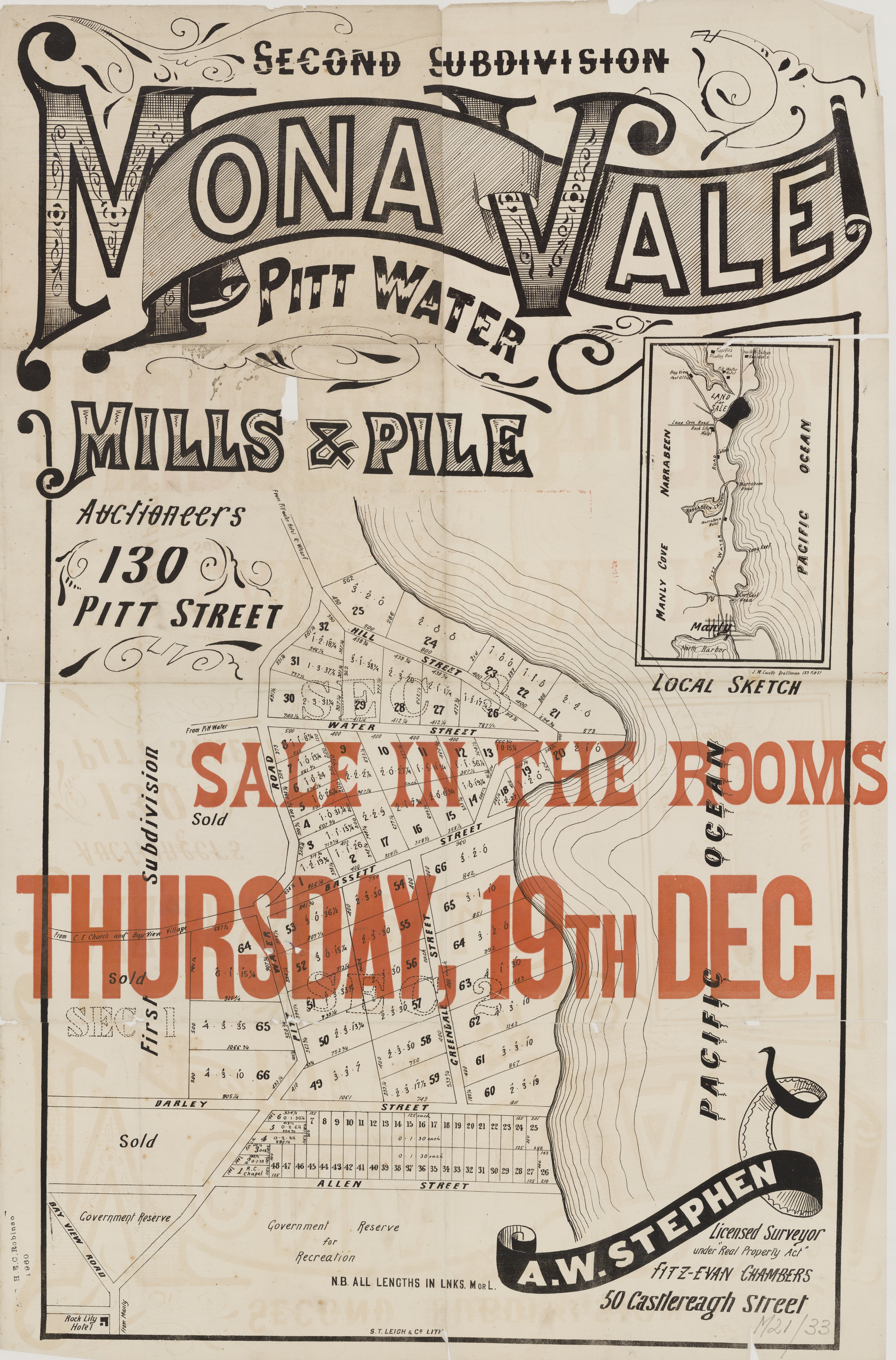
Second Subdivision - Mona Vale - Pittwater - Hill St, Waterview - Section 2 and Section 3, Thursday December 19th, 1889 Item No.: c046820031, from Mona Vale Subdivisions folder, courtesy State Library of NSW.
MONA VALE, PITTWATER SALE December 19, in the Rooms, 130 Pitt-street.
FREE COACH TICKETS from Manly, for Intending Buyers to inspect this Property, can be obtained at the Rooms.
MILLS, PILE, and WILSON, Auctioneers. Advertising (1889, December 13). The Australian Star (Sydney, NSW : 1887 - 1909), p. 8 (FOURTH EDITION). Retrieved from http://nla.gov.au/nla.news-article227582280
By 1897:
Department of Lands,
Sydney, 13th November, 1897.
APPLICATIONS FOR LEASES FOE SPECIAL PURPOSES.
IT is hereby notified, for general information, that the undermentioned applications have been received for Special Leases, under the provisions of the 89th and 90th sections of the Crown Lands Act of 1884, of the lands and for the purposes hereunder staled, and that it is the intention to grant leases, should no sufficient objection be found to exist, after inquiry by the Land Board and consideration by the Minister.
Any objections will receive due consideration if lodged in writing at the Office of the Chairman of the Board, within four weeks from the date of this notice, or before the Local Land Board shall have concluded its inquiry at the hearing of the respective applications for such Special Leases.
J. H. CARRUTHERS.
George Sydney Brock - Locality: Pitt Water - Area: 300x10 feet. Purpose: Jetty APPLICATIONS FOR LEASES FOR SPECIAL PURPOSES. (1897, December 1). New South Wales Government Gazette (Sydney, NSW : 1832 - 1900), p. 8735. Retrieved from http://nla.gov.au/nla.news-article221020716
Department of Lands,
[34003 Sydney, 12th October, 1898.
SPECIAL LEASES GRANTED.
IT is hereby notified, for general information, that the undermentioned persons have been permitted to lease the lands specified in the annexed Schedule. The leases are subject to the provisions of the Crown Lands Acts and the regulations thereunder, to the following general conditions and to the special conditions set out respectively at the foot of the Schedule.
The rent for each year must be paid in advance to the Colonial Treasurer, on or before the 31st December of the year preceding, otherwise penalties for late payment will be incurred, and the leases will be liable to forfeiture.
The leases do not confer any right to purchase the land.
The land shall be used only for the purposes for which the respective leases are granted.
Should any of the leases be forfeited, all improvements on the land shall become the property of the Crown.
J. H. CARRUTHERS.
Brock George, Sydney, Polo Pony Stud Farm, Mona Vale: Pittwater, Parish Narrabeen, county Cumberland - Jetty, 13 1/2 perches - for Jan 1 1898 to Dec 31 1900, £3 annual rent. SPECIAL LEASES GRANTED. (1898, October 12). New South Wales Government Gazette (Sydney, NSW : 1832 - 1900), p. 8160. Retrieved from http://nla.gov.au/nla.news-article220979251
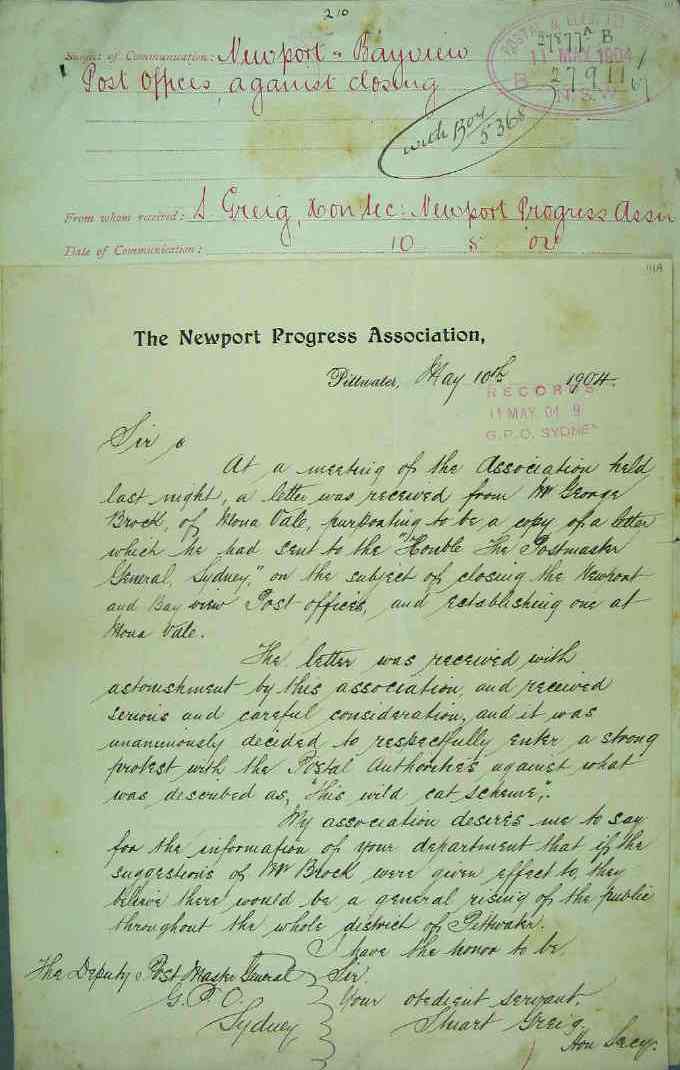
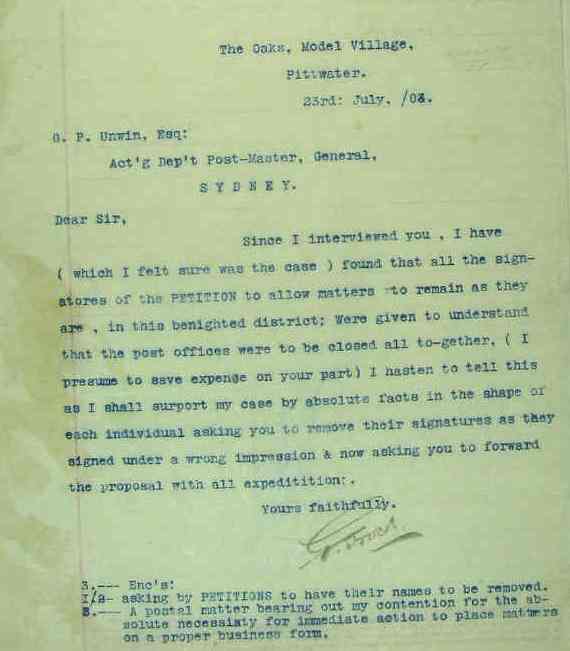
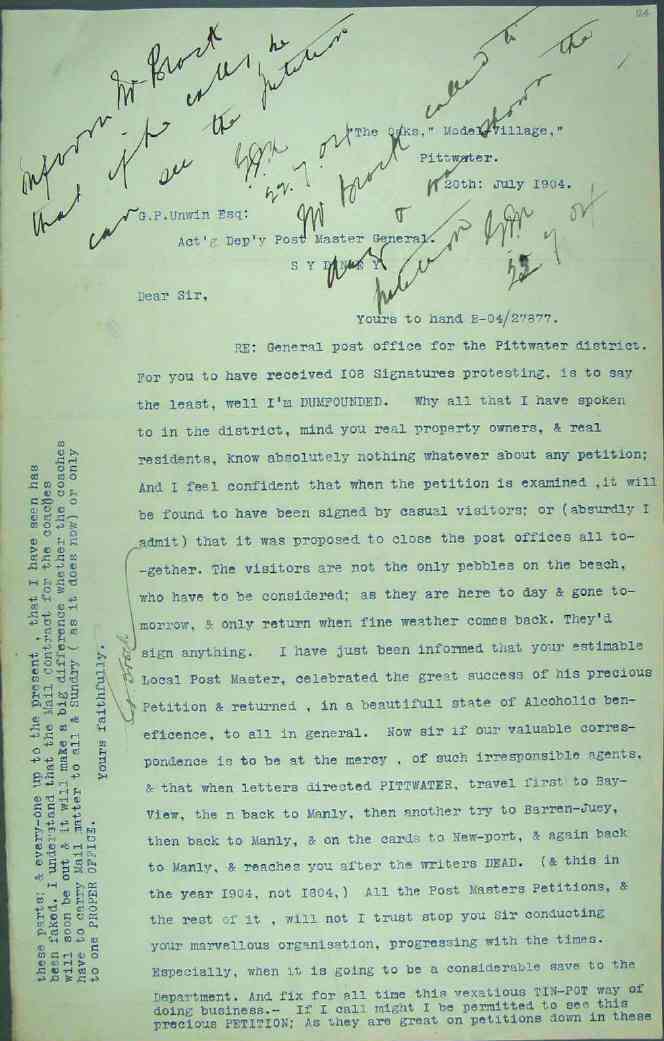
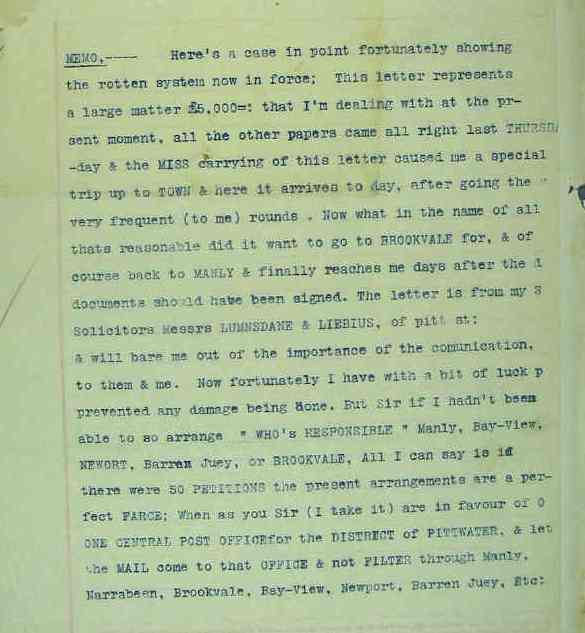
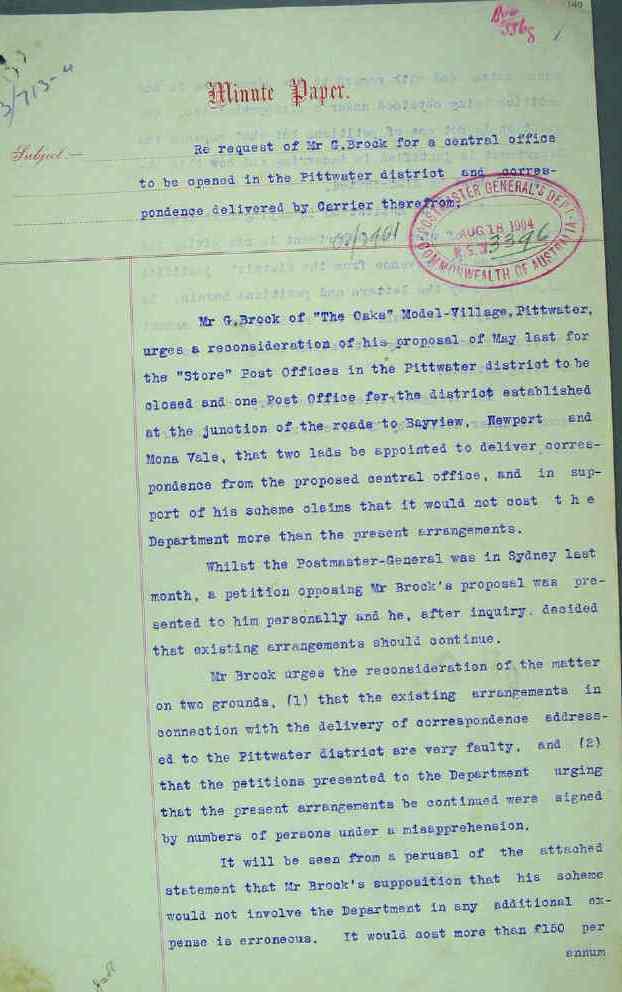
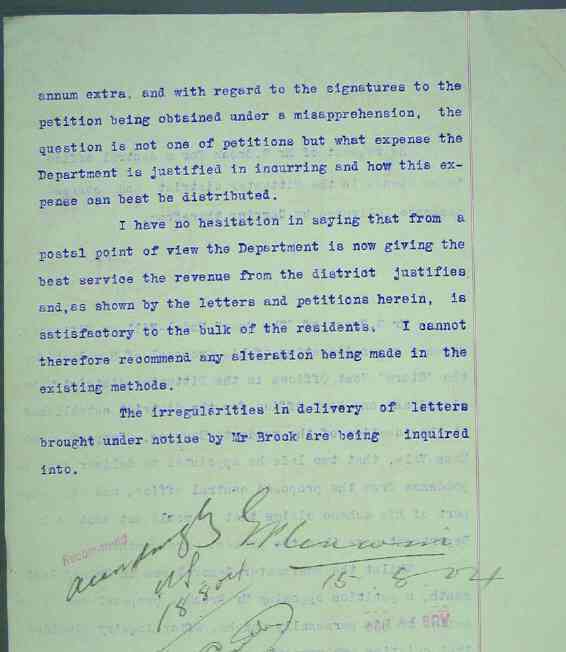
Although there was clearly a fair amount of construction work going on at Mona Vale the Brock's still spent time in town:
Miss Winifred Fraser invited a few of her friends to tea at Baumann's, on September 29. The hostess received her guests in the large room upstairs, where tea was served. Among those present were Mr. and Mrs. G. Brock, Mr. Oswell Brock, Mrs. J. Sanders, Miss Gair, Dr. and Mrs. Todd, Mrs. Pulsford, Miss Crossland, Miss Rose, Mr. Marr-Thompson, and others. SOCIAL ITEMS. (1905, October 7). Evening News (Sydney, NSW : 1869 - 1931), p. 10. Retrieved from http://nla.gov.au/nla.news-article113289463
A pleasant little gathering took place at the Hotel Australia on April 6, when a few of Mrs. A. J. Taylor's friends assembled to bid her "bon voyage," previous to her departure on a trip to England, with her mother, Mrs. J. R. Hill. The drawing-room was prettily decorated with flowers, and light refreshments were served, while a programme of music, arranged by Mrs. Kingsmill Shaw, was a pleasant feature of the afternoon. Among those who took part were the Misses Grace Fletcher, Florence White, Allen, Queenie Macdonell, and Saxe, and Mr. Philip Leslie, while amusing recitations were contributed by Miss Kate Gair and Mr. Oswell Brock. The hostesses included the Hon. Mrs. Pery, Mrs. Hughes, the Misses Winifred Fraser, Peden, Stewart, Smith, and Prince, while among the guests were Mrs. T. H. Kelly, Mr. and Mrs. F. W. Walker, Mr. and Miss Scroggie, Mr. H, de Y. Scroggie, Mrs. Cox, Mr. and the Misses O'Connor, Miss Bessie Major, Mr. Tedbar Johnson, Mr. and Mrs. Carter Pickford, Mr. and Mrs. F. Muller, Mr. Edgar Payne, Mrs. and Miss Hamilton Osborne, Captain and Mrs. Powell, Miss Hubard Smith, Mrs. and the Misses Banss, Dr. Palee. Mrs. W. Hill, Mr. and Mrs. Mason, the Misses King, Mr. Edmunds, Mr. and Mrs. R. Collins, Mrs. James Taylor, Miss L. Peden, Miss V. Moore, and others. Social News. (1906, April 11). Australian Town and Country Journal (Sydney, NSW : 1870 - 1907), p. 43. Retrieved from http://nla.gov.au/nla.news-article71529290
George Brock also brought his experience as an alderman in Newtown to the formation of Warringah Shire council. On March 7th 1906, the Warringah Shire was proclaimed by the NSW Government Gazette, along with 132 other new Shires. The new council's boundaries ran roughly from Broken Bay in the north to Manly Lagoon to the south, and by Middle Harbour Creek and Cowan Creek in the west. It covered 264 square kilometres (102 sq mi) and had a population of around 2800, with 700 dwellings. Under the Shires Act, ratepayers with properties worth at least five pounds could vote for six Councillors for a three-year term, two from each Riding.
Upon its establishment a temporary council of nominated representatives was installed by the State member for Middle Harbour Dr. Richard Arthur: George Alderton, of Frenchs Forest, George Brock, of 'The Oaks' Mona Vale, Thomas Gibbons, of Narrabeen, David Skene, of Brookvale, and Prof. Anderson, of Bayview (husband of Maybanke, who resigned on 9 June 1906 and was replaced by Herbert Sturman, of Mona Vale).
The first meeting of this temporary council took place in the Narrabeen Progress Association's Hall at 10 a.m. on June 14th 1906, with George Brock in the chair. Mr. Brock was already wondering how so many absentee landowners would 'have their say':
VOTING FOR SHIRE COUNCILS.
TO THE EDITOR OF THE HERALD.
Sir,-I have Just been notified of my appointment on the temporary council of Warringah, anticipating more kicks than halfpence during my sojourn on this temporary council. I'm much concerned at the absurd expectations at election time of the property owners turning up to vote; it's certain we'll find the gas-bag-agitator-kerosene-tin humpy much in evidence; but what about the absent owners of all this vast magnificent residential site, untouched and unimproved land, that is much in preponderance in this Warringah shire? It is clearly evident that voting by post is the fairest for all concerned. If it is good enough for the A.M.P. Society with £20,567,134 of funds to have all the control done by post voting, it should be likewise for all those interested in the welfare and progress of this fairest spot on the terrestrial globe. This blot in the Local Government (Shires) Act 1905 will be the Waterloo of its successful working. True the municipalities have personal voting at the ballot box. What do we find? Mostly representation by park-spouters and fire-brand agitators. Result, 99 out of the 100 councils up to their necks in debt, it being made so easy to fling about other people's rates collected. Post voting will obliterate the professional failure. I am, etc.,
G. BROCK.
Pittwater, May 22.
VOTING FOR SHIRE COUNCILS. (1906, May 23). The Sydney Morning Herald (NSW : 1842 - 1954), p. 4. Retrieved from http://nla.gov.au/nla.news-article14773898
The election of the first Warringah Shire Council took place on Saturday November 24th 1906, and the first meeting of the six elected councillors took place on December 3rd. The six councillors elected in November 1906 were:
LOCAL GOVERNMENT.
THE FIRST SHIRE COUNCIL ELECTIONS.
The first elections of councillors took place on Saturday, in the 134 shires created in N.S.W. under the new system of local government. Although the number may afterwards be increased to nine, each shire council is at first to consist of six numbers— two each from three ridings. Many of the returns to hand up to this morning were not complete, but as far as they have been received they are given, below: —
WARRINGAH.— A Riding: E. W. Quirk, J. Duffey. B Riding: A. Ralston. T. Fishbourne. C Riding: J. Hews, E. A. Holden.
LOCAL GOVERNMENT. (1906, November 26). Evening News (Sydney, NSW : 1869 - 1931), p. 6. Retrieved from http://nla.gov.au/nla.news-article115673717
The Post 'The Oaks' Years
After he lost The Oaks, taken and sold for a song by the mortgagees, the family lived at 'Aloha' Rushcutters Bay by November 1907 - as seen by the letter by daughter Viva from that same year.
In 1911 he lost his wife:
DEATHS BROCK.—February 7, at Aloha, Waverley-street, Bondi Junction, Charlotte Ellen, beloved wife of George Sydney Brock,aged 53 years. Family Notices (1911, February 8). The Sydney Morning Herald (NSW : 1842 - 1954), p. 10. Retrieved from http://nla.gov.au/nla.news-article15226607
In January 1912 the wonderful dream home he had spent so much time, energy and money realising was burnt:
BROCK'S MANSION BURNED.
BIG BLAZE AT MONA VALE. beautiful landmark destroyed.
Damage estimated at £12,000.
No fire- fighting appliances available.
"La Corniche," a mansion at Mona "Vale, which occupied a commanding position on the road between Manly and Newport, was destroyed by fire early this morning. Flames were discovered at 10 minutes to 1. At half-past 2 only portions of the walls, and they rickety, were standing.
The building was palatial In Its dimensions and appointments, and contained in all 38 rooms, 28 of which were bedrooms. It was originally designed for The Oaks Polo Club, and was built by Mr. G. S. Brock at a cost which has been set down at £32,000. Before the building was completed, however, it was acquired by Mr. Arthur Rickard, who brought It up to date and then let It to M. and Mme. Rainaud, at one time chef to Sir Harry Rawson. Instead of being used as a polo club it became a fashionable boardinghouse, and on account of its situation and its surroundings, including surfing and golf, it became exceedingly popular. There were 30 boarders in the place at the time of the fire.
The fire started in the large dining hall, and was discovered before it had a very strong hold of the room, but not in time to be beaten out. There was a hue and cry raised throughout the building, and boarders were running to and fro to ascertain the extent of, their danger and the possibilities of saving their effects. The flames spread with great rapidity, but happily not In the direction of the staircase, and many of the people were, therefore, able to dash about and get their property outside.
Those on the second and third floors, however, did not take the risk which running up and down the stairs involved, and threw most of their belongings out of the windows. In ten minutes the flames -had begun to light up the hills on either side, and to throw long reflections out to sea. The boarders were all out of the building by ' this .time, and the menfolk were assisting the staff (numbering 20) to remove the furniture. They continued in this until the flames drove them back, and were successful in getting out a piano and other big stuff. But What was saved was a mere fraction of what was lost.
All that the people could do was to stand by and watch. There was water— the sea could be heard roaring in to shore all the time — but there was no means of pumping it into the building. No fire-fighting appliances which would avail anything were kept on the premises, there is no depot in the vicinity, and though a boarder motored to Manly post haste and reported the blaze the firemen did not go out, because they could have done nothing if they had.
There were very few incidents in connection with the fire. Everybody was got out expeditiously, and though there were several cases where ladles fainted they were never in danger. Even the pets of the house were saved, though one had a narrow escape. It was a little white pussy, and it mewed and mewed pitifully on the window sill of a room from which smoke was already issuing. One of the girls attached to the staff saw its plight and darted into the building and out again with her charge in a few seconds.
Mr. Scott Fell, who has a house in the grounds of La Corniche, provided accommodation for the boarders for the rest of the night. As bad as the consequences were they might have been worse. If the blaze, for instance, had started nearer to tho stairway than it did, it is quite possible that the escape of the boarders would have been cut off, and the only exit would have been through the windows, a course . of action which would practically have endangered limbs if not life. Then, again, the wind was blowing out to sea. Had it blown from the sea, it Is not unlikely that two cottages and the Casino, nearer the roadway, would have gone, while the motor garage, where four motor-cars were kept, would almost certainly have been gutted.
The most remarkable circumstance in connection with the fire was associated with the telephone. When the blaze was found to be so serious Mr. A. Davis tore the 'phone from the wall and carried it outside. Later in the morning an electrician fitted it up on to the fence— the only piece of the fence which escaped tho flames— and a trial showed that though the wires had been through the heat of the flames, the 'phone was still in order, and the Manly exchange could be distinctly heard. The boarders relished the good fortune, because it enabled them to send reassuring messages to their friends.
Mr. Rickard stated this morning that the building and furniture was insured in the New Zealand Insurance Co. for £6000, and that he was therefore a fairly heavy loser, seeing that his estimate of the value of the building was £10,000. The furniture was valued at £2000. Mrs. Mueller (wife of Dr. Mueller, of Macquarie-street), Messrs. Harvey, A. Davis, Earle, Hermann, Toohey, L. A. and R. V. Minnett, Lotrois, and others of the boarders, were also sufferers by the fire. Mr. Rainaud lost silver, linen, &c., to the value of £250, which was uninsured.
The origin of the fire cannot he determined, but It is believed that It was caused by a lighted match or cigar butt carelessly thrown on to the carpet in the dining-room. Mrs. Rainaud heard a noise in the dining-room, which she attributed to burglars, and on getting out of bed found the place ablaze.
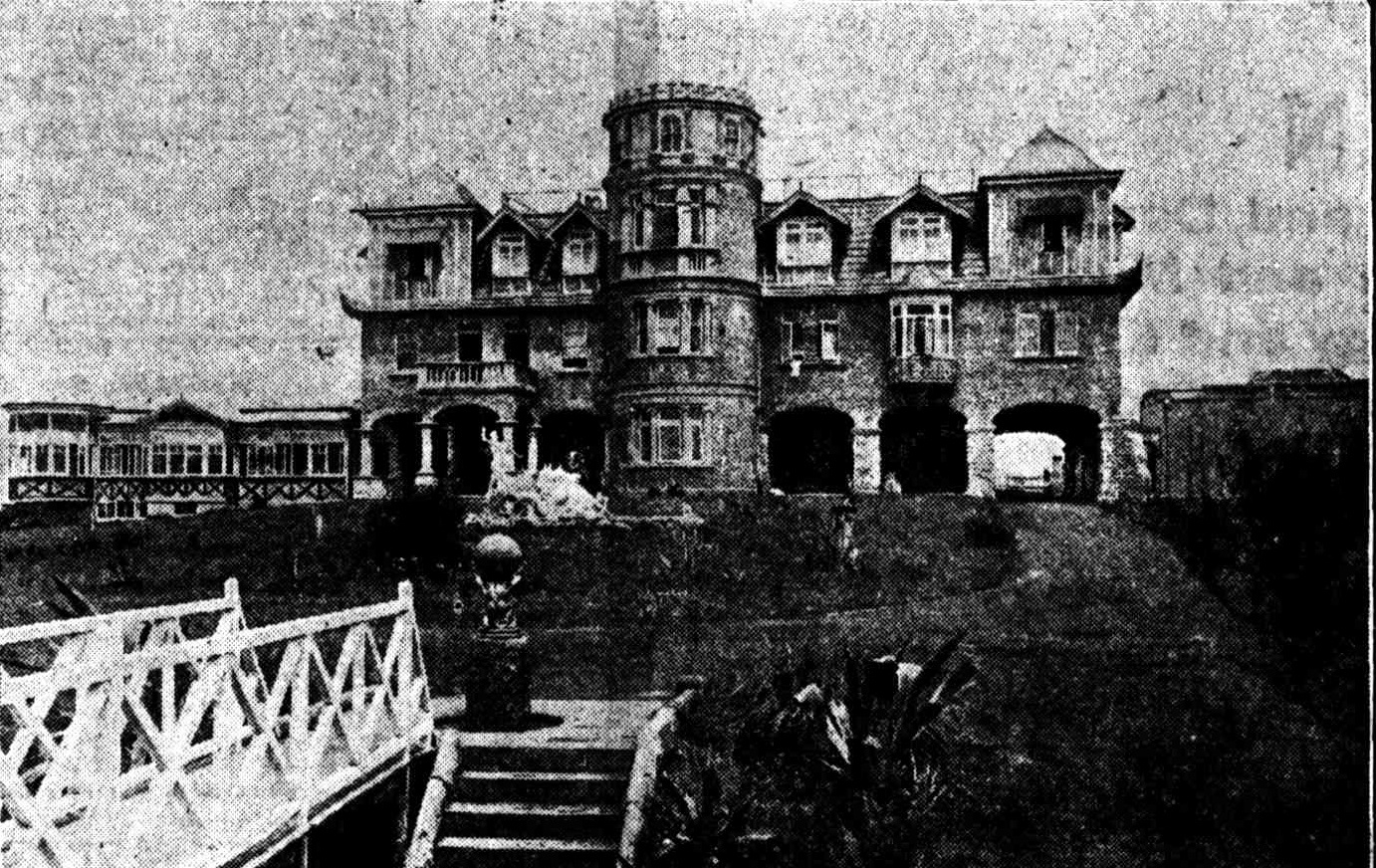
Mona Vale Hydro, the scene of a disastrous fire which occurred in the early hours of this morning. BROCK'S MANSION BURNED. (1912, January 8). The Sun (Sydney, NSW : 1910 - 1954), p. 1. Retrieved from http://nla.gov.au/nla.news-article222004219

Ruins of "Brock's Mansions," at Mona Vale, destroyed by fire on Monday morning. The fate of the handsome pile of buildings is a grim finale to the financial tragedy that overtook the plucky builder, Mr. G. S . Brock, in its erection. No title (1912, January 10 - Wednesday). The Sun (Sydney, NSW : 1910 - 1954), p. 1 (FINAL EXTRA). Retrieved from http://nla.gov.au/nla.news-article222002216
George Brock went west and worked - and although he is shown selling his polo ponies when he lost The Oaks, thankfully he was in a place where he could pursue his passion:
LAND VALUATION.
PORTLAND, Monday.
The valuation of the property In the urban area of Portland was recently made by the Blaxland shire valuer, Mr. G. S. Brock. The valuation has been doubled, and in some places, quadrupled In comparison with that made three years ago. COUNTRY NEWS. LAND VALUATION. (1913, June 11). The Sydney Morning Herald (NSW : 1842 - 1954), p. 16. Retrieved from http://nla.gov.au/nla.news-article15426350
POLO CLUB FOR LITHGOW
A meeting convened by Mr. G. S. Brock for the purpose of forming a polo team at Lithgow was held at the Club House Hotel last night. It was unanimously decided to form a club to be called the Bowenfels Polo Club, the necessary gear having been sent from Sydney, of which club Mr. Brock is one of two pioneer members.
Mr. Brock was appointed hon. secretary, Mr. J. L. Brown, patron, Ald. R. Pillans, president. and Messrs. Major Bracey, .T. A. S. Jones. A. C. Wright. T. W. Cohen, and A. J Brown, vice-presidents. It was decided that the players, Messrs. Brock, Pye, Walsh, iEather, and Jones, form the committee. Mr. Brock explained that Mr. J . L. Brown had kindly offered to allow the club to utilise any site on the Cooerwull Estate.Practice, commences on Saturday on a ground close to the factory. It is expected that matches will be played with Sydney team's, the match ground being situated opposite "Methven. '. POLO CLUB FOR LITHGOW. (1913, May 9). Lithgow Mercury (NSW : 1898 - 1954), p. 4. Retrieved from http://nla.gov.au/nla.news-article218665861
POLO AT BOWENFELS.
Mr. G. S. Brock, Hon. secretary, writes: — Bowenfels, Liddleton,and Vale of Clwydd met on Saturday on the new, graded ground at) Cooerwull, and the members not having all recovered from the vaccination boom it was decided by the captain to make up a scratch team of blues and whites. The blues were: — Ray Pye, back; .1. Finlayson, No. 2; -and Hull, No. 1 on a green (pony). The i whites were; — Brock, buck; Young, No. 2; and Oakey Park representative, No. 1.
The first chukka found Whites, on the now level ground, forcing the play, and soon the first goal was scored by Brock. The blues on the next throw off, with a brilliant run by Pye (on his new creamy), fairly made a run equal to match form, and scored a very fine goal. Brock with combination tactics forced the blues to their goal line, and gave an opening for Young to score several behinds. Second chukka: Pye was penalised for over-reaching his stick and Brock scored for the whites. Pye, showing some real fine polo, kept the whites going to save the goal, and, backed up by Finlayson (of Parrumatta), fairly ran away with the bull, the ground now favoring fast riding, and from a scrum, not a foot away from goal, scored. Third chukka: Too much standing over the ball and riding off tactics on both sides made the game slow for the onlookers. Honors were about equal. Fourth chukka: Play became fast. A duel between the two backs left- an opening for the Parramatta colt, and Finlayson dribbled a goal. The ponies wearied. Result: Blues, 3 goals 2 behinds; Whites, 2 goals, 5 behinds.
Miss R. Wright carried the colors of the club, dark blue and light blue stripes and the Whistle, combined with timekeeper,' Mr. Dawson (of Thelma yacht fame) R.S.Y.S. Mr. Wilson and Mr. Walsh assisting. The club coach left the club rooms at 2 p m with Mr. and Mrs. Dawson, of Sydney, also Miss Viva Brock, also on a visit to the fancy masquerade ball the night before. Misses Wright, Miss Cohen, Miss Bracey, and later Mr. and Mrs. Tartakover joined the party. From Mr. Wilson's trial spin it looks like as if he will be a first-class player. A polo dinner was held after the match at the Hotel Lansdowne, although alfresco, Host Baumashe was equal to the occasion. The Sydney visitors gave the polo chaps quite a musical treat, and expressed surprise amongst so much coal and iron, that polo was so much alive and had come to stay for sure.' Mr. Dawson, the member, of the R.S.Y.S. has presented the club with club ensign, dark and light blue stripes, and the club hopes to soon see it flying over their shelter kiosk. POLO AT BOWENFELS. (1913, August 4). Lithgow Mercury (NSW : 1898 - 1954), p. 2. Retrieved from http://nla.gov.au/nla.news-article218661453
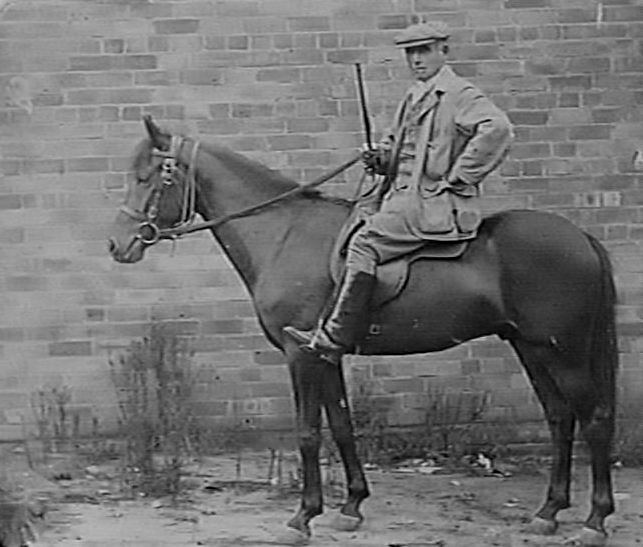
George on one of his polo ponies - photo courtesy Dodds family
BREVITIES. Mr. G. S. Brock advertises in this issue The Newbold siding subdivision, Marrangaroo. BREVITIES. (1913, August 4). Lithgow Mercury (NSW : 1898 - 1954), p. 2. Retrieved from http://nla.gov.au/nla.news-article218661489
In 1914 their daughter Dorothy marries and as can be read, George is still in Lithgow:
WESTCOTT—BROCK.—August 8, 1914, at St. Mary's Church of England, Waverley, by Rev. J. N. Manning, M.A., LL.D., Walter Clarke, second son of G. H. Westcott, of Ashfield, to Dorothy Marjory eldest daughter of G. S. Brock, of Lithgow. Family Notices (1914, September 12). The Sydney Morning Herald (NSW : 1842 - 1954), p. 12. Retrieved from http://nla.gov.au/nla.news-article15563365
LICENSES.
At the Lithgow police court on Tuesday an auctioneer's license was granted to George Sidney Brock, of Lithgow. LICENSES. (1914, December 2). Lithgow Mercury (NSW : 1898 - 1954), p. 2. Retrieved from http://nla.gov.au/nla.news-article218669427
MUNICIPAL AND SHIRE APPEAL COURT
APPORTIONMENT AND ASSESSMENT OF LOCAL COAL MINES. VALUERS BURNS AND BROCK IN THE RING.
Under the Local Government Act a coal or shale mine may be assessed either on the average annual, output or on the unimproved capital value of the land. The local mines have been assessed on the average annual output since 1889, but trouble has arisen this year — when the triennial valuation was due —between ' the Blaxland Shire Council and the Lithgow Council as to how the mines should be assessed and the apportionment of the rates so obtained. All the associated collieries in Lithgow are partly situated in the' shire area and partly within the municipality — with the exception of the Ironworks Tunnel. But though the shafts, machinery, and so on are all within the municipality, the greater part of the surface area is in the shire. The respective valuers (Messrs. K. Burns and G. S. Brock) failed to agree as to the apportionment of the rates, which led to a recommendation on the part of the Blaxland Shire valuer that the assessment should be on the surface area, which would mean that the shire would reap much more in rates than has hitherto been the ease. On the other hand the local valuer contended that the assessment should remain as heretofore. Neither was able to adjust the matter, and the P.M., sitting as a municipal and shire court, considered the question at the Lithgow courthouse on Tuesday morning. Mr. K M. Mitchell, of Sydney, instructed by Mr. T. F. Thompson, appeared for the Council, while the Mayor (Aid. R. Pillans), Mr. T. Evans (town clerk) and air. E. Barns (valuer) were also present. The Blaxland Shire was represented by its solicitor (Mr. E. P. Richards), while the engineer (Mr. B. A. Heffernan), the clerk (Mr. A J. Ash-down), and the valuer (Mr. G. S. Brock) were also in court. ... MUNICIPAL AND SHIRE APPEAL COURT (1913, November 19). Lithgow Mercury (NSW : 1898 - 1954), p. 2. Retrieved from http://nla.gov.au/nla.news-article218658457
In 1916 Oswell Carl Brock marries Lucy Victoria Garling, daughter of Arthur Crawford Garling and Anne Rushby. Interestingly, paintings he was getting copyrighted that year, show his studio as 'Aloha', the name of the premises where the family had moved to and where they were when his mother had passed away just a few years earlier. The couple had a son, John Brock:
3581. Oswell Carl Brock, Aloha Studio, Victoria Chambers, 44 Castlereagh-street, Sydney, New South Wales.—Painting:—"Belgium." Belgian girl, part of the set of six representing the Allies. 16th December, 1915.
3582. Oswell Carl Brock, Aloha Studio, Victoria Chambers, 44 Castlereagh-street, Sydney, New South Wales.—Painting:—" Italy." Italian girl, part of the set of six representing the Allies. 16th December, 1915.
3583. Oswell Carl Brock, Aloha Studio, Victoria Chambers, 44 Castlereagh-street, Sydney, New South Wales.—Painting:—" Japan." Japanese girl, part of the set of six representing the Allies. 16th December, 1915.
3584. Oswell Carl Brock, Aloha Studio, Victoria Chambers, 44 Castlereagh-street, Sydney, New South Wales.—Painting:—"Russia." Russian girl, part of the set of six representing the Allies. 16th December, 1915.
3585. Oswell Carl Brock, Aloha Studio, Victoria Chambers, 44 Castlereagh-street, Sydney, New South Wales.—Painting:—"England." English girl, part of the set of six representing the Allies. 16th December, 1915.
3586. Oswell Carl Brock, Aloha Studio, Victoria Chambers, 44 Castlereagh-street, Sydney, New South Wales.—Painting:—"France." French girl, part of the set of six representing the Allies. 16th December, 1915. PROCEEDINGS UNDER THE COPYRIGHT ACT 1912. (1916, January 20). Commonwealth of Australia Gazette (National : 1901 - 1973), p. 105. Retrieved from http://nla.gov.au/nla.news-article232467614
The theft of Brock property continues:
Paddington.—Stolen, between the hours of 3 p.m. and 6 p.m. the 3rd instant, from the residence of Oswell Brock, Springfield, O’Sullivan-road, Bellevue Hill,—A gold half-moon brooch with two rose leaves and a rose bud thereon, set with about thirty pearls, small diamonds set in bud; plain gold bar-brooch, set with a peal; a lady’s rolled gold keyless wristlet watch, No. 472485, “14, 15, and 16 and A.J.S.” scratched inside back case. Also stolen, same time and place, the property of Ethel Walsh,—A lady’s open-face silver keyless Geneva watch, No. 338250 “14, 16, and 16” inside back case; a gold brooch, heart shape, with leaves, set in pearls; gold bar-broocli, set with a ruby; gold bell pin; and a fine gold neck-chain; total value, £9 10s. ldentifiable. Suspicion attached to two men First about 26 years of age, 5 feet 7 or 8 inches high, medium build, fair complexion, clean shaved; dressed in a grey tweed sac suit and grey soft-felt hat with black band. Second—about 30 years of age, 5 feet 8 inches high, stout build, full fat face, wearing a straw hat; both wore “R.S.A.” badges. Can be identified. Burglaries, etc. (1918, May 8). New South Wales Police Gazette and Weekly Record of Crime (Sydney : 1860 - 1930), p. 211. Retrieved from http://nla.gov.au/nla.news-article251745458
A highly fanciful Smiths Weekly record keeps the name G S Brock in the news:
BROCK OF BROCK'S BEACH
The following, from "Smith's Weekly," will be read with interest by Lithgowites: "The author of the well-known structure on the Newport Road, north of Sydney, built a decade and a half -ahead of his time.
The motor makes the place an ideal "country club" site, but Brock built before the motor, had been heard of. He has always had notions of his own on the subject of architecture. His original house was built on the lines of a ship. He put in portholes instead of windows and armchairs which played 'God Save the King' when you sat down, on them. He also put in Larry Foley majolica mantelpiece. Nobody ever knew why Larry Foley got the mantelpiece. Nobody ever know why Brock took it away from him. Brock is a great sportsman, and is the essence of hospitality. He has always had a passion for the sea, and this passion was once nearly the end of him. He put off from the beach in a dingy, and was caught in a gale. He was blown many Ieagues to the north, and was ready to go out to it, when by chance he was picked up. He was a great polo player, and is still a stylish quail shot. BROCK OF BROCK'S BEACH (1921, January 31). Lithgow Mercury (NSW : 1898 - 1954), p. 2. Retrieved from http://nla.gov.au/nla.news-article219261547
In June 1921 Viva marries:
MARRIAGES.
DODDS-BROCK.-June 23, at St Andrew's Cathedral, by Rev. Canon Charlton. Edward Hindmarsh, eldest son, of Mr. and Mrs. Leonard Dodds. Green Meadows, VIidemere, to Viva, younger daughter of Mr. George Brock and the late Mrs. Brock, of Mona Vale. Family Notices (1921, July 13). The Sydney Morning Herald (NSW : 1842 - 1954), p. 12. Retrieved from http://nla.gov.au/nla.news-article28087438
WEDDINGS.
DODDS— BROCK.
An interesting and pretty wedding was celebrated on Juno 28 at St. Andrew's Cathedral, between Viva, youngest daughter of Mr. George Brock, Narrandora, N.S.W., and Edward Hindmarsh, eldest son of Mr. and Mrs, Leonard Dodds, of Green Meadows, Widemere. Canon Charlton performod the wedding ceremony. The bride, who was given away by her father, wore a pretty dress of very pale pink taffeta, trimmed with lace. An old family veil of Limerick lace was worn with a tiny wreath of orange blossoms. Her shower bouquet was composed of white sweet peas and carnations. Miss Doris Litchfield was bridesmaid, and wore a maize satin gown, her lace hat having long gold streamers. She carried a shower bouquet of Iceland poppies. Captain Clive Fitzhardinge, M.C., was best man.
The wedding breakfast was held at the Waratah Cafe, Mr. and Mrs. Leonard Dodds being host and hostess. Their guests Included Mr. and Mrs. Alfred Lee, the Misses Lee, Mrs. W. H. Corbould, Miss Evelyn Corbould, Mr. George Brock, Mr. H. M. Somer, Mr. L. Hopkins, Mrs. Metcalfe Jackson, Mr. Arthur Dodds, Mr. Harry Dodds, Mr. and Mrs. Westcott, Mr. and Mrs. C. Brock, Mr. and Mrs. Herbert Thompson, Mr. and Mrs. Houghton Bradley, Mrs. Randle, and Dr. George Bell. The bridegroom was flight-lieutenant In the Royal Air Force, having seen service In East Africa, Palestine, and Salonika. WEDDINGS. (1921, July 2). The Daily Telegraph (Sydney, NSW : 1883 - 1930), p. 15. Retrieved from http://nla.gov.au/nla.news-article239753960
A CITY WEDDING
Very jolly speeches marked the dinner given at the Waratah Cafe after the wedding of Miss Viva Brock and Mr. Edward Dodds on Tuesday evening. Canon Charlton, who conducted the service at St. Andrew's Cathedral, presided, and three old friends— the bridegroom's father, Mr. Livingstone Hopkins and Mr. H. M. Somer — vastly amused the company with their stories against each other. The bride is the second daughter of Mr. George Brock, formerly of Mona Vale, and the bridegroom the eldest son of Mr. and Mrs. Leonard Dodds, of Green Meadows, Wentworthville. The bridal gown was of pale pink satin with an overdress of lace, the whole being covered with a very long tulle veil that fell from a small wreath of orange blossom'. Miss Doris Litchfield, as bridesmaid, wore a dress of pale lemon chanrieus and a white net hat. The bridegroom, who was in the A.F.C., and the best man, Lieut. Clive Fitzhardinge, M.C., wore their uniforms. A CITY WEDDING (1921, July 3). Sunday Times (Sydney, NSW : 1895 - 1930), p. 17. Retrieved from http://nla.gov.au/nla.news-article123245863
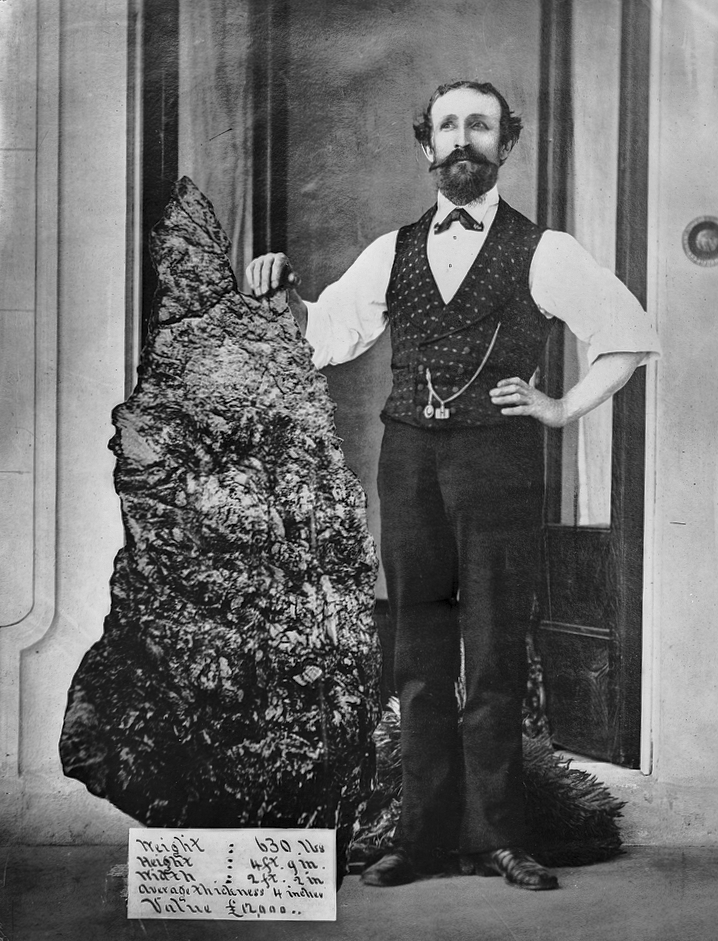
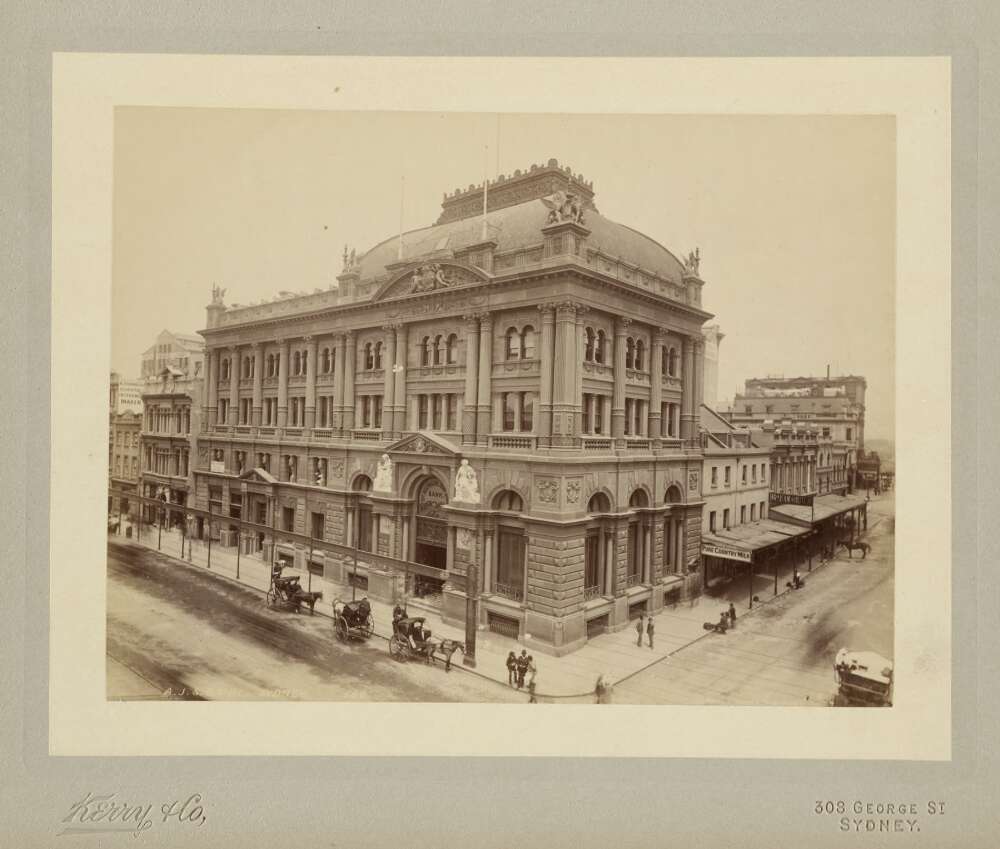
BROCK.—November 15, 1933, at Sydney, George S. Brock, late of 61 Wellbank-street, North Strathfield. Privately interred Waverley Cemetery, 16th inst. Family Notices (1933, November 17). The Sydney Morning Herald (NSW : 1842 - 1954), p. 10. Retrieved from http://nla.gov.au/nla.news-article17024923
Viva Dodds formerly Brock
Born 1891 in Newtown, Sydney. Daughter of George Sydney Brock and Charlotte Ellen (Davis) Brock.
Sister of Oswell Carl Brock, Dorothy Marjorie (Brock) Westcott and Victor Brock.
Wife of Edward Hindmarsh Dodds — married 1921 in Sydney.
Mother of Elizabeth M Dodds, Leonard Hindmarsh Dodds and Dorothy Winifred Dodds.
Viva was aged 82 years when she died in 1974 - late of Parramatta, formerly McMasters Beach Gosford.
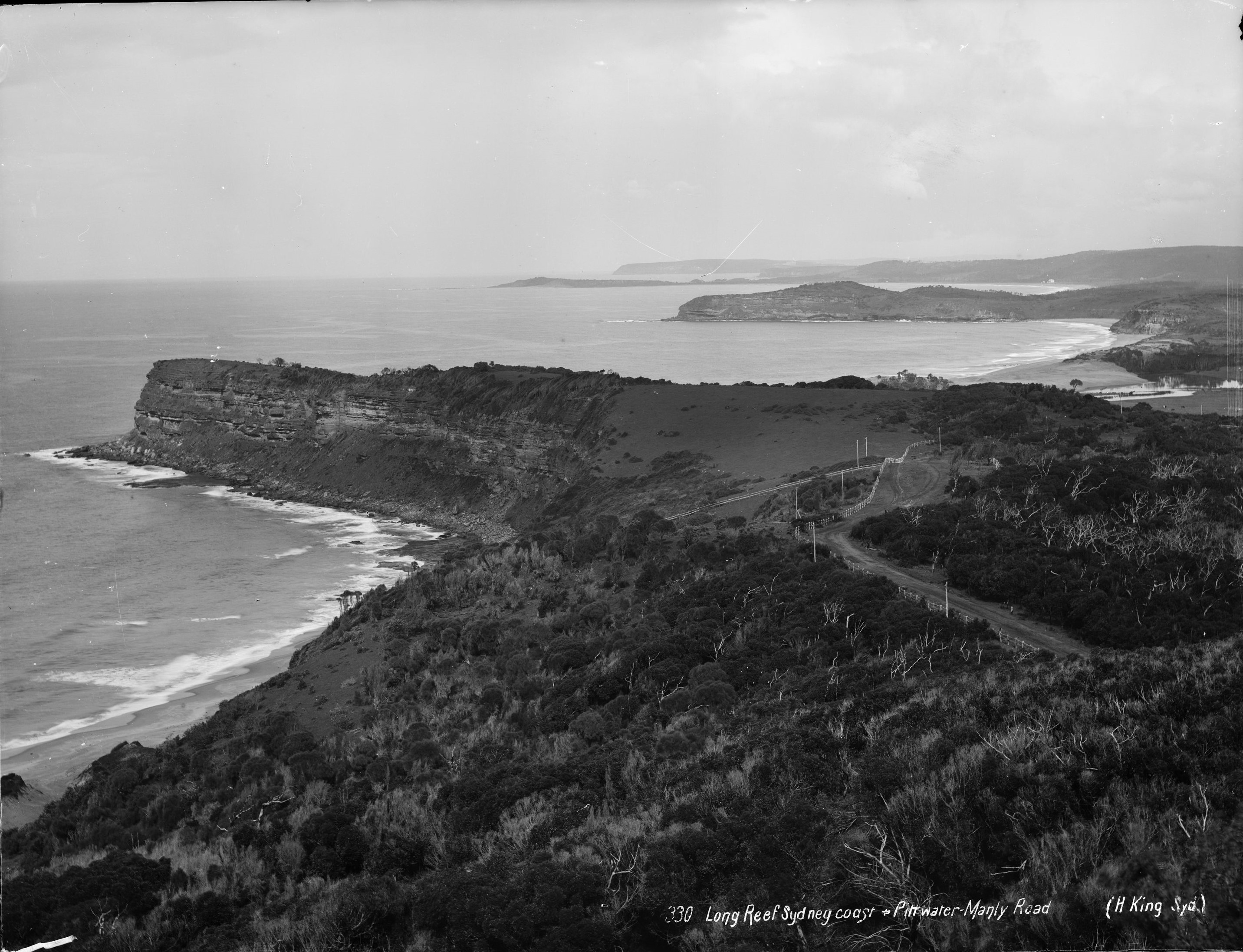
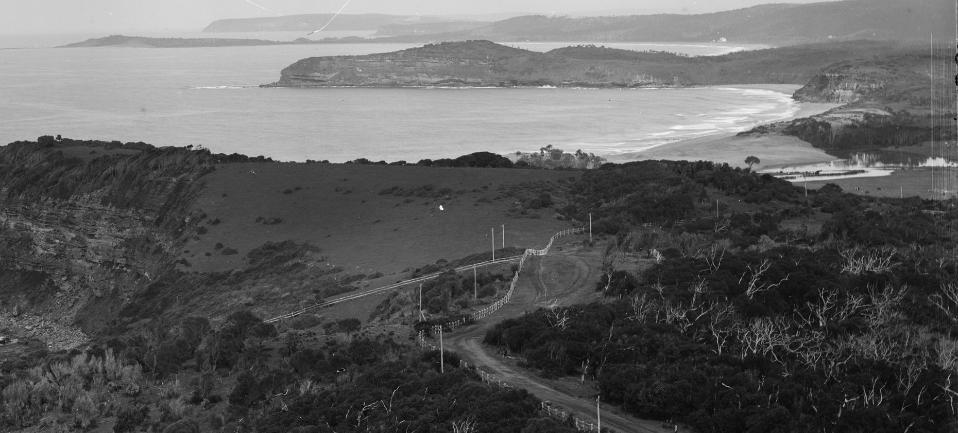
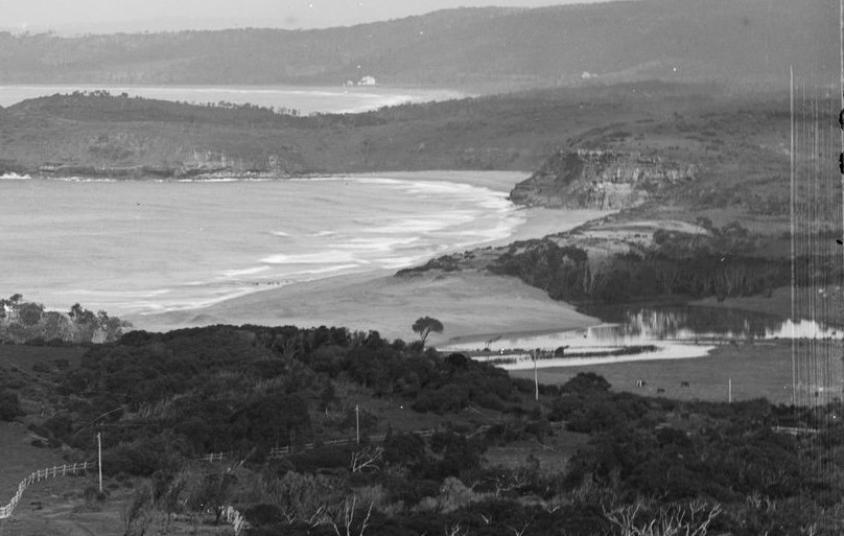
The Oaks - La Corniche - threads collected by A J Guesdon, 2011.